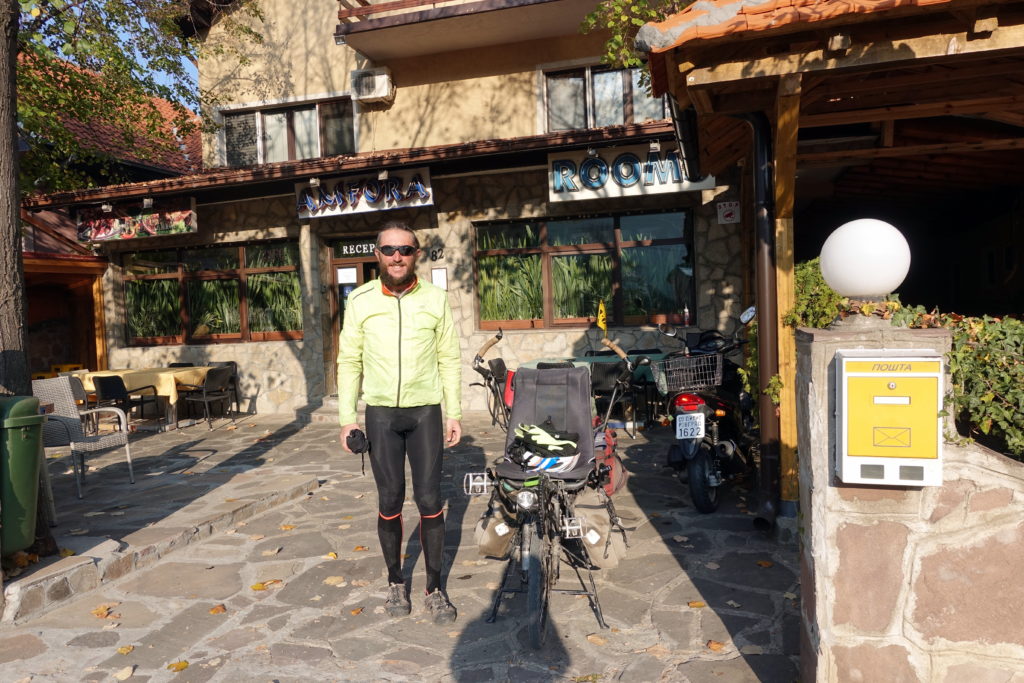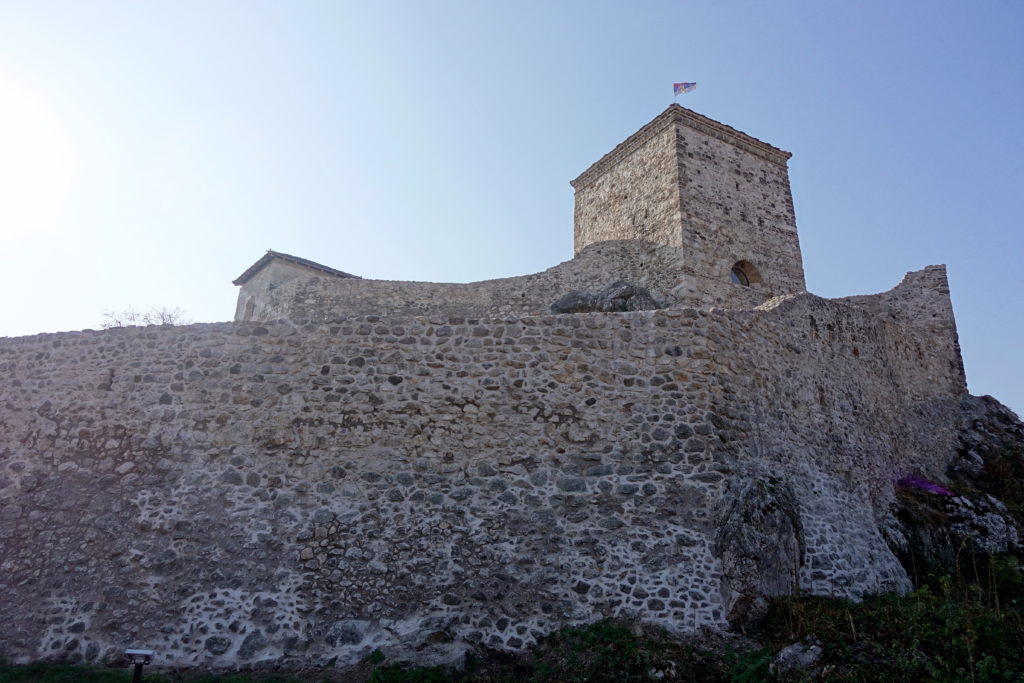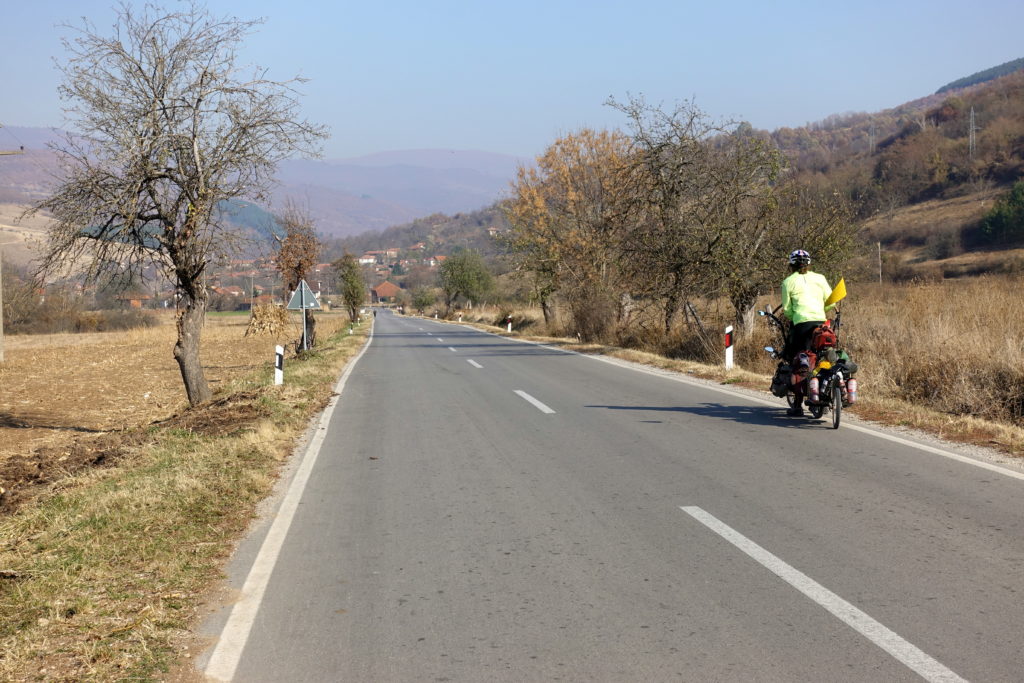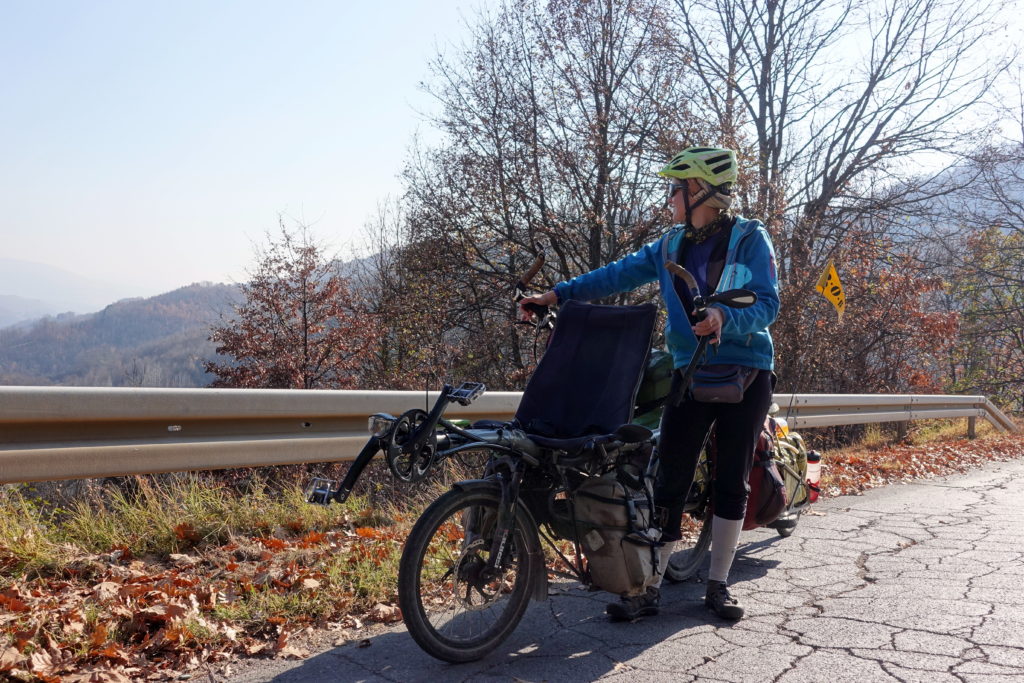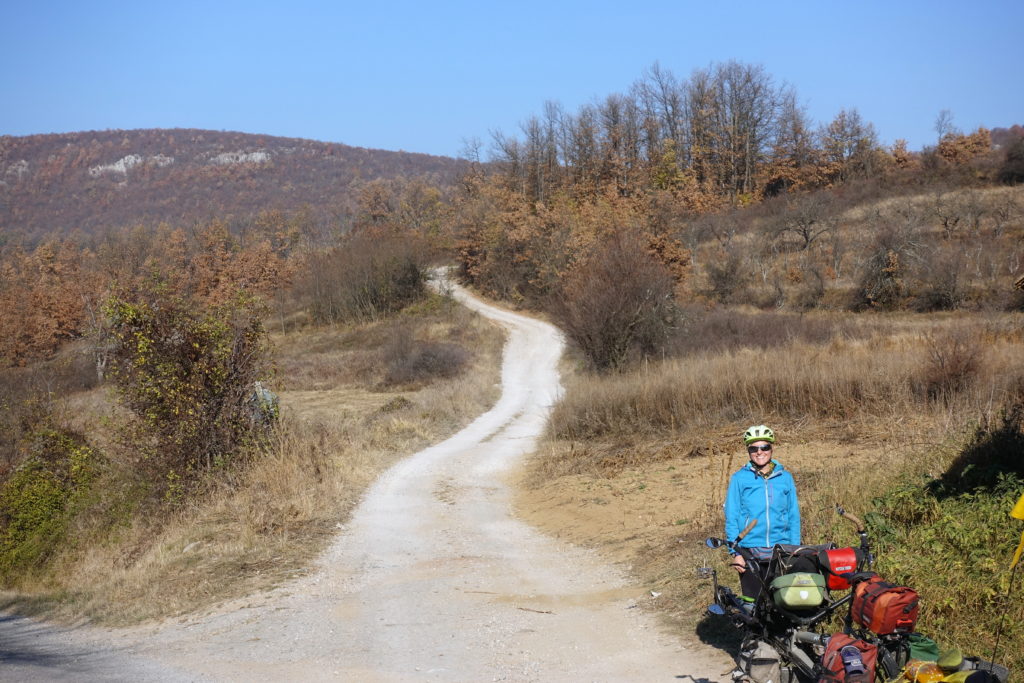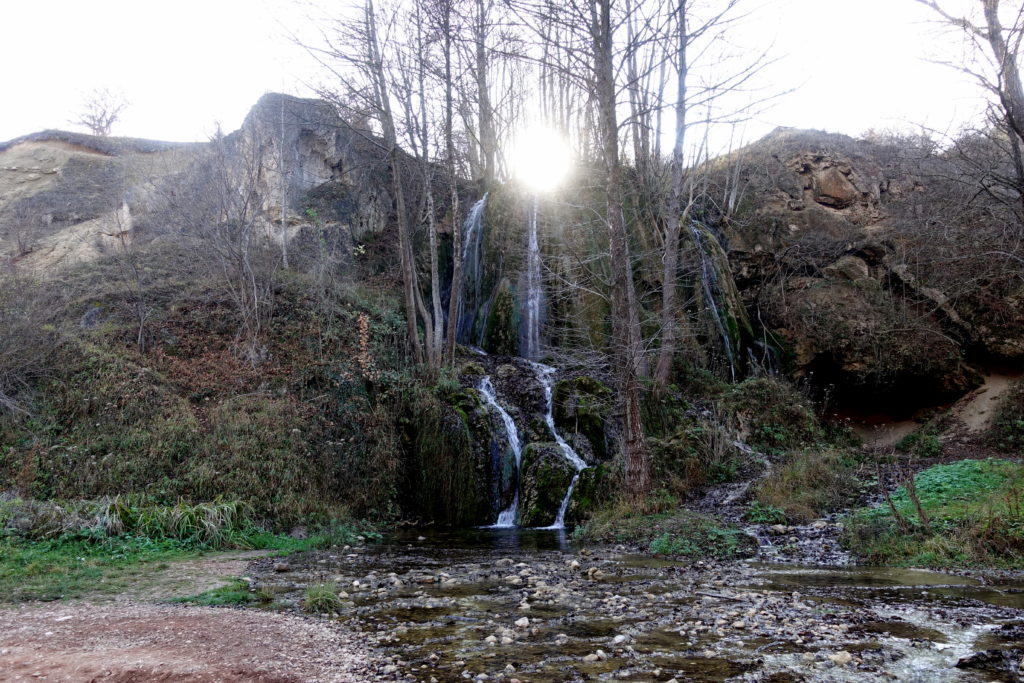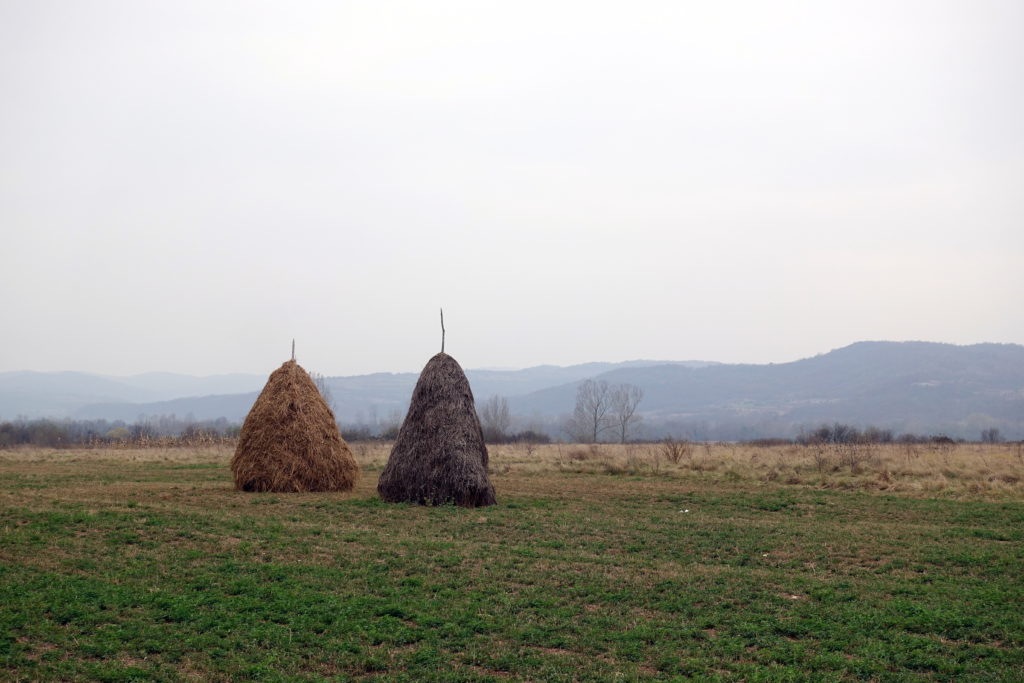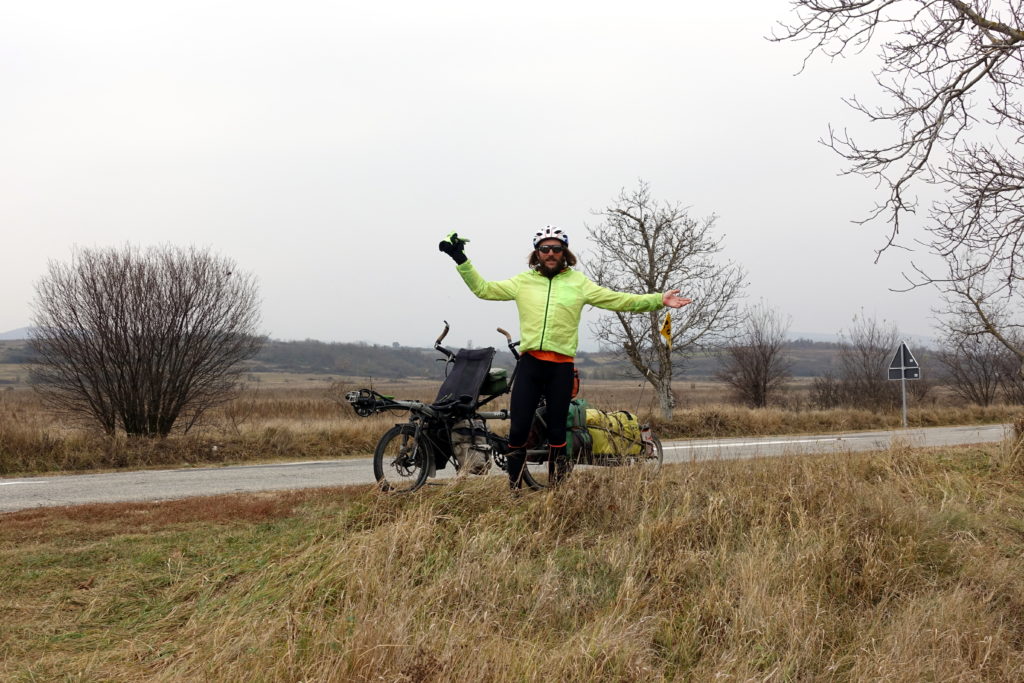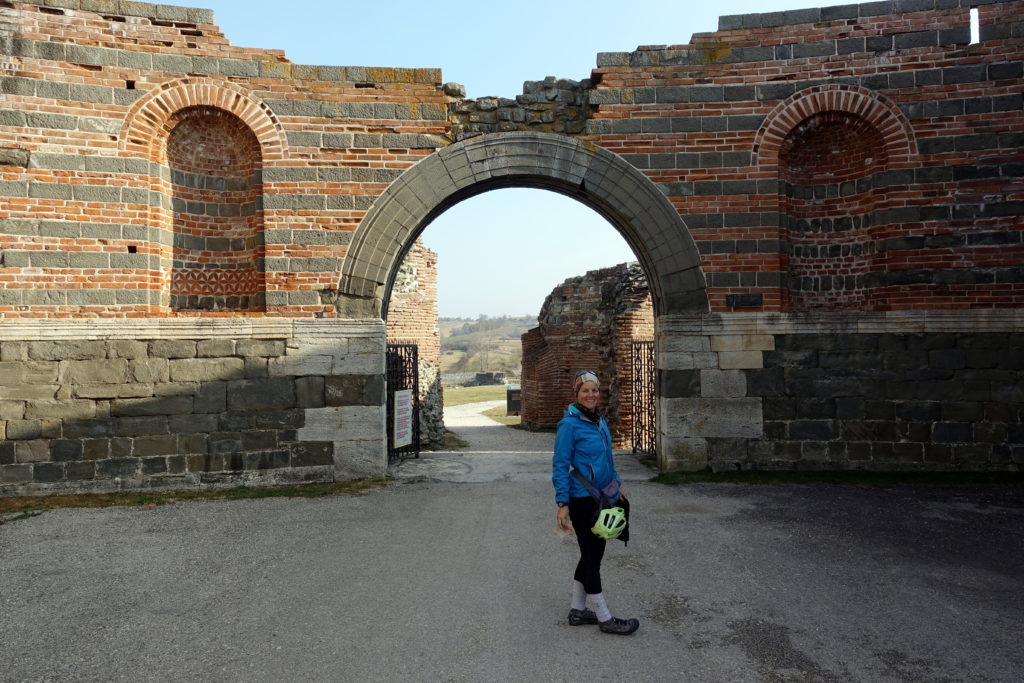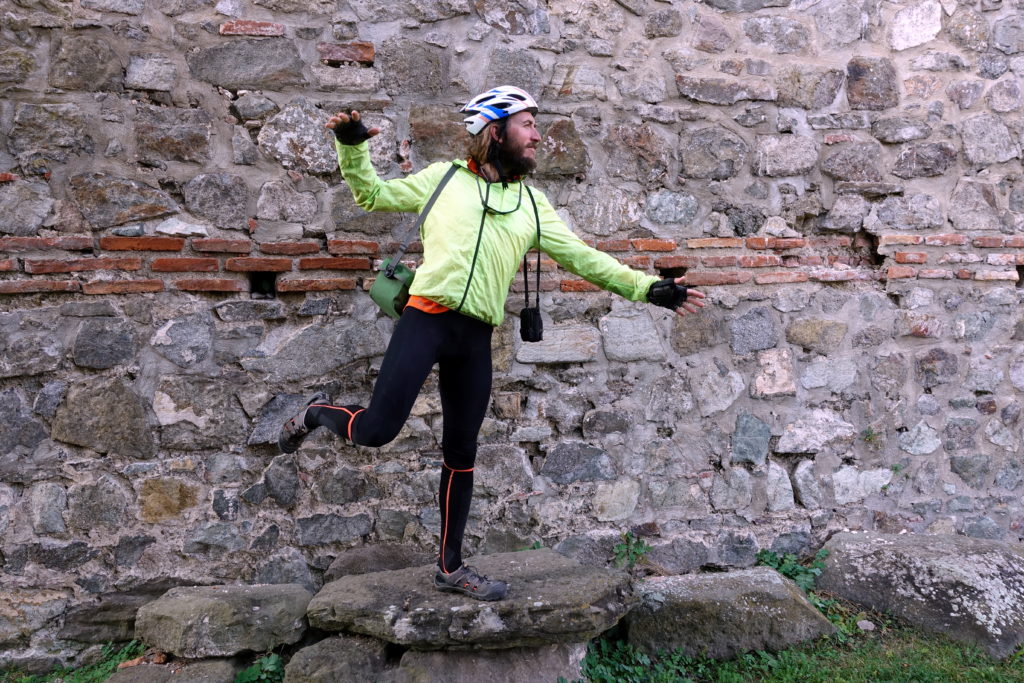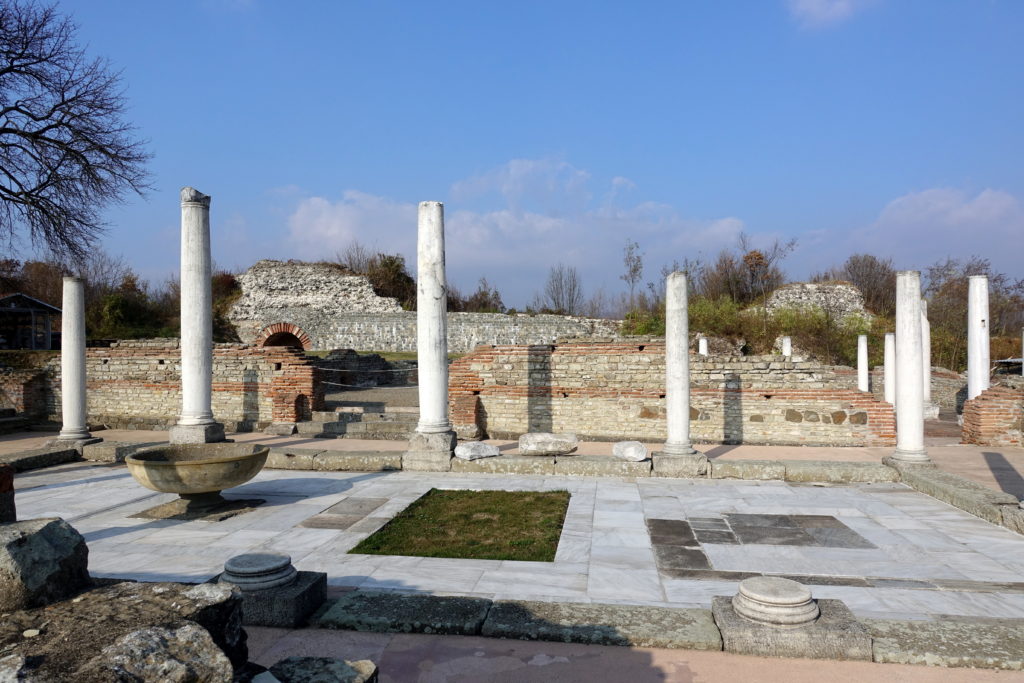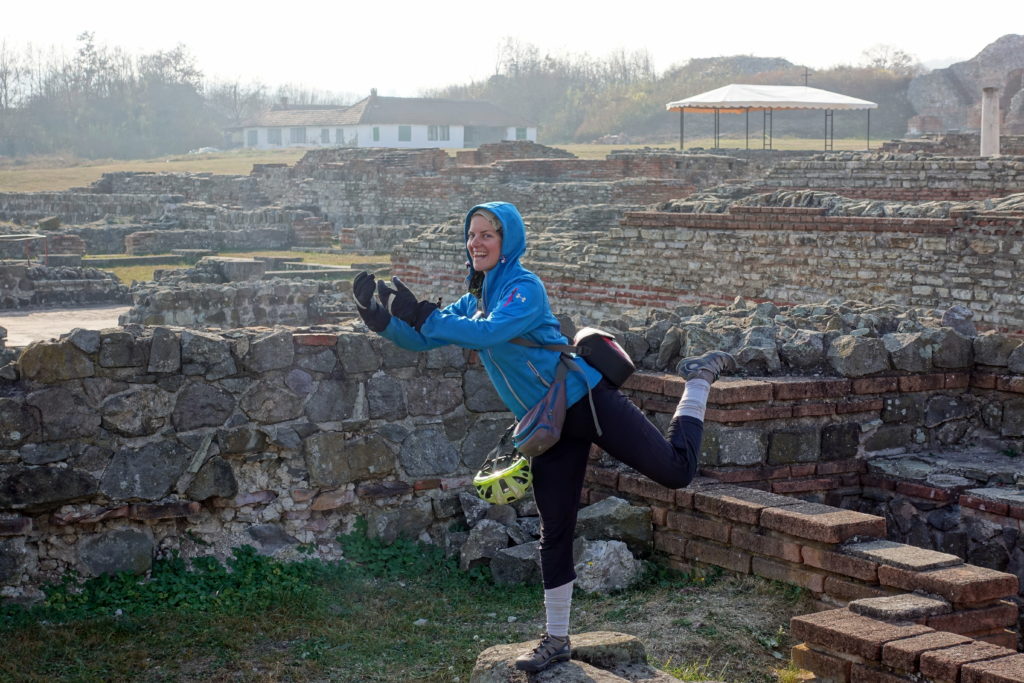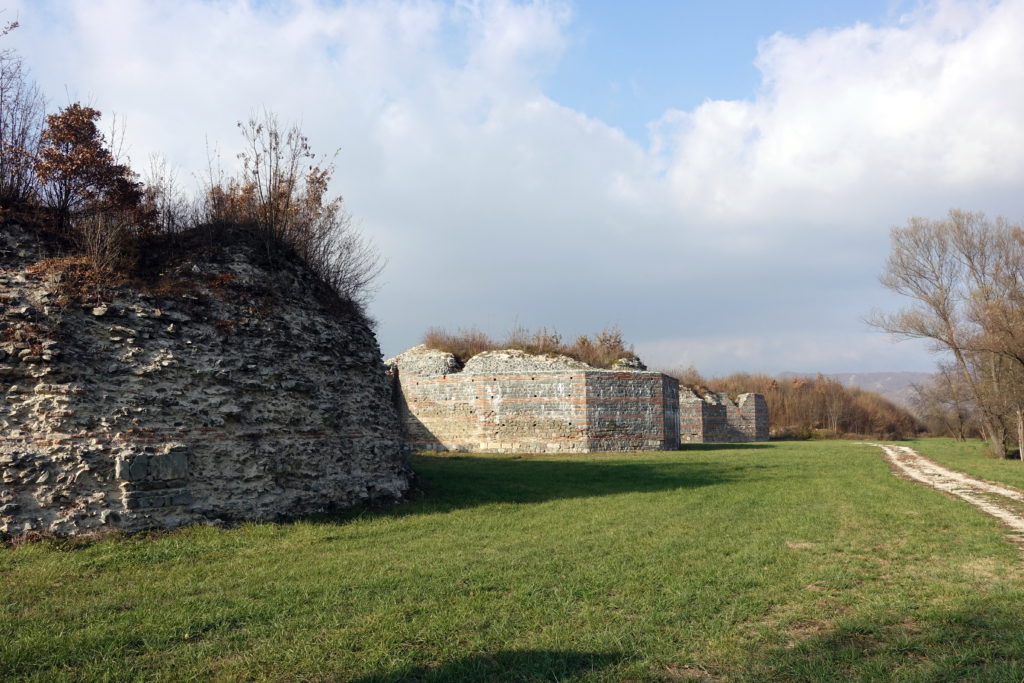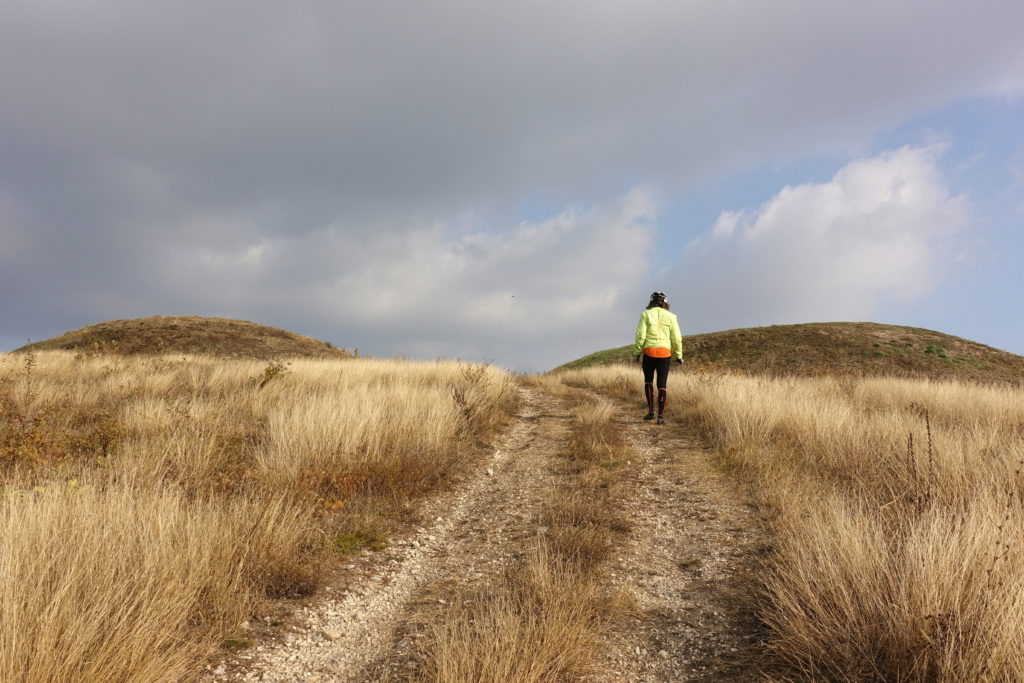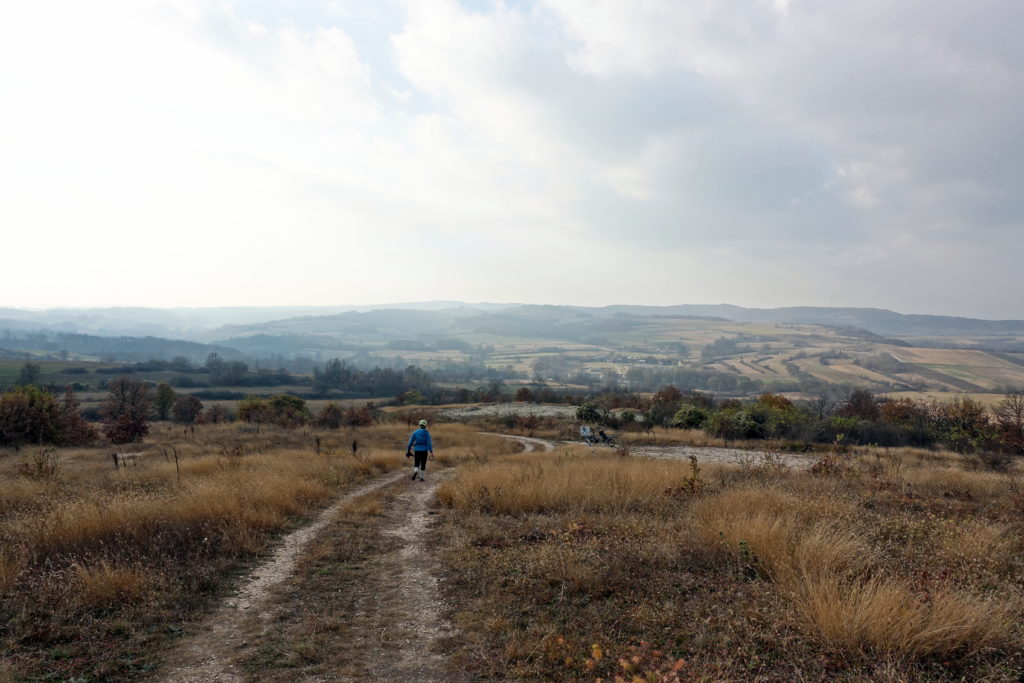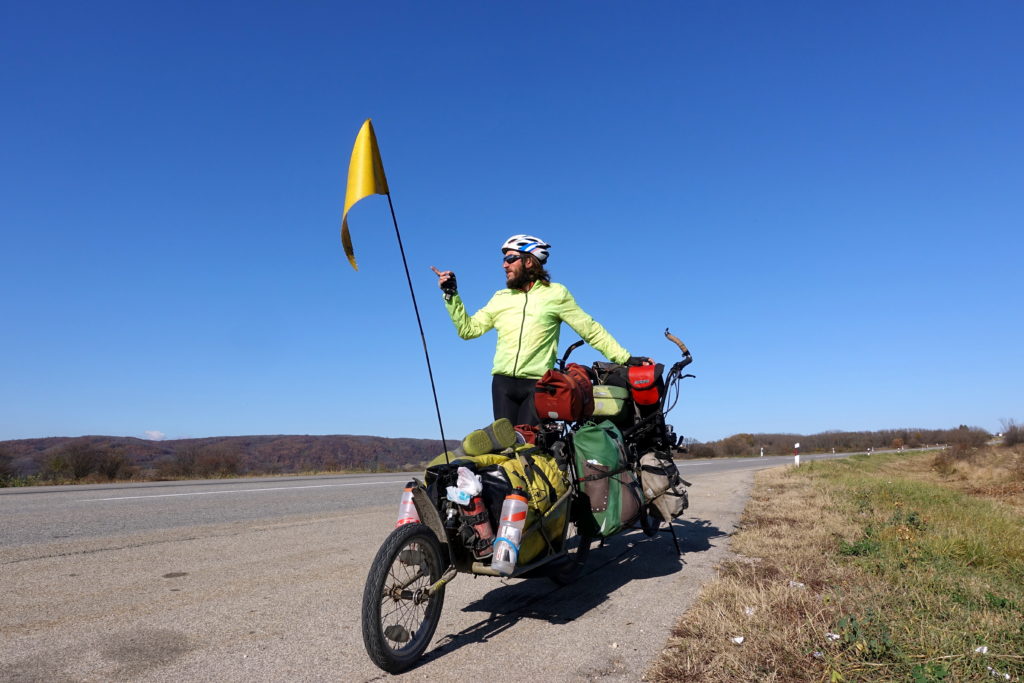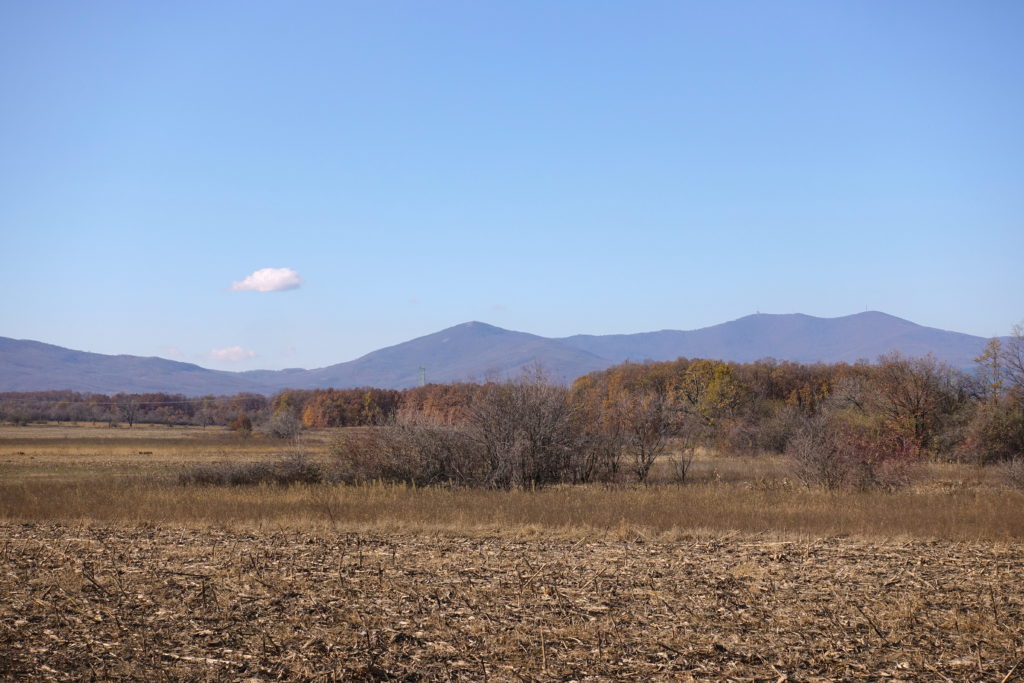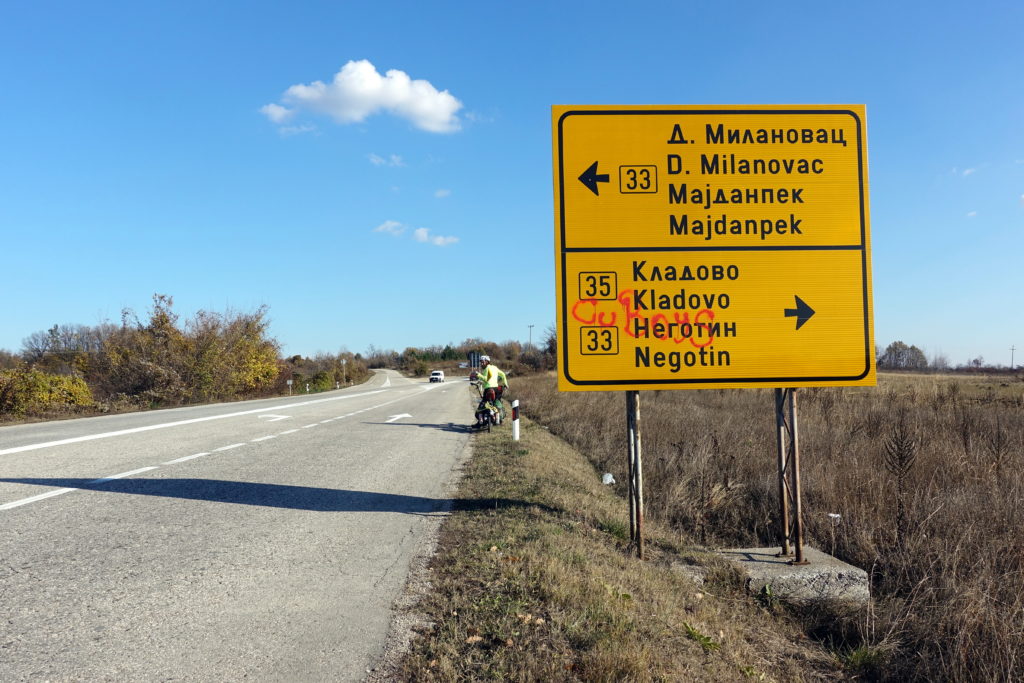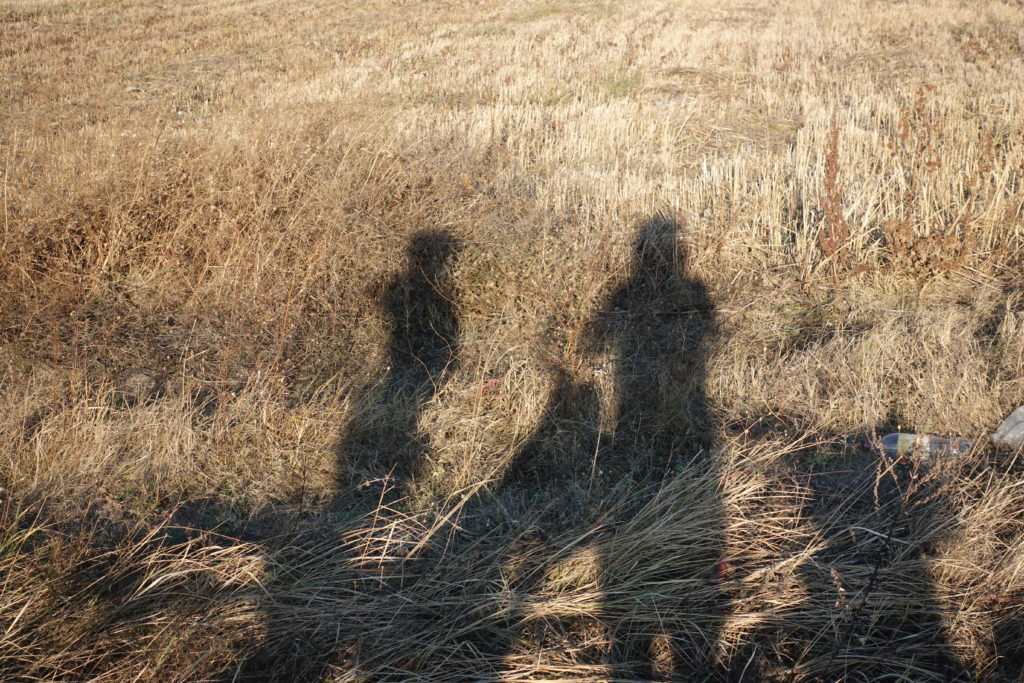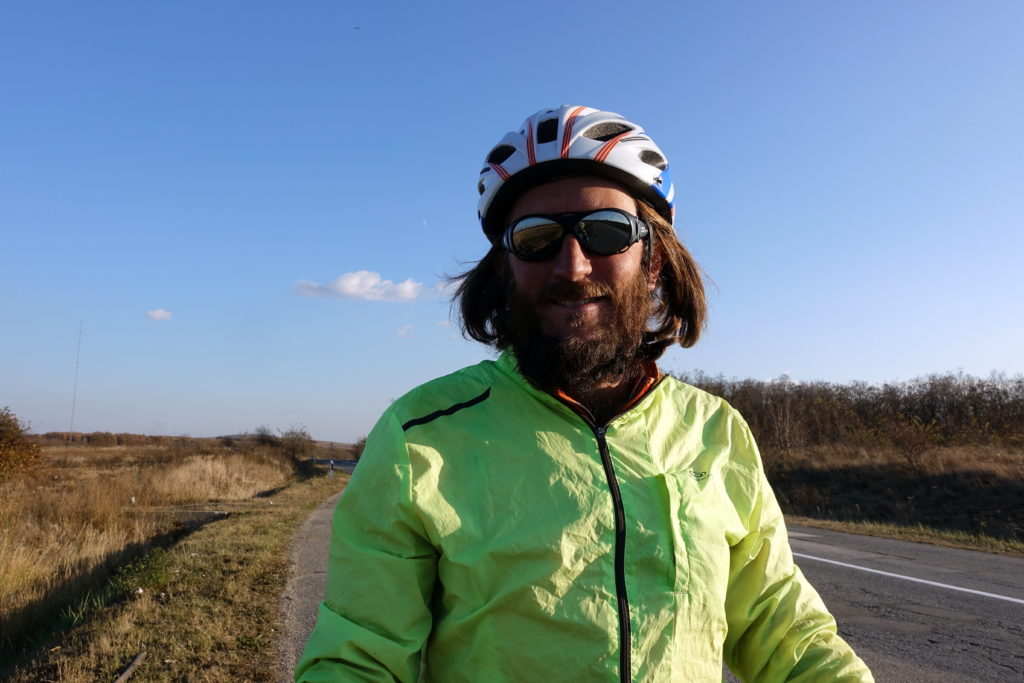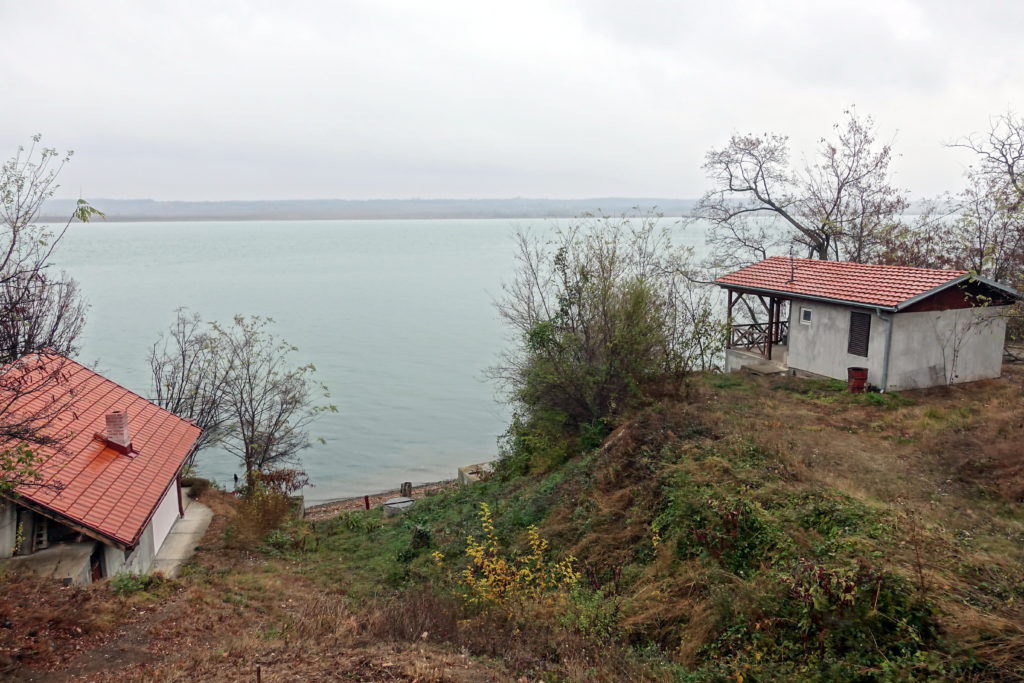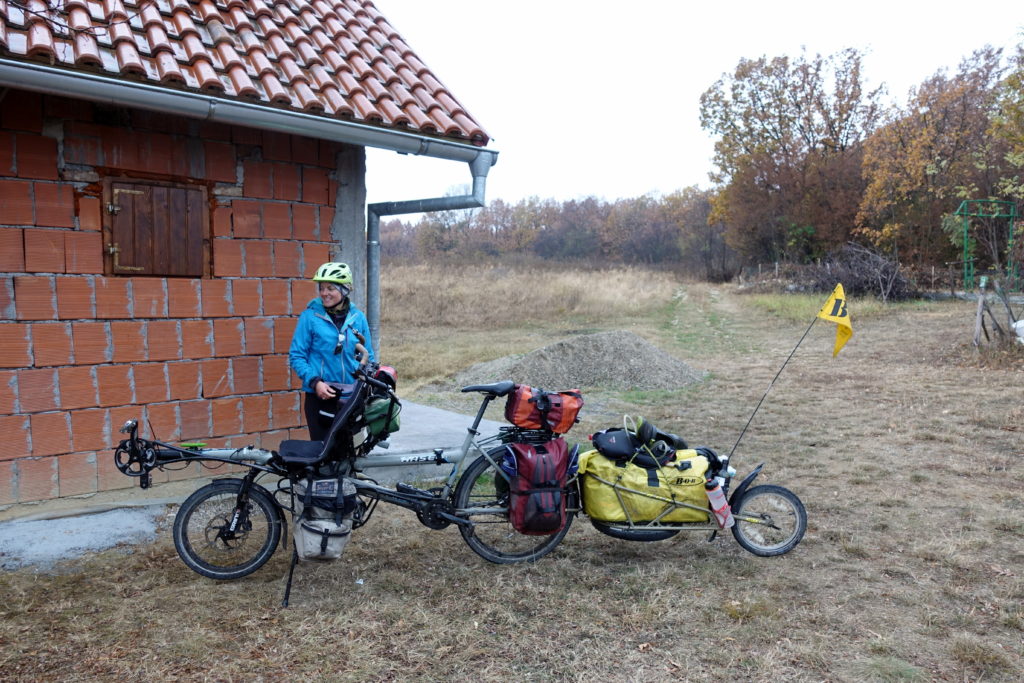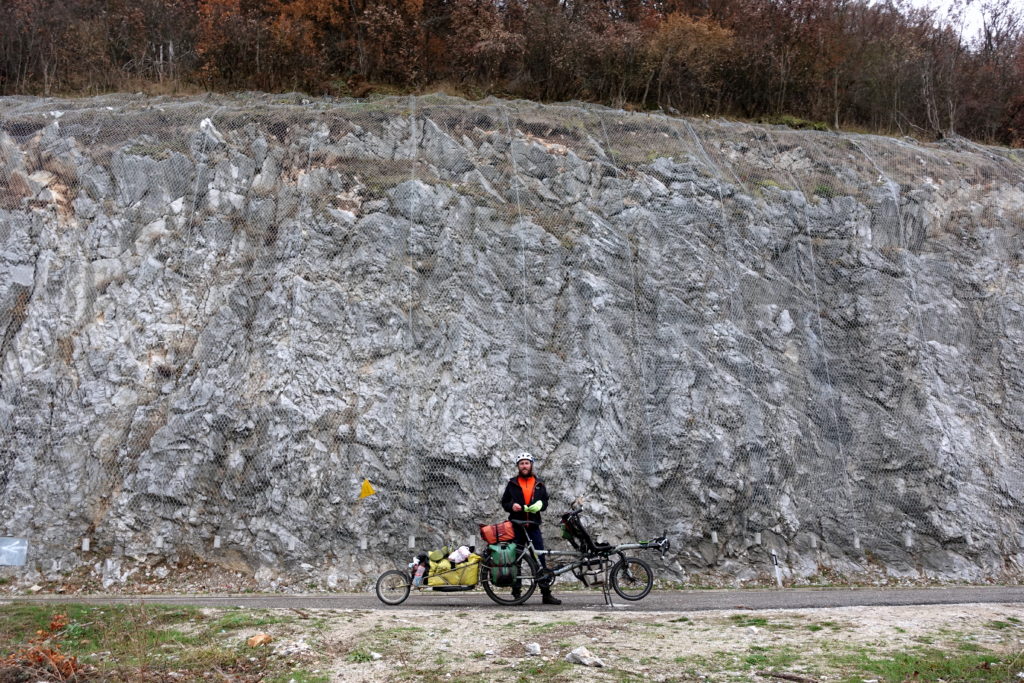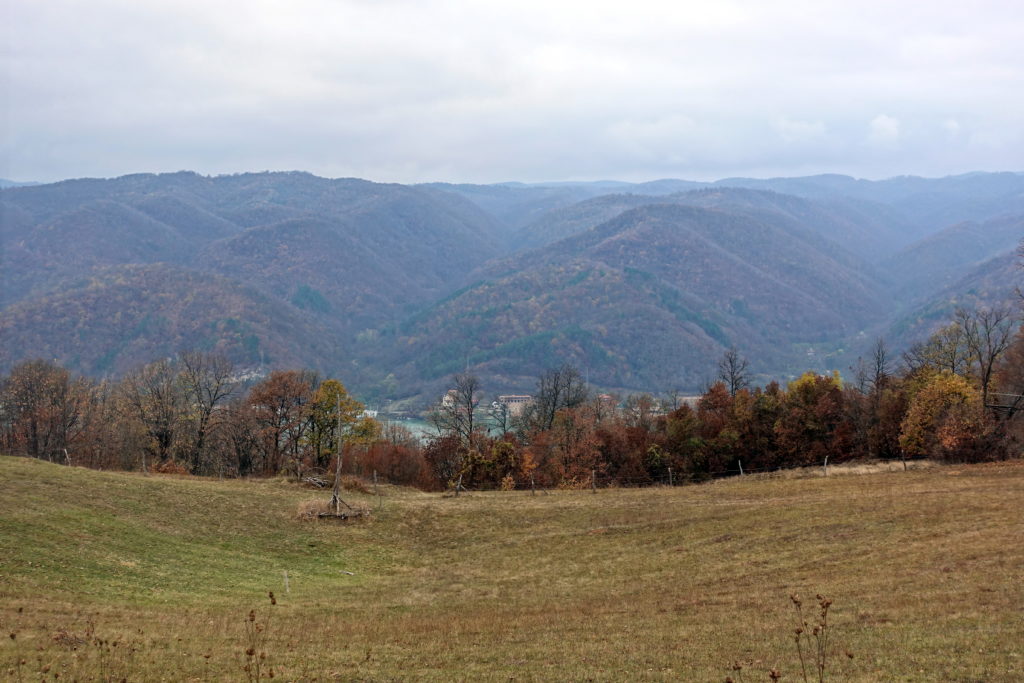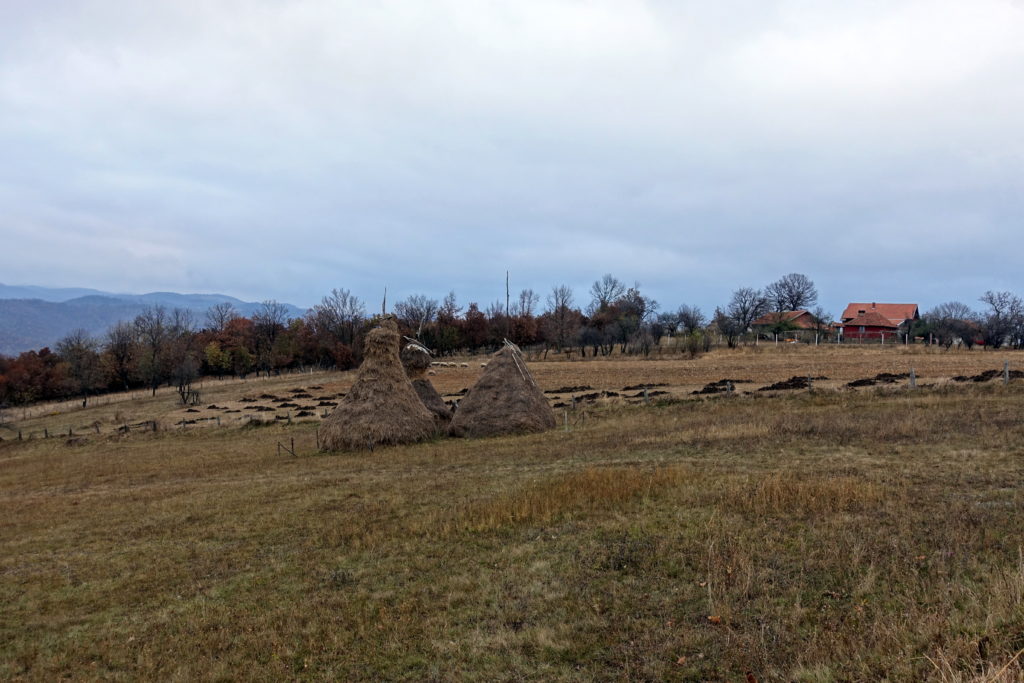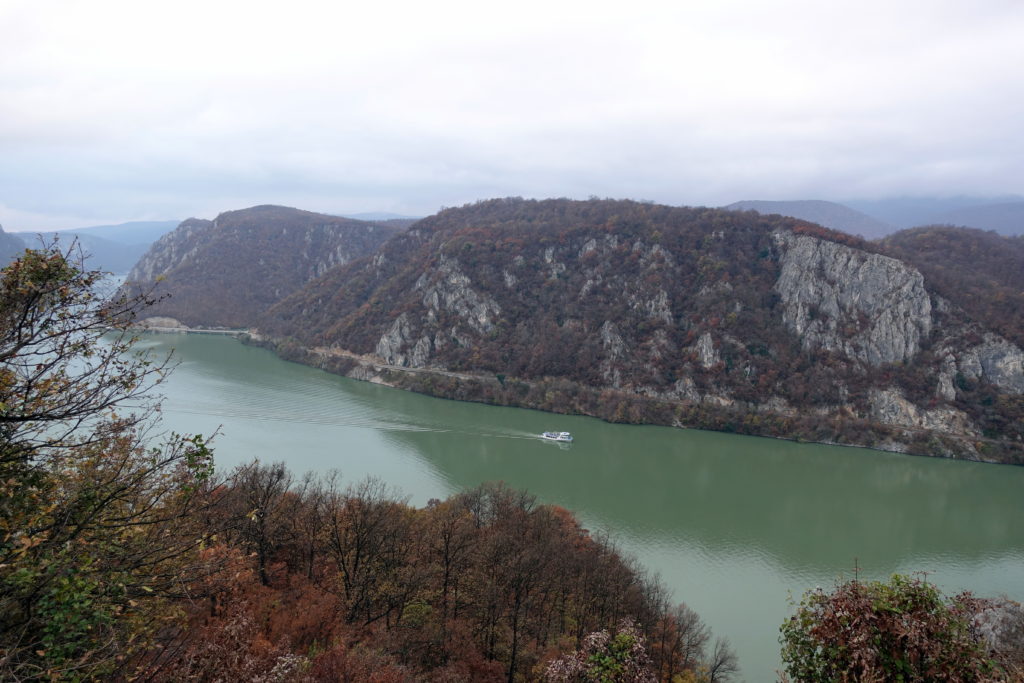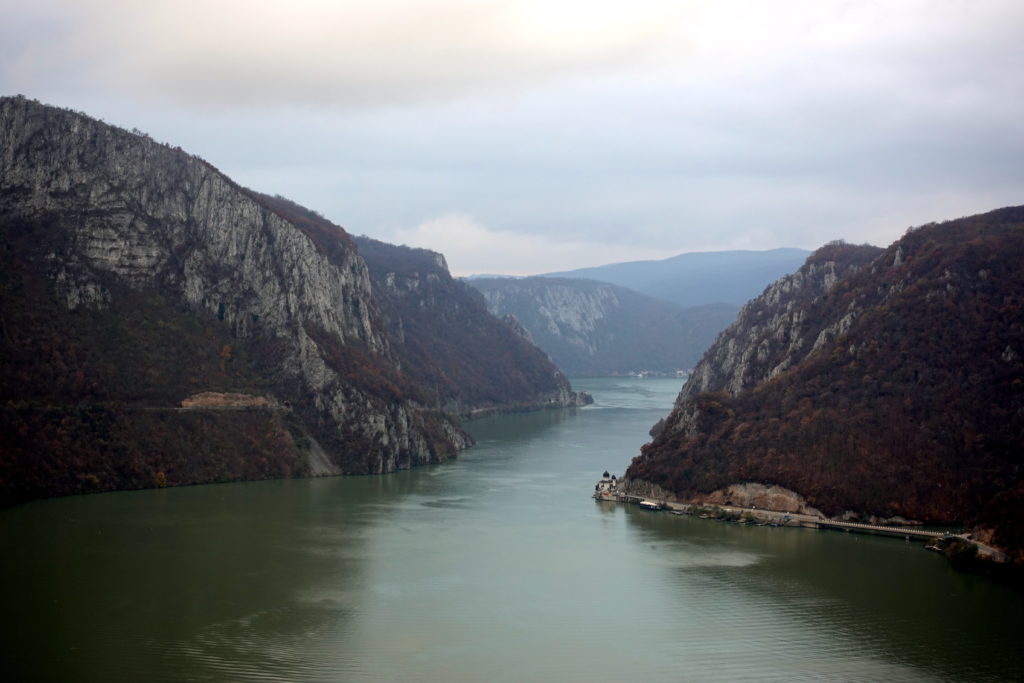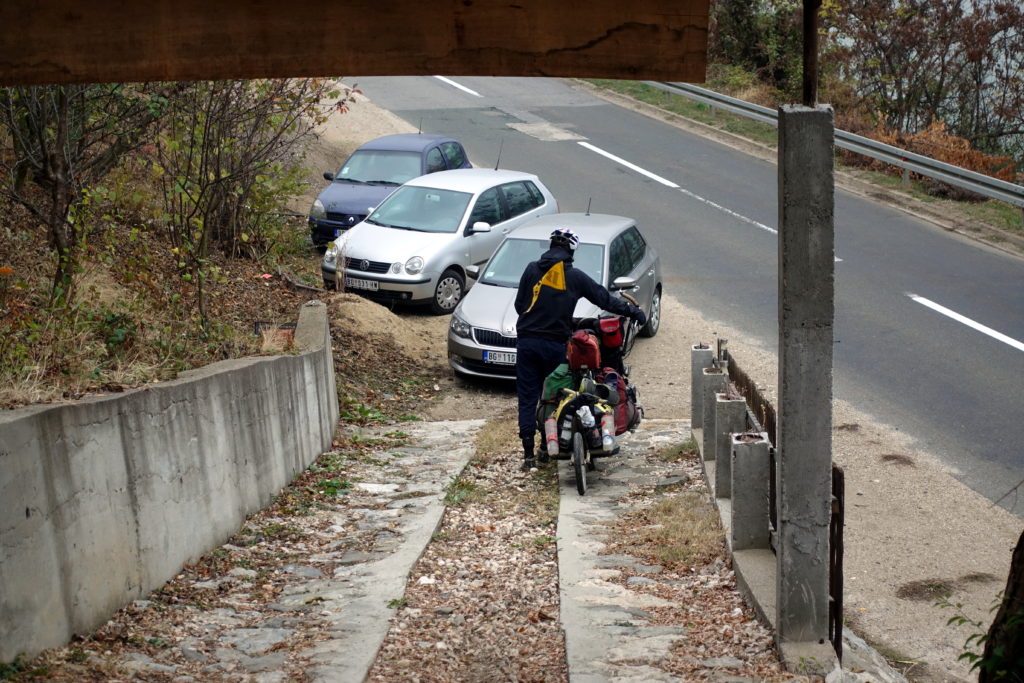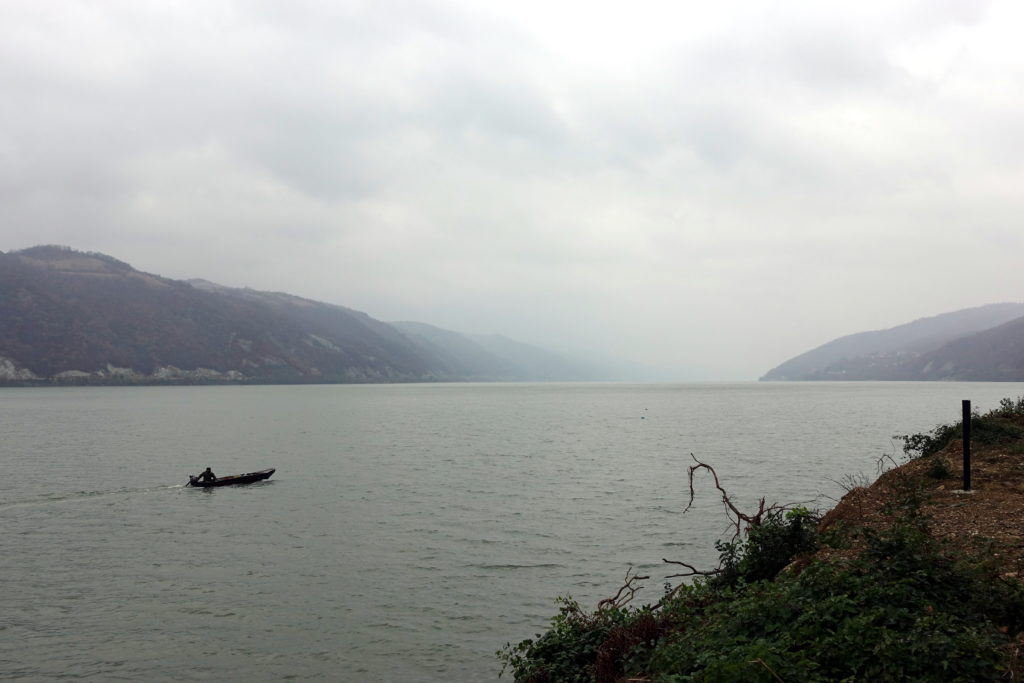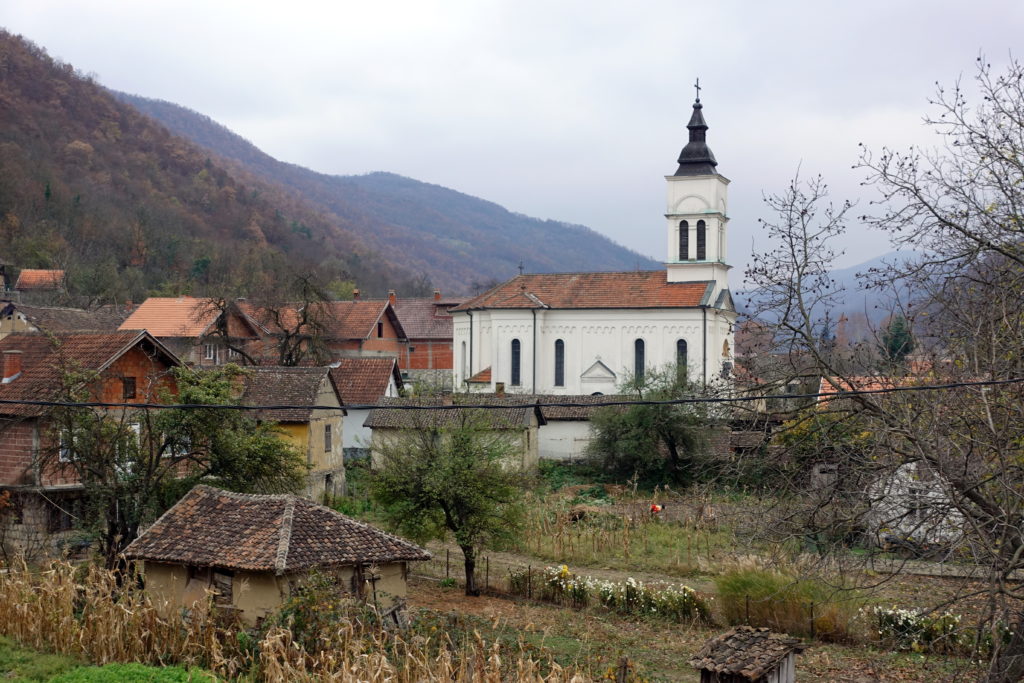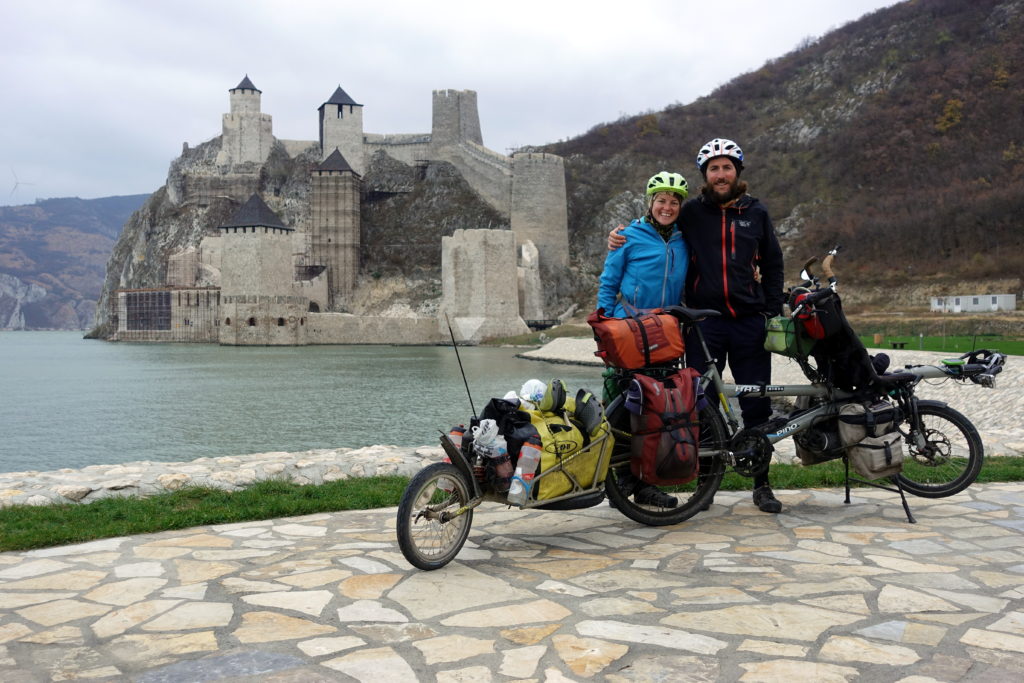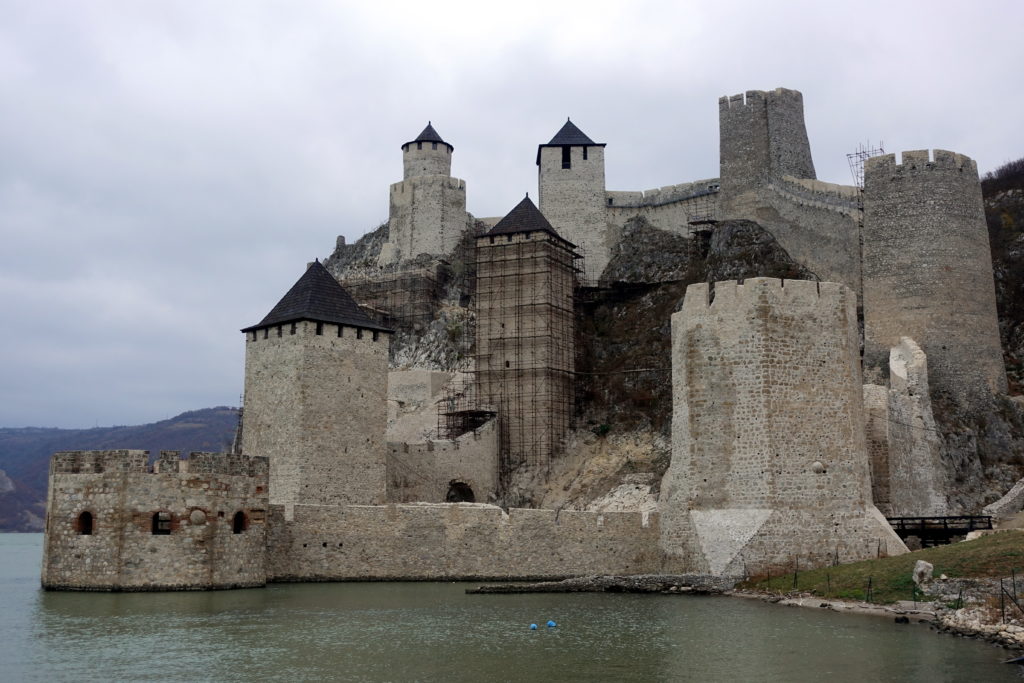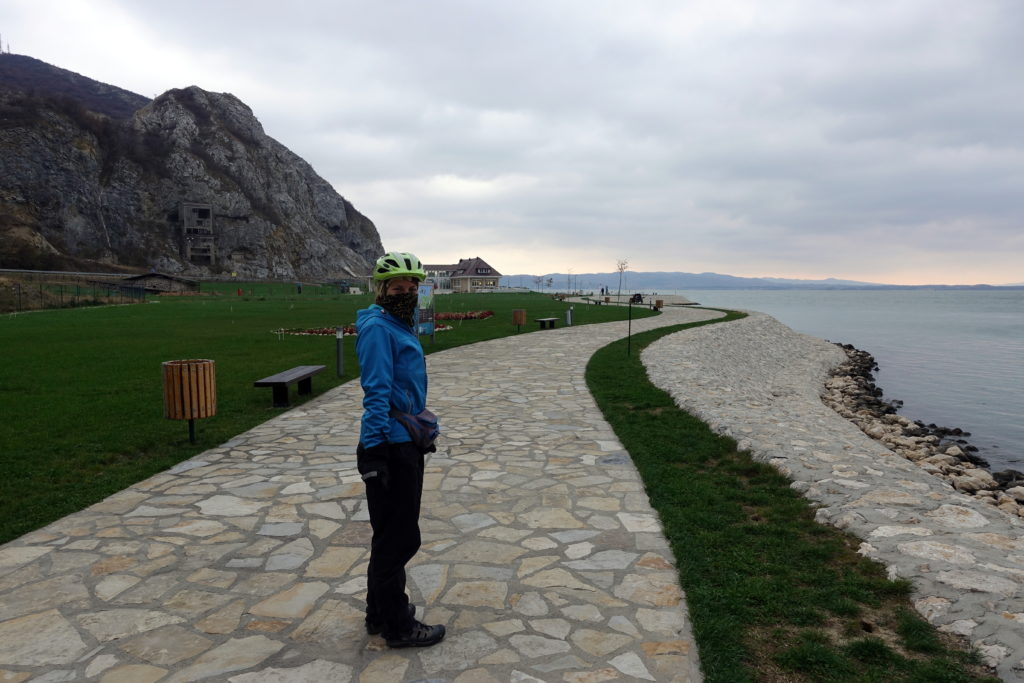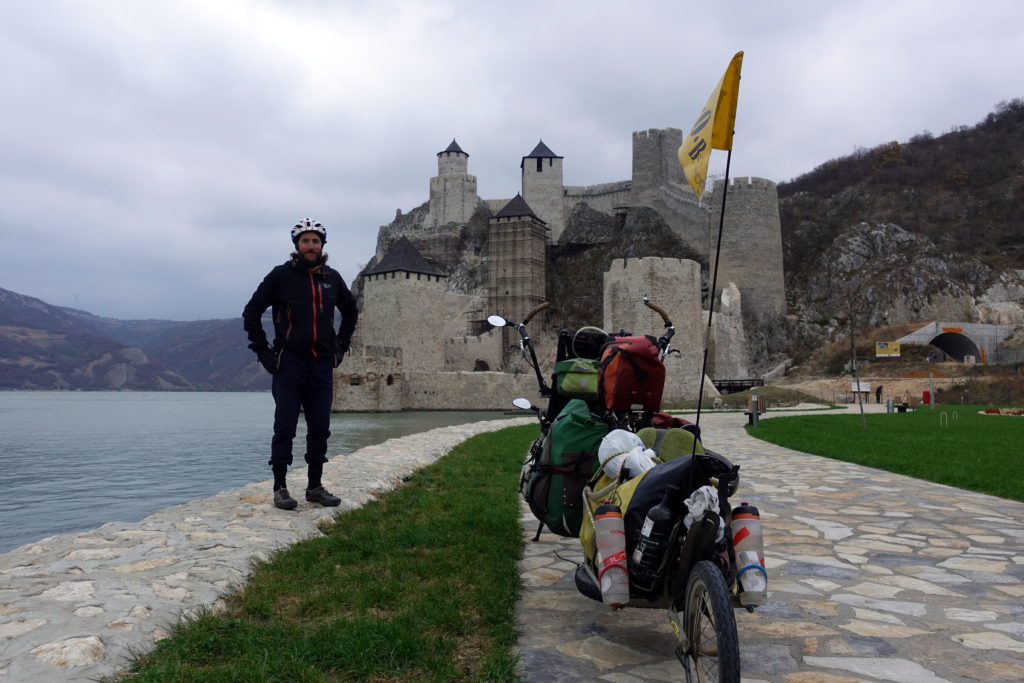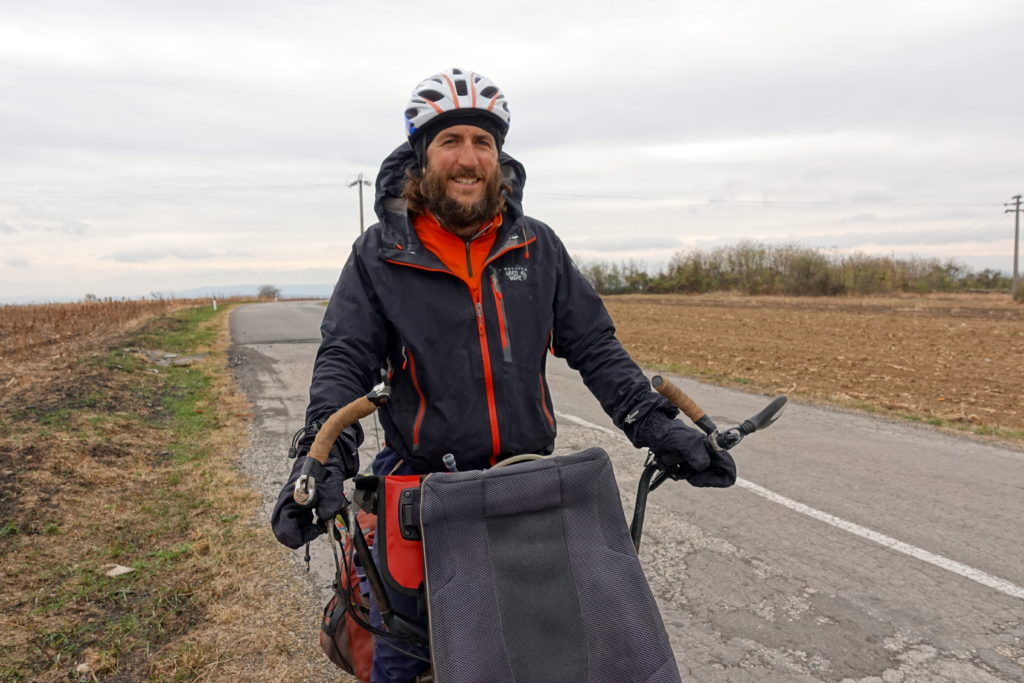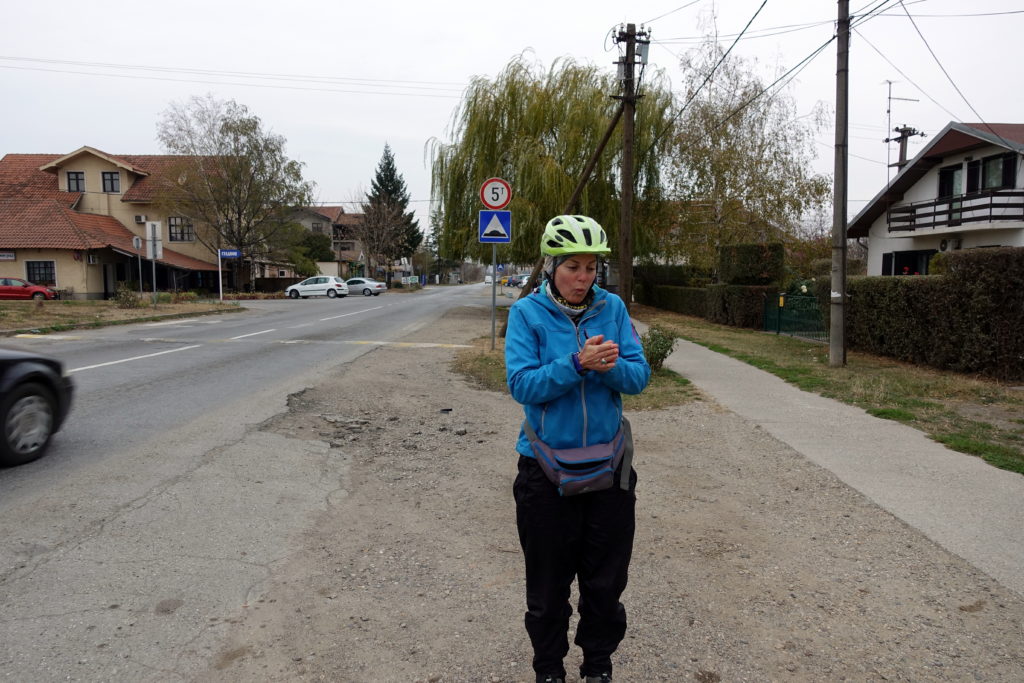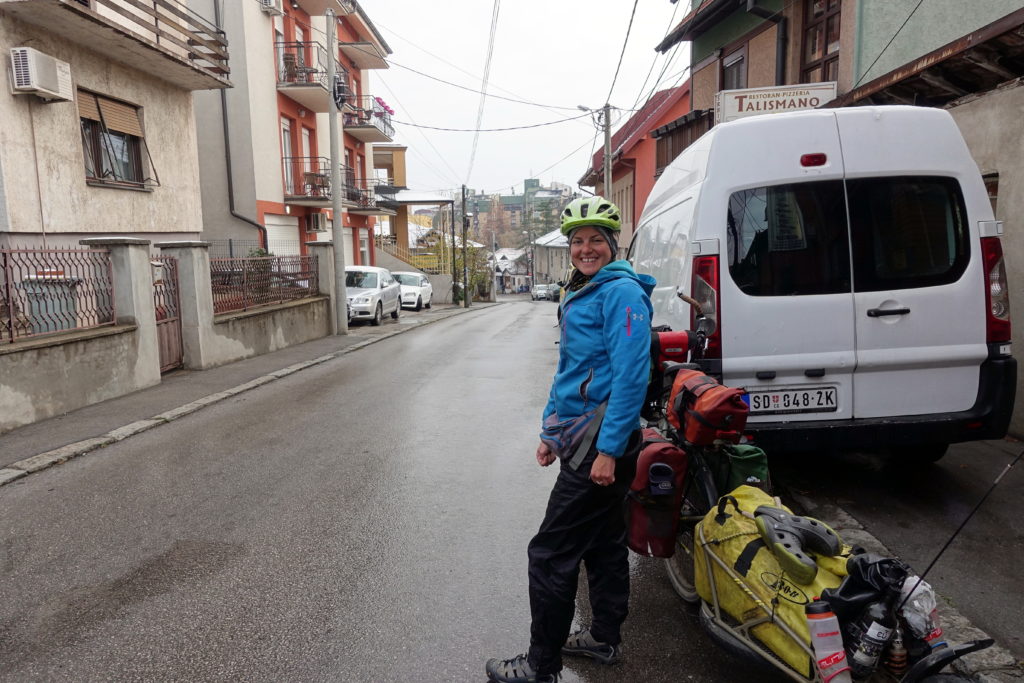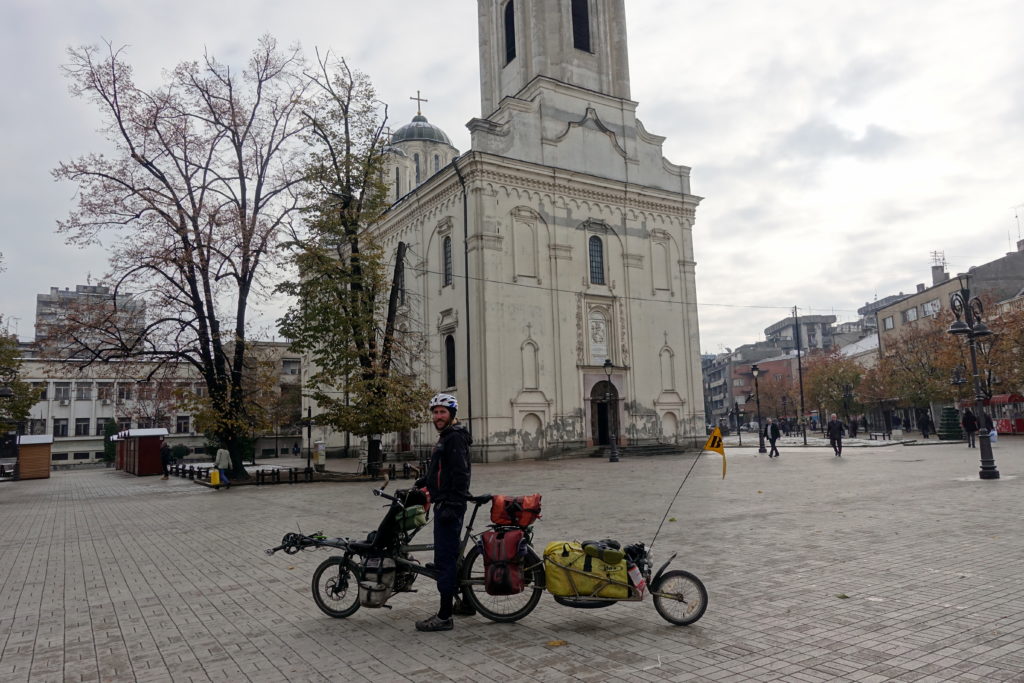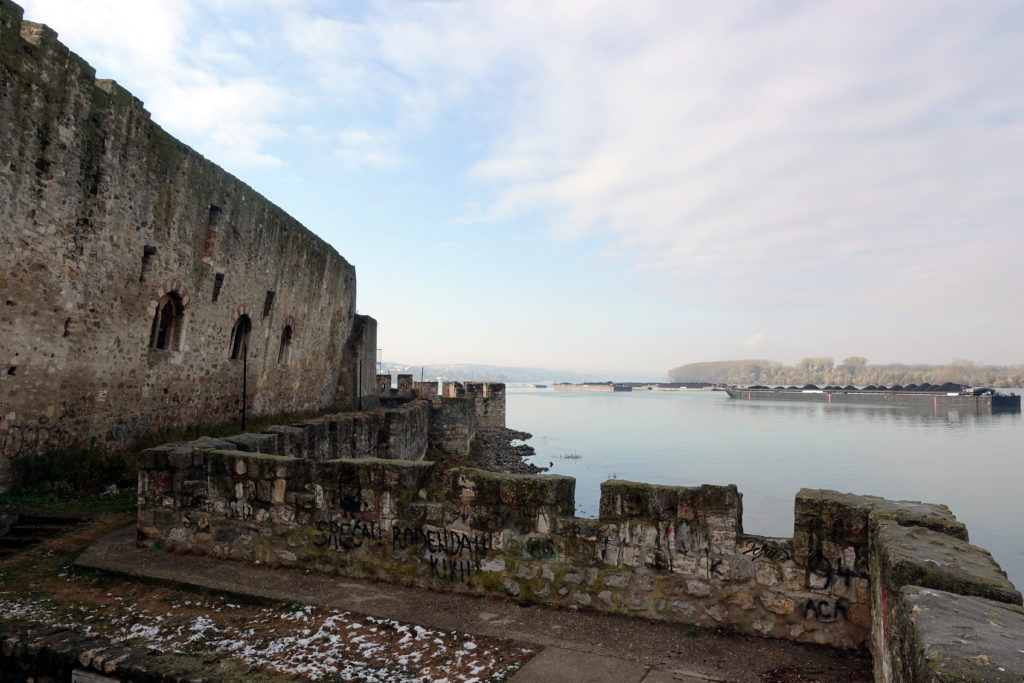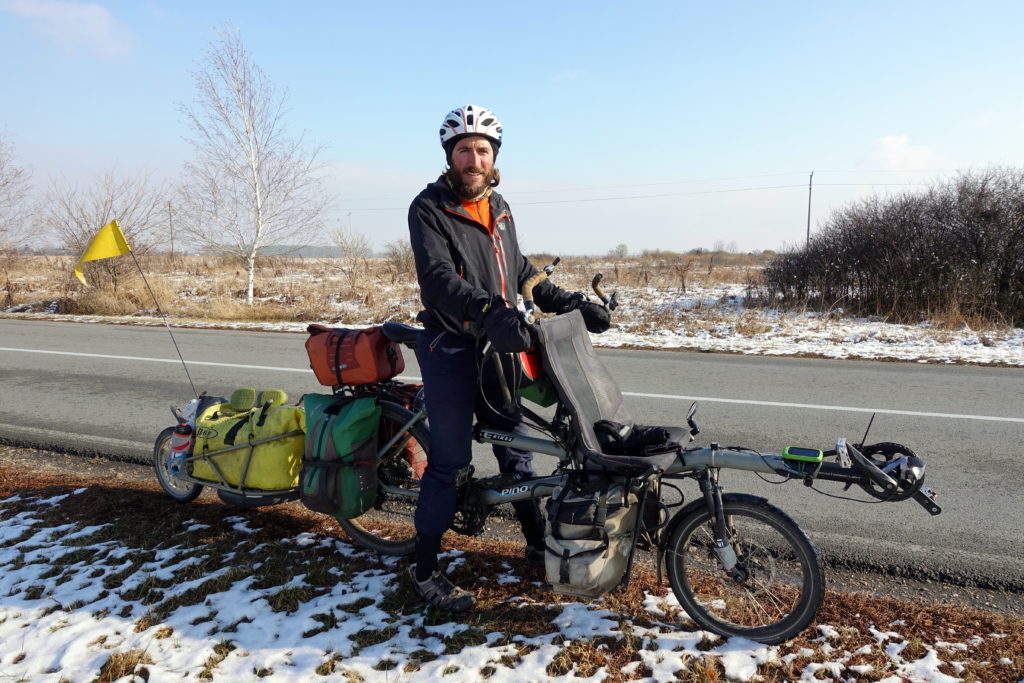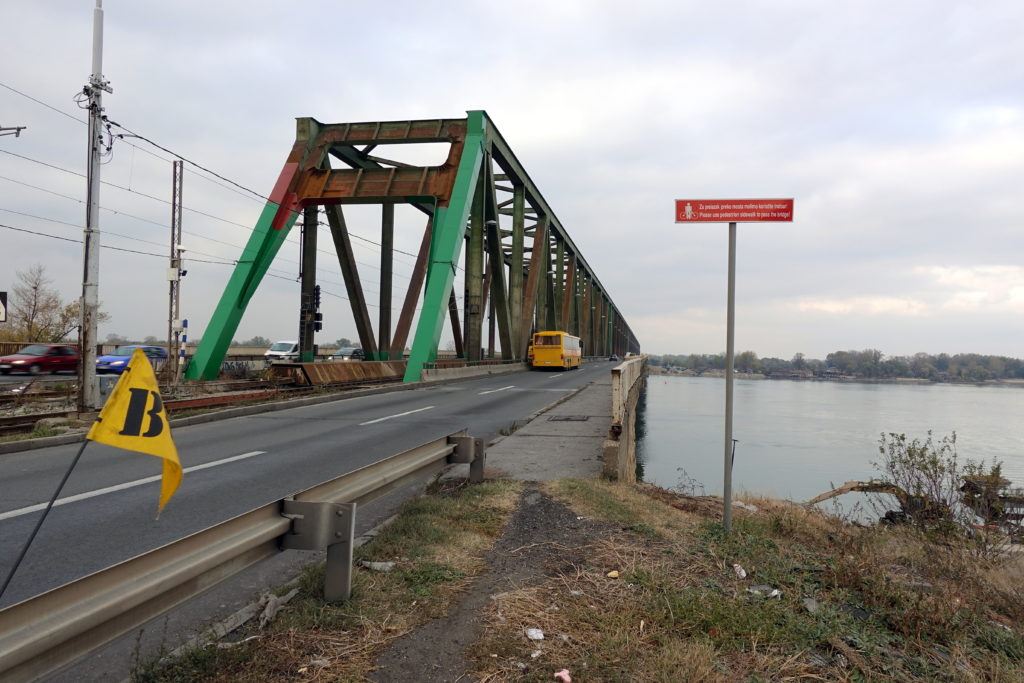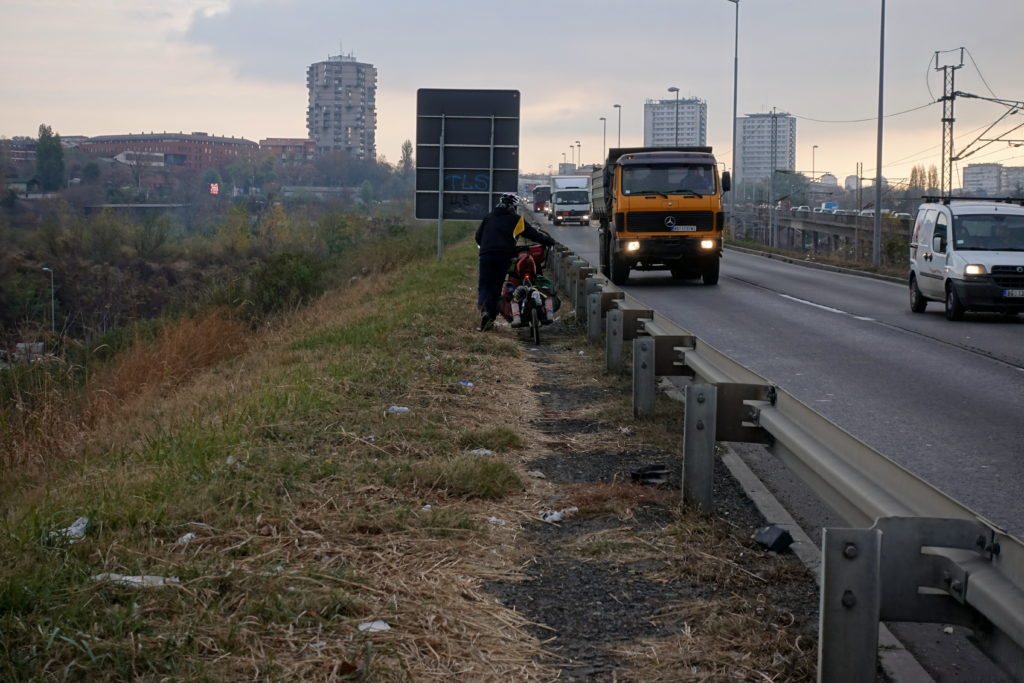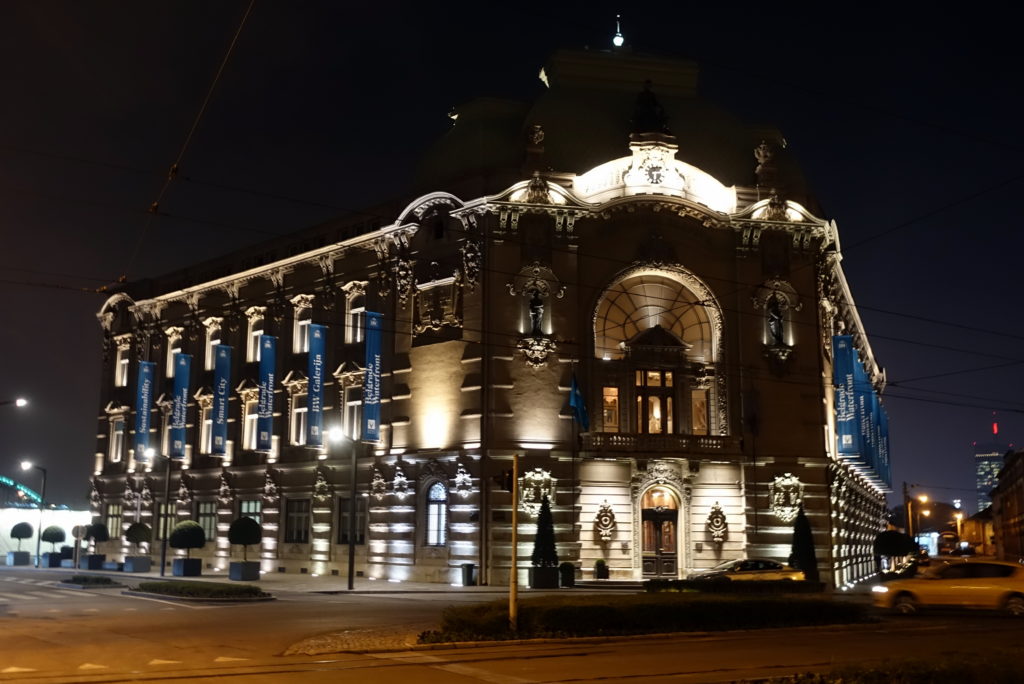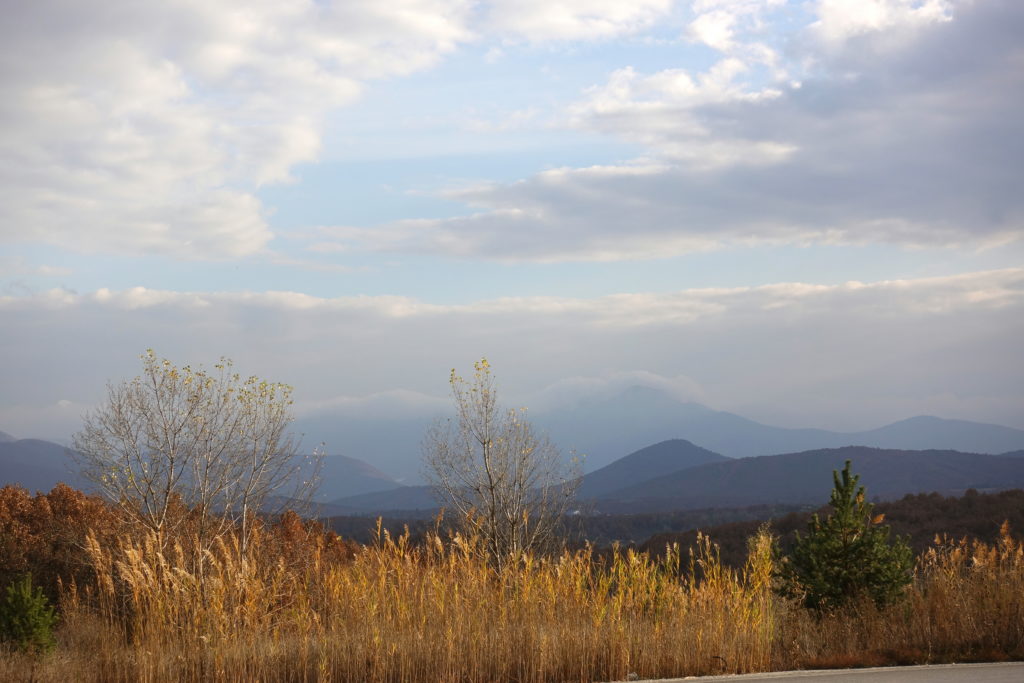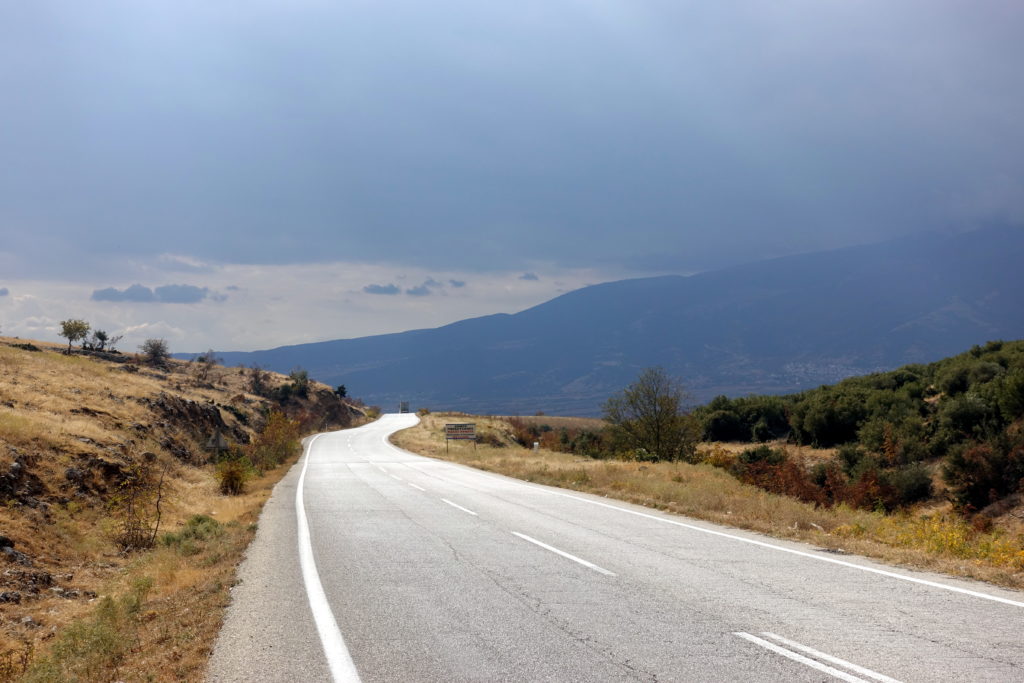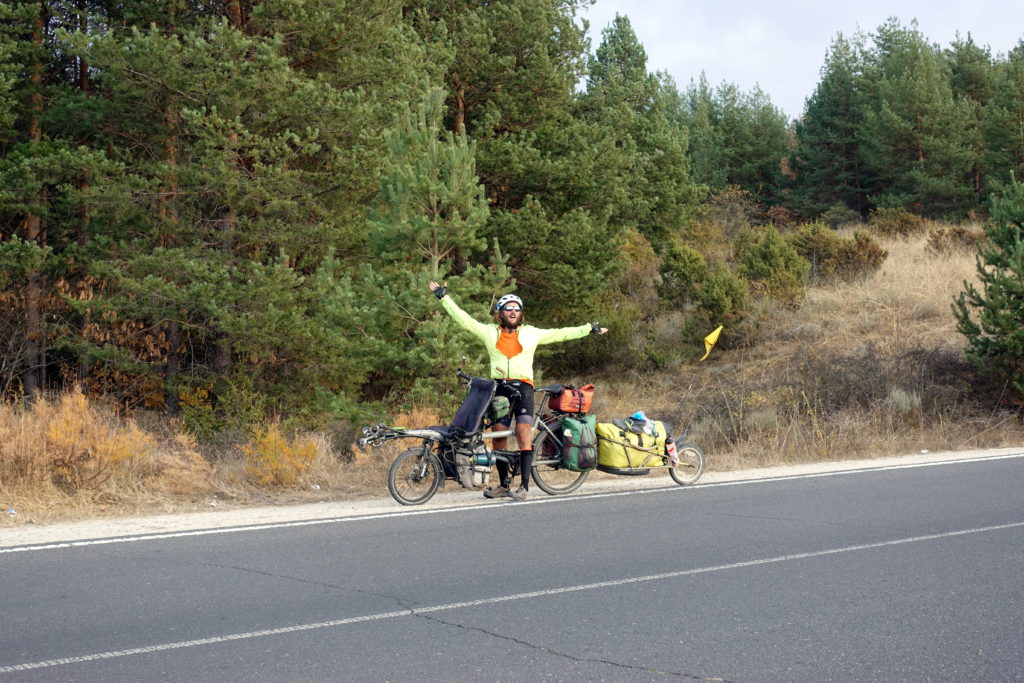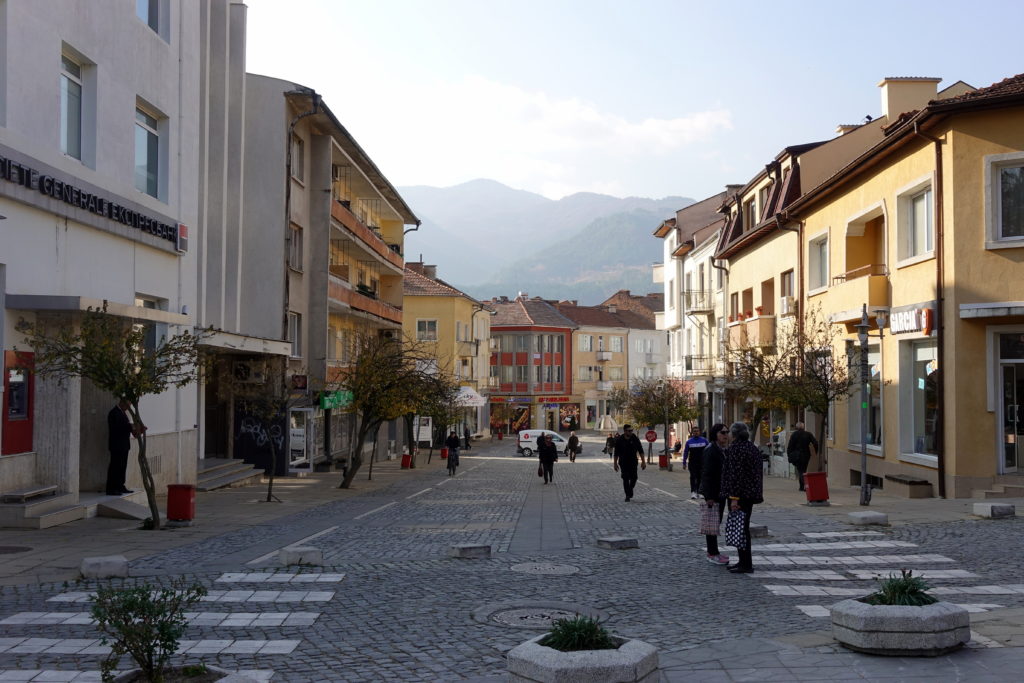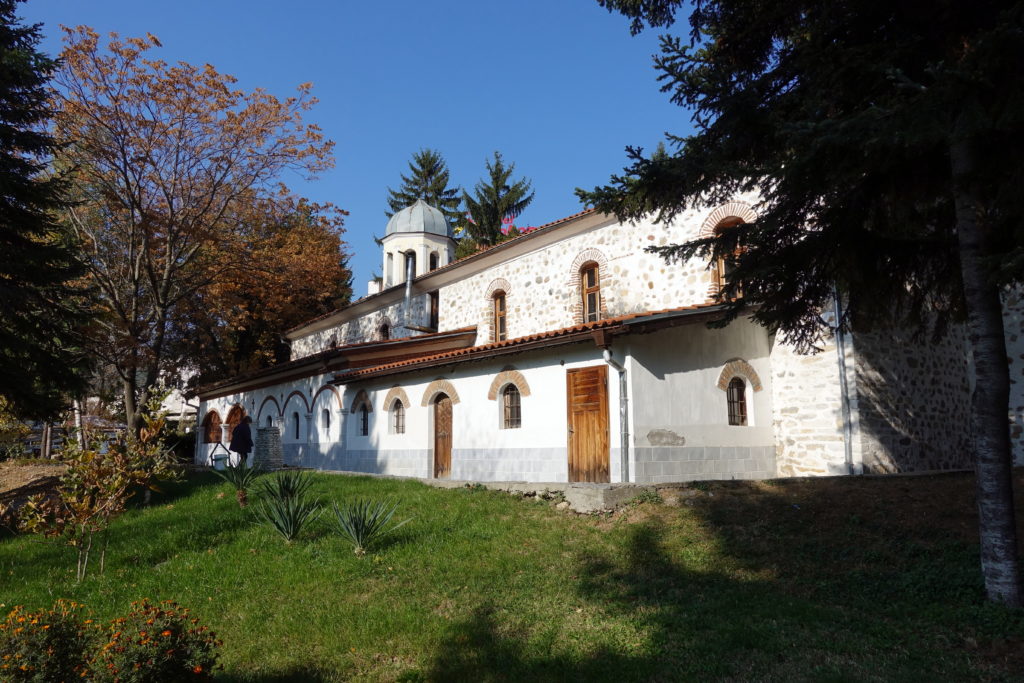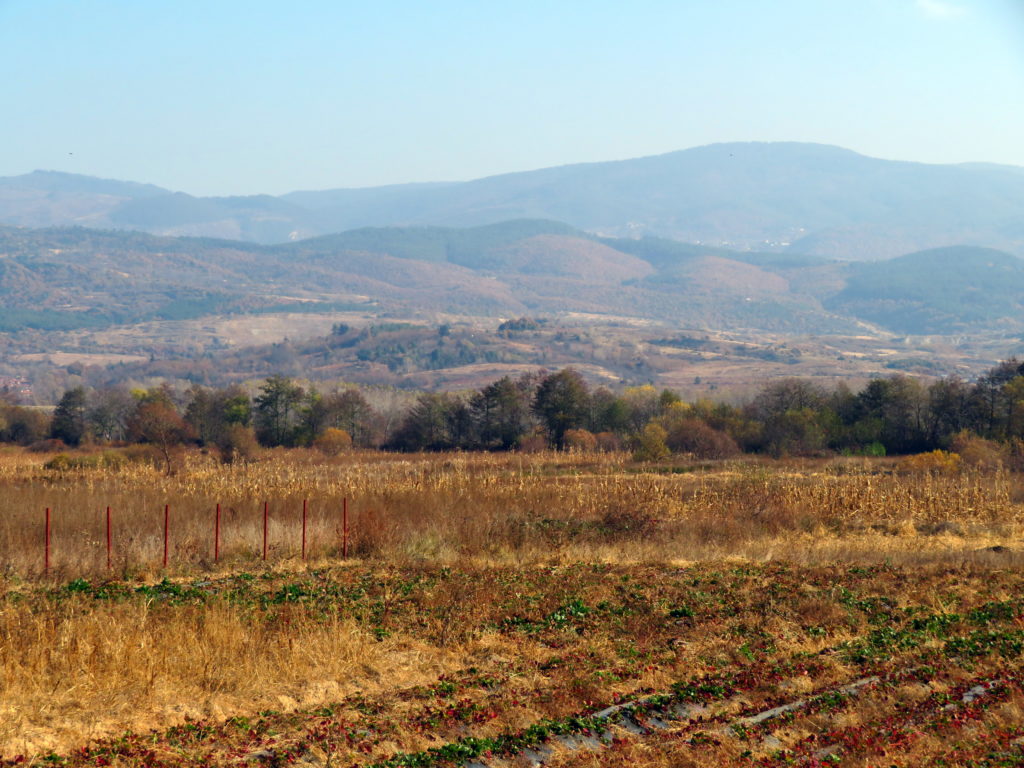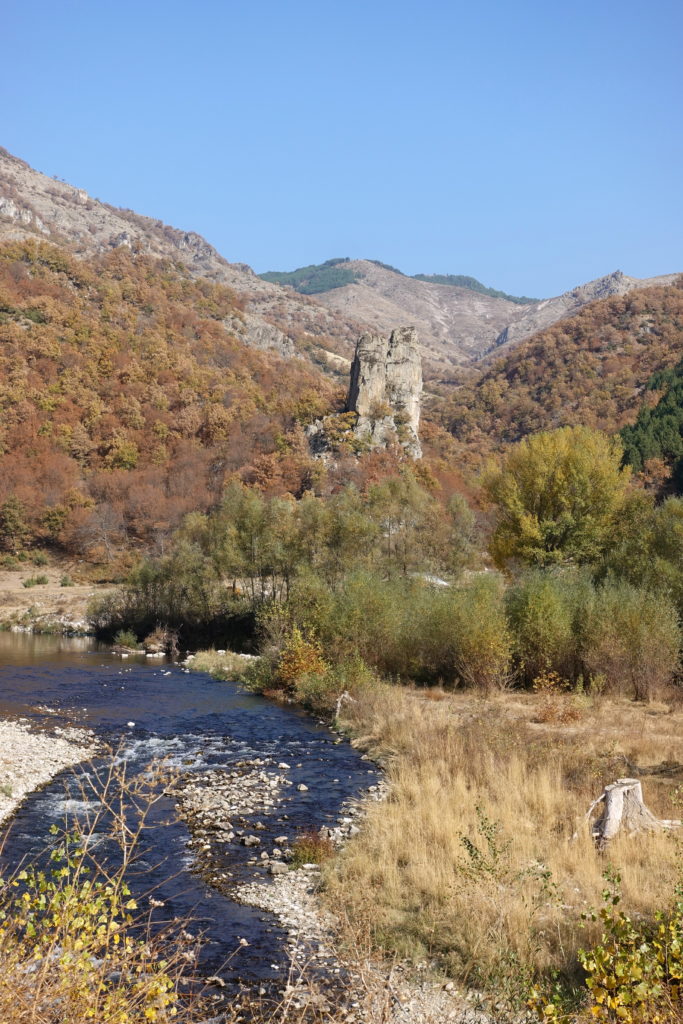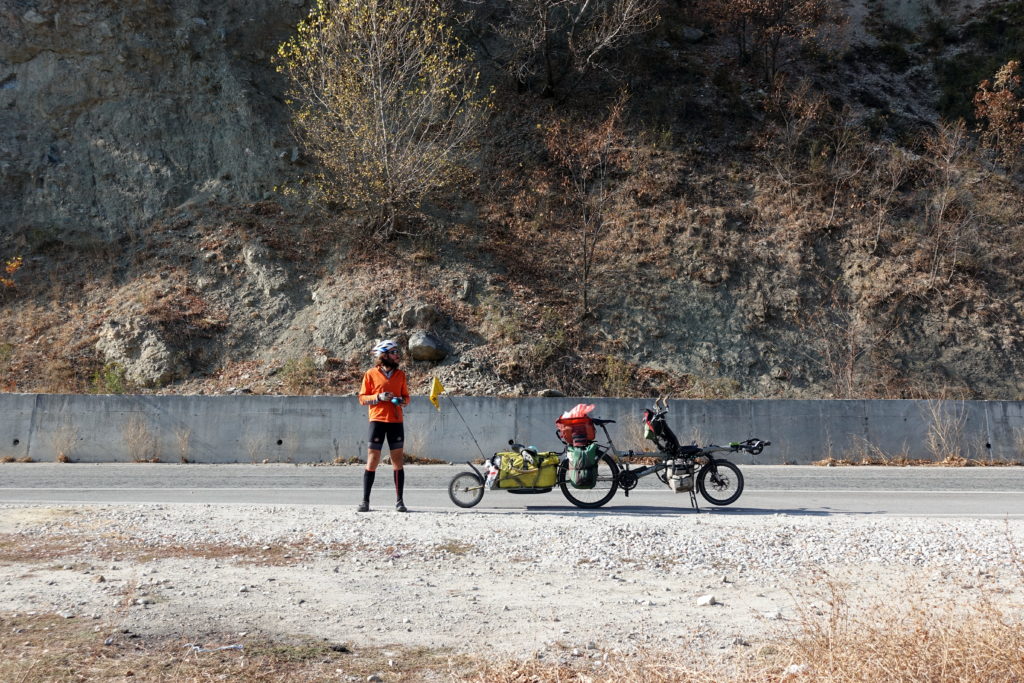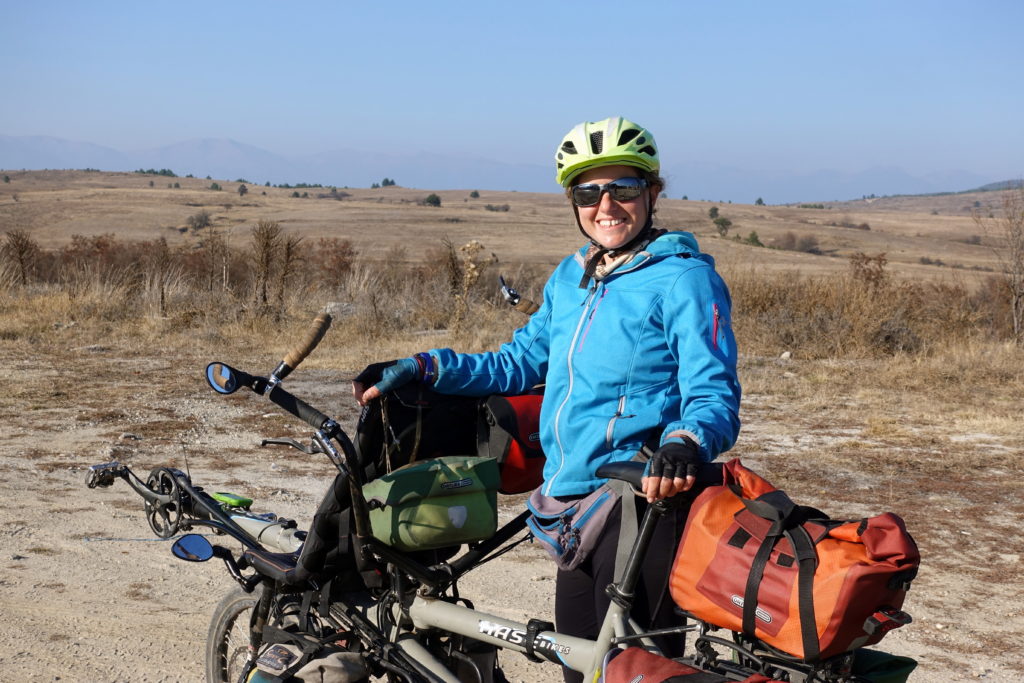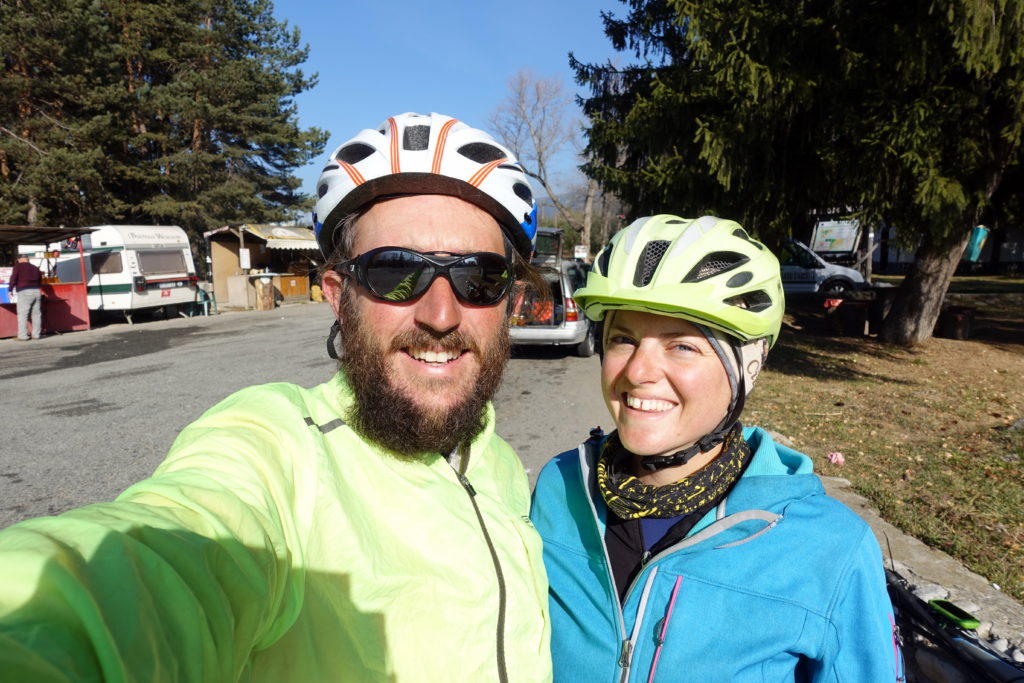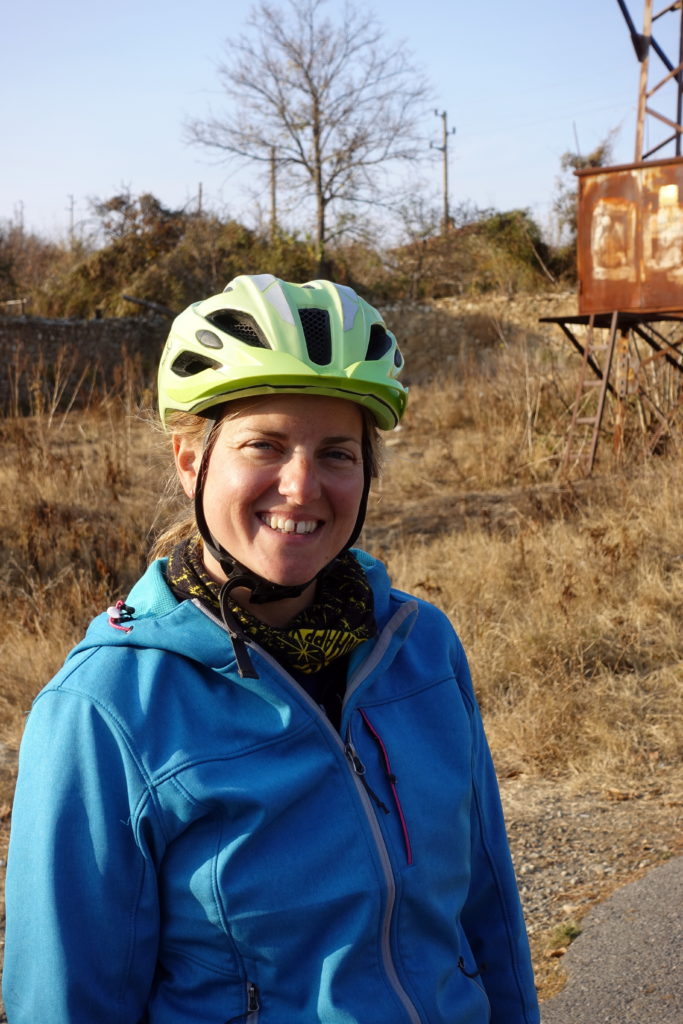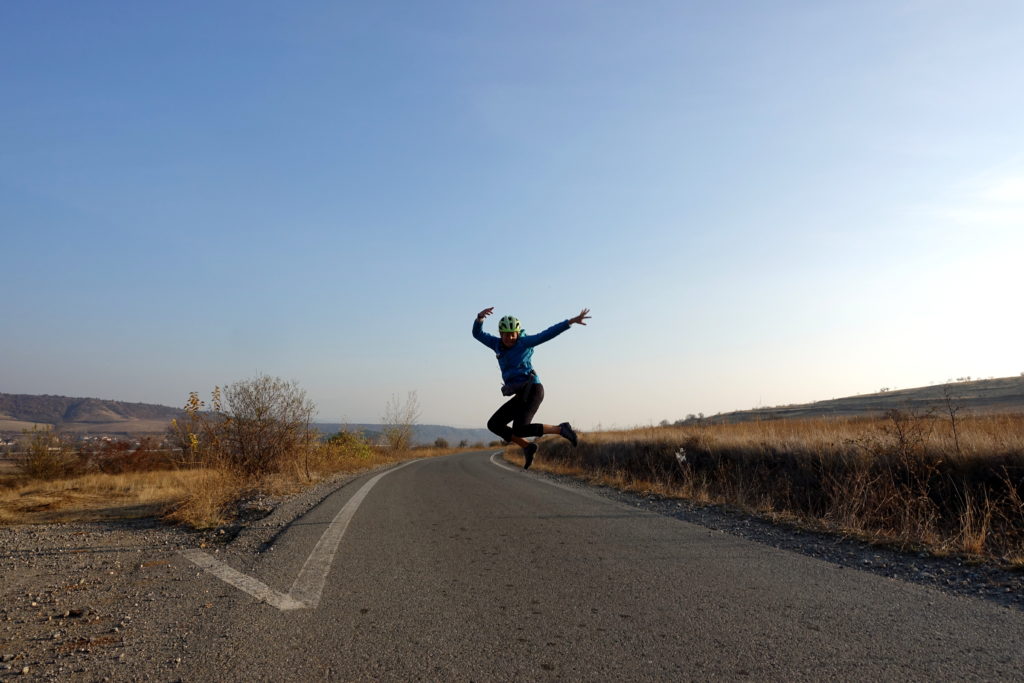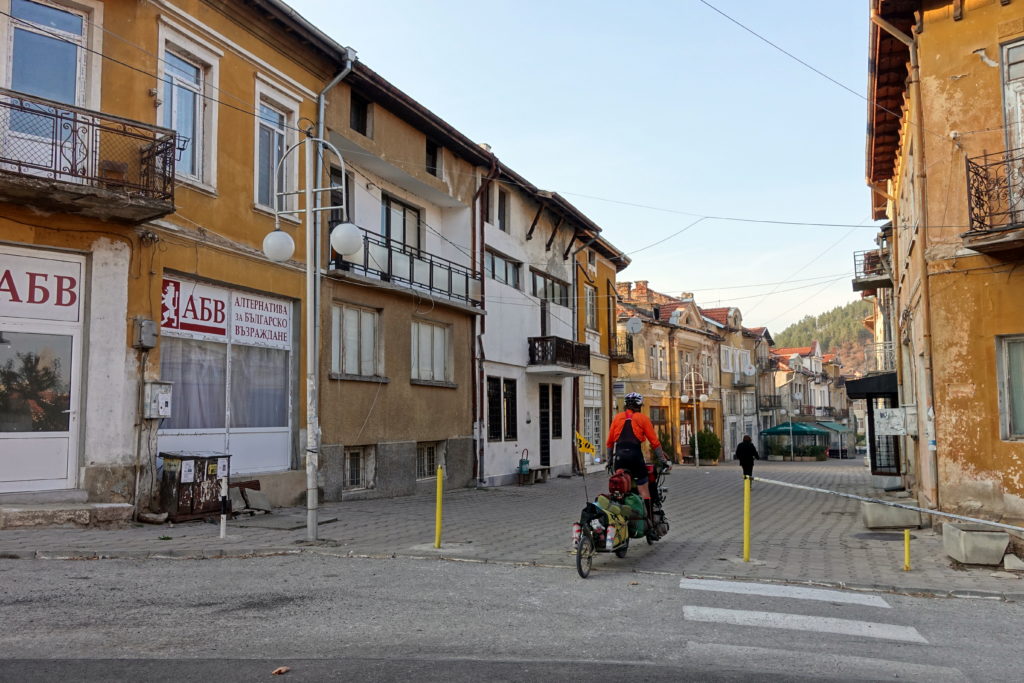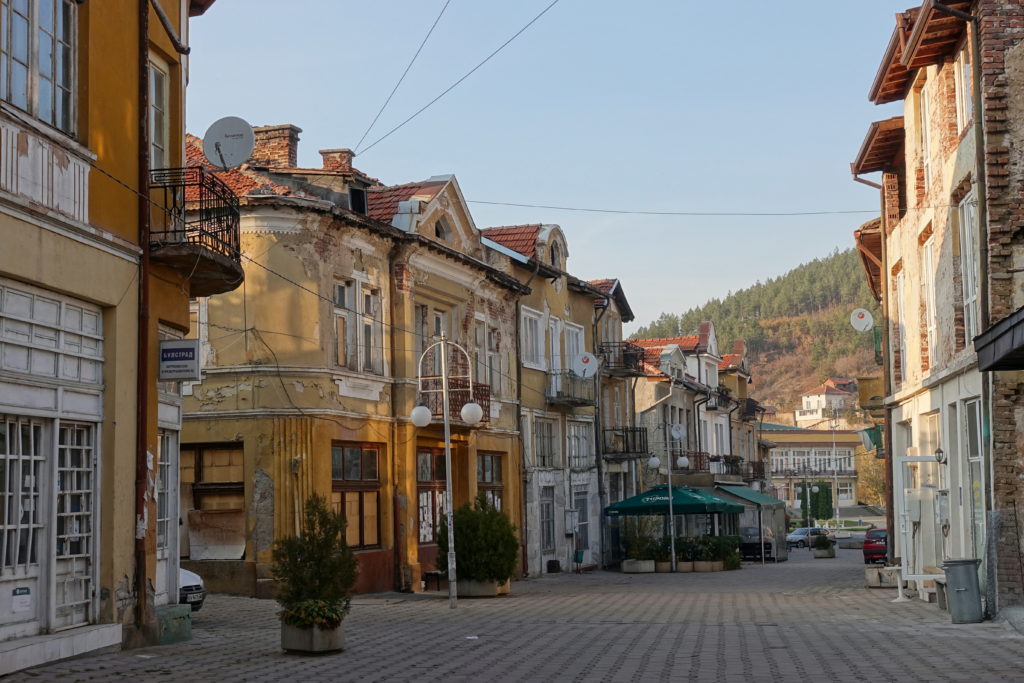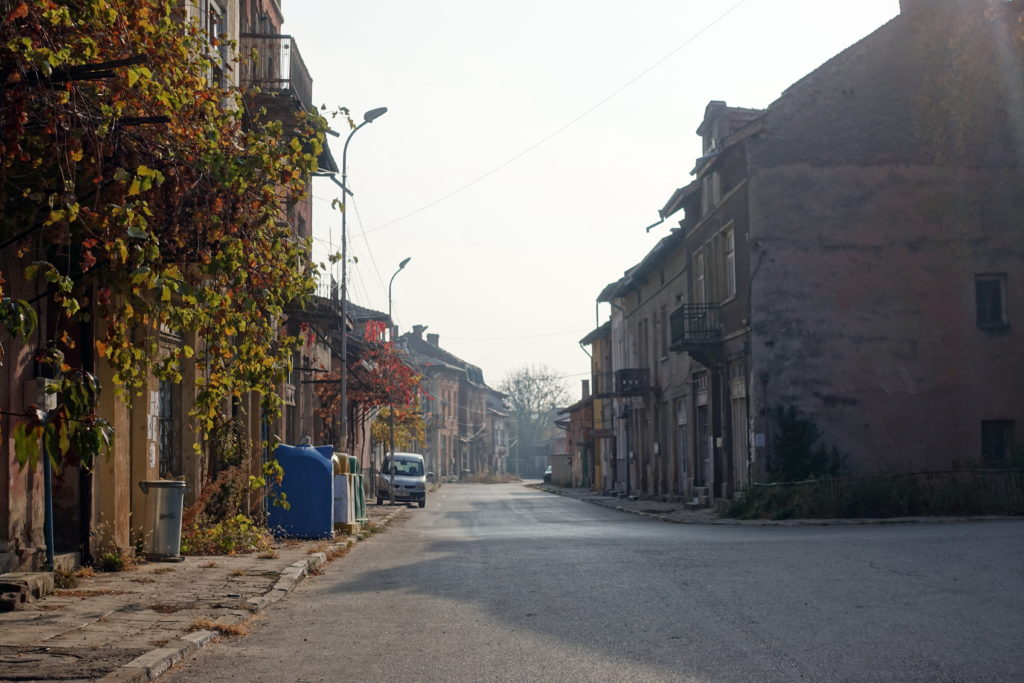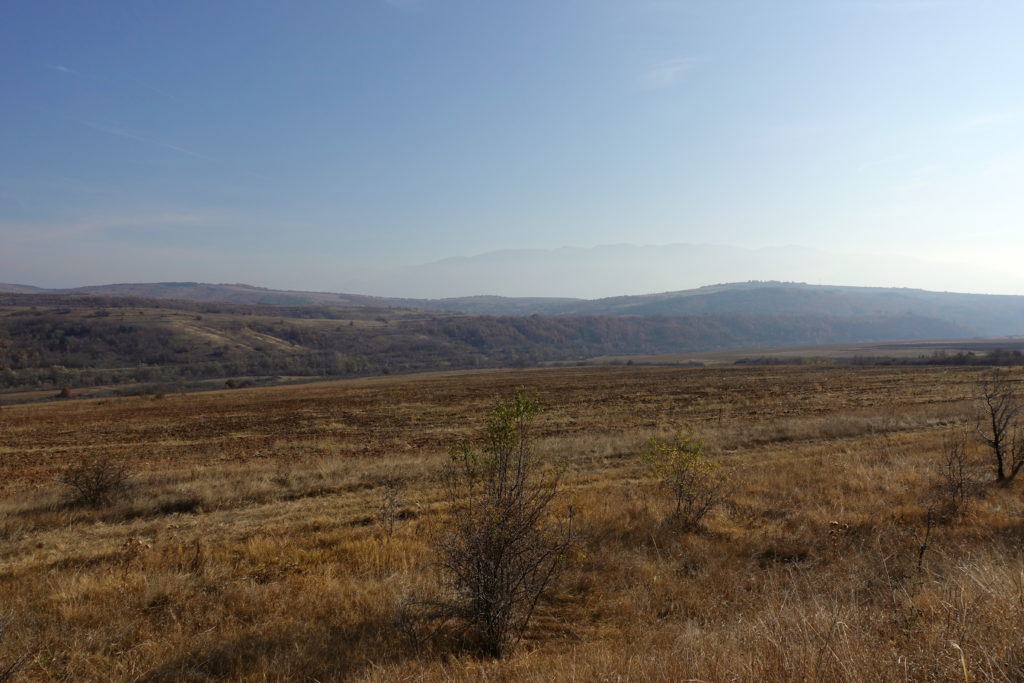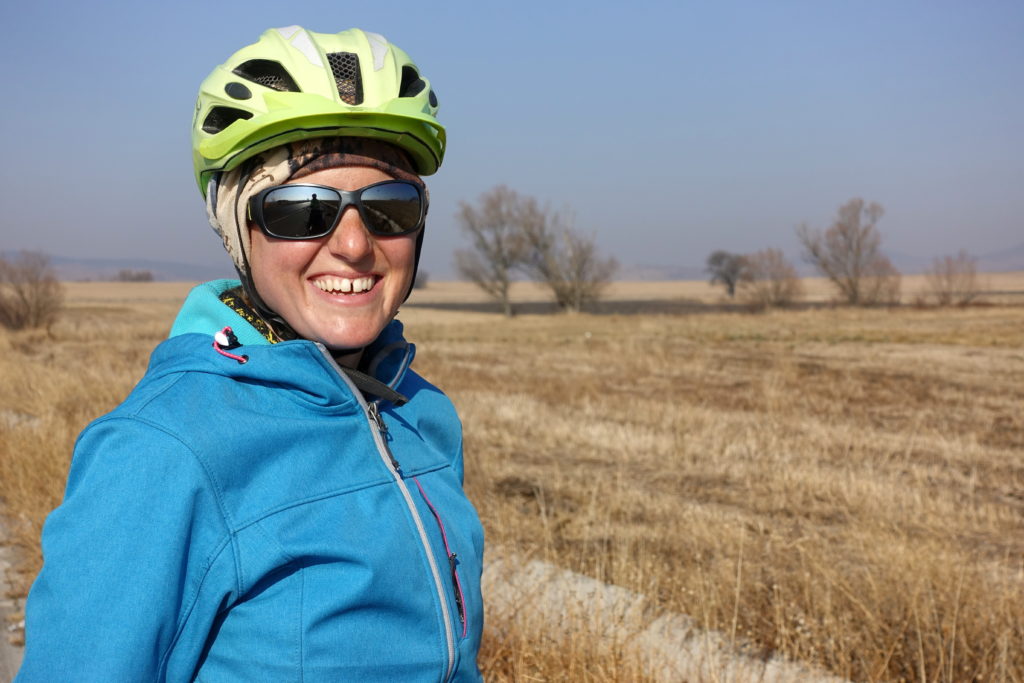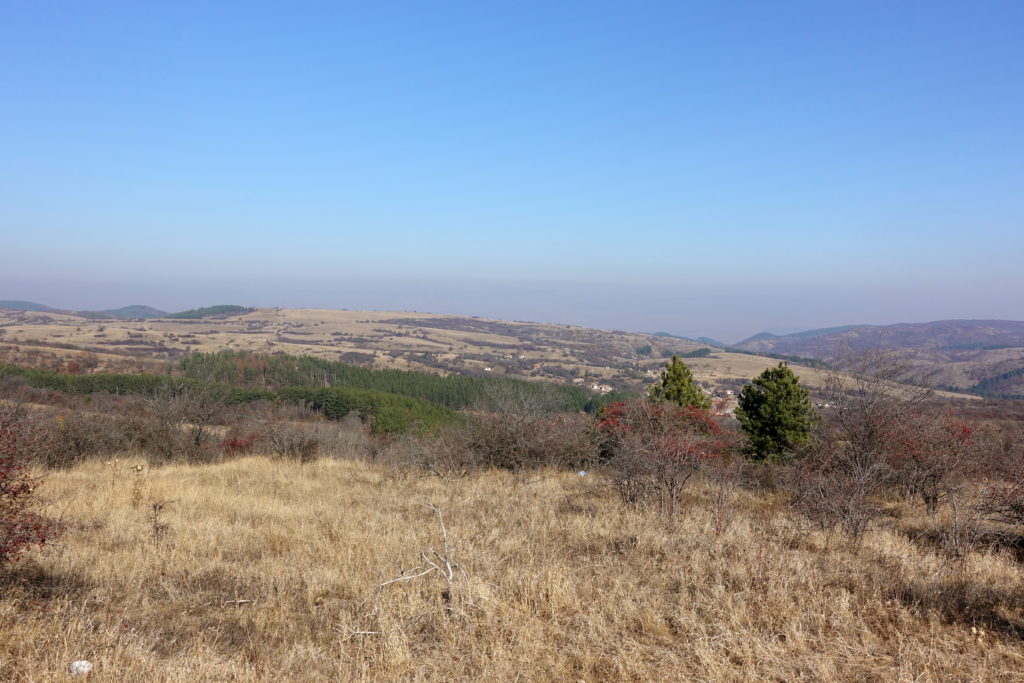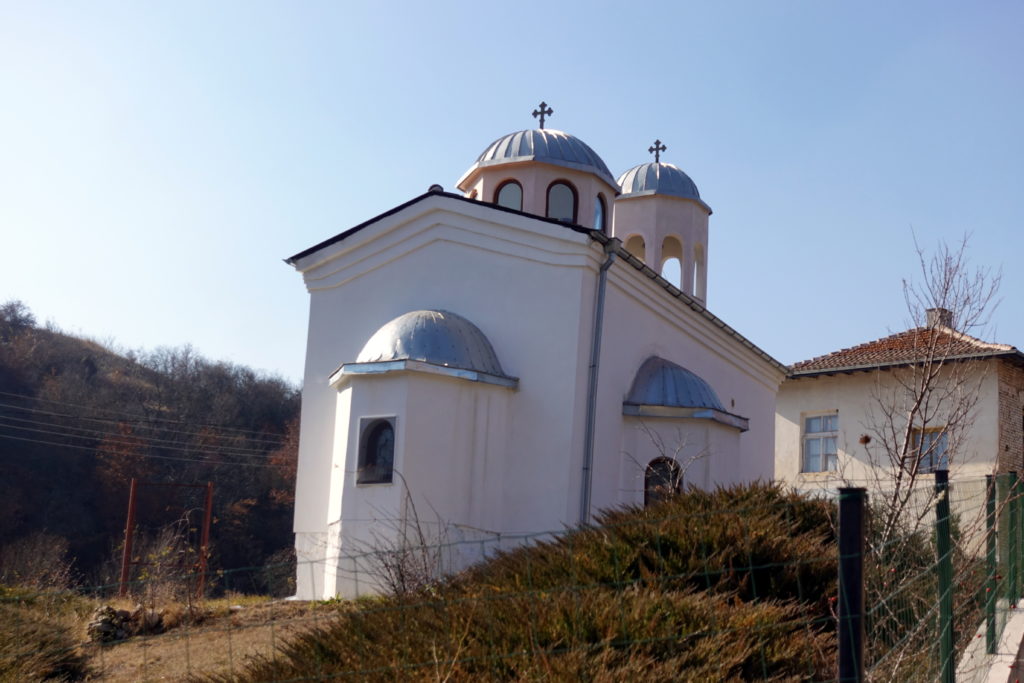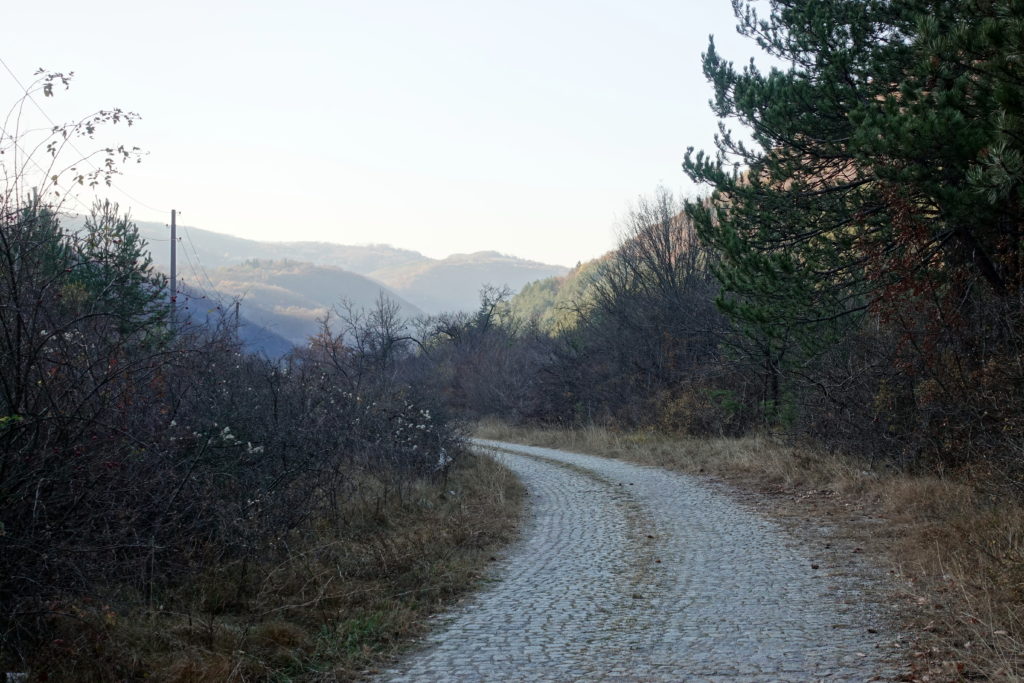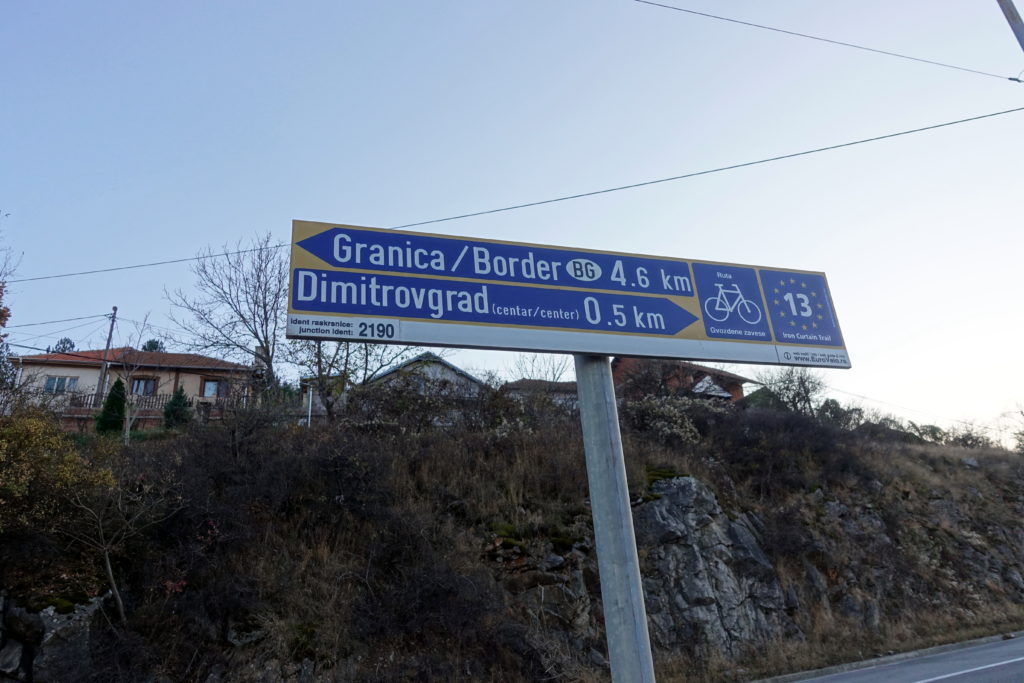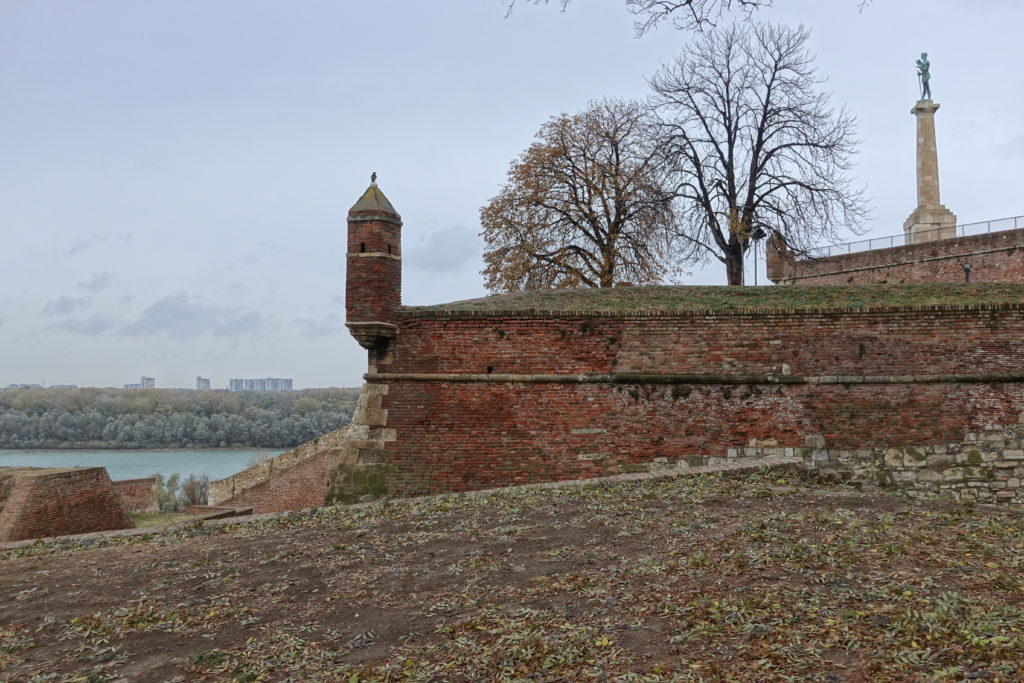
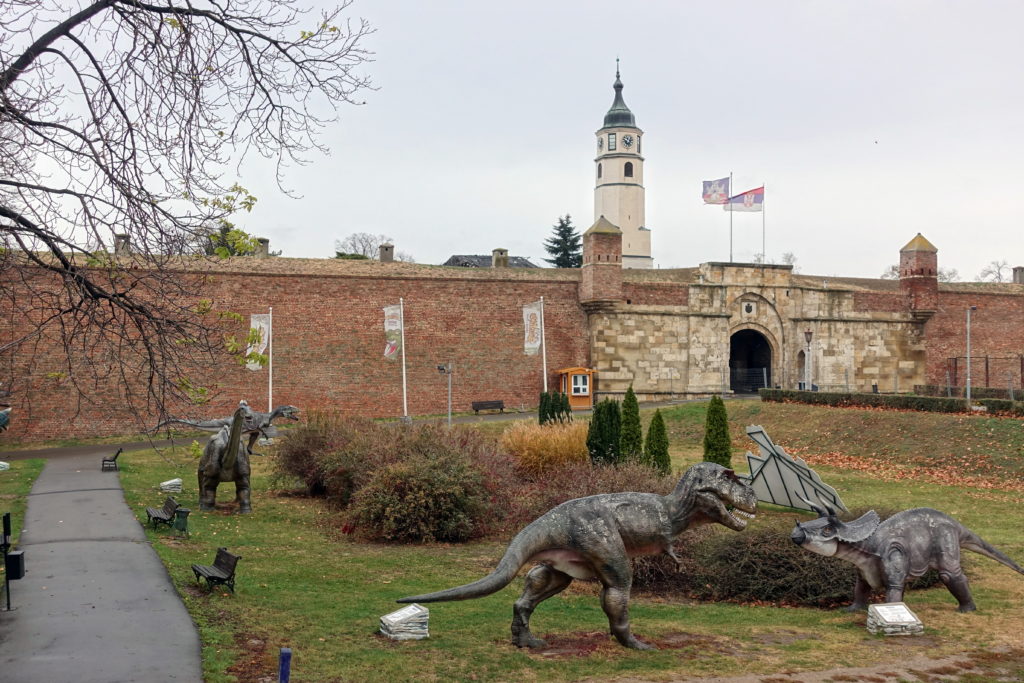
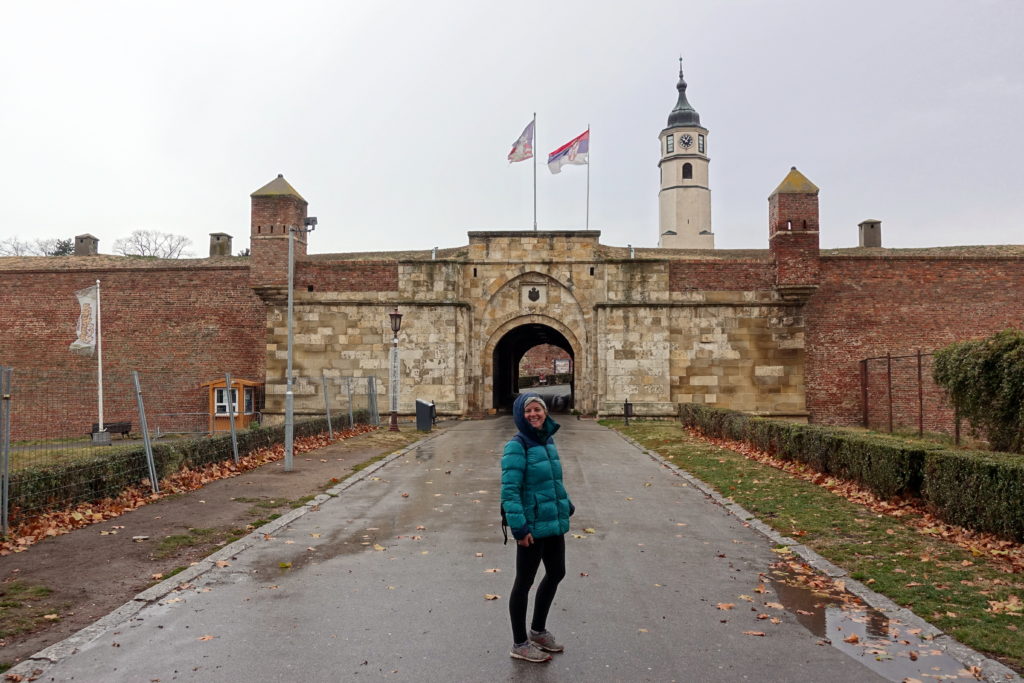
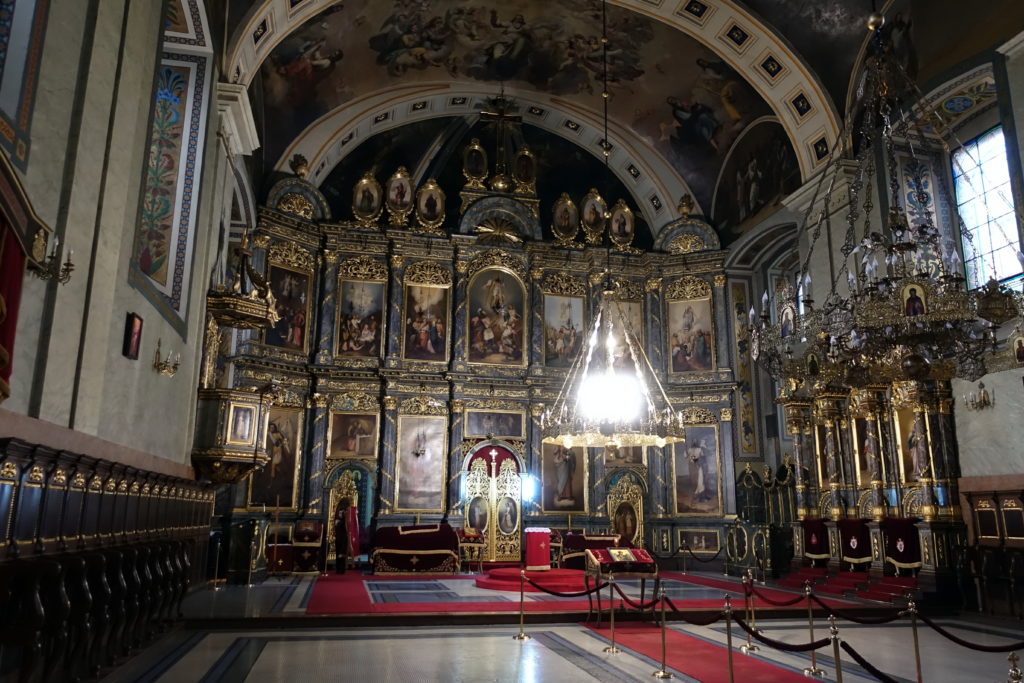
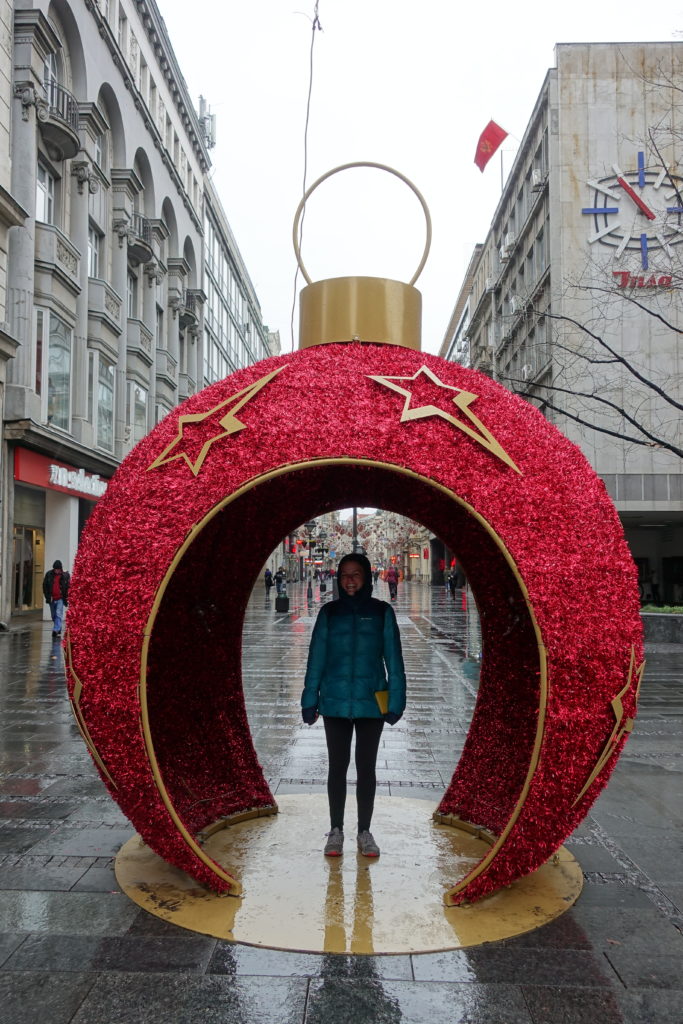
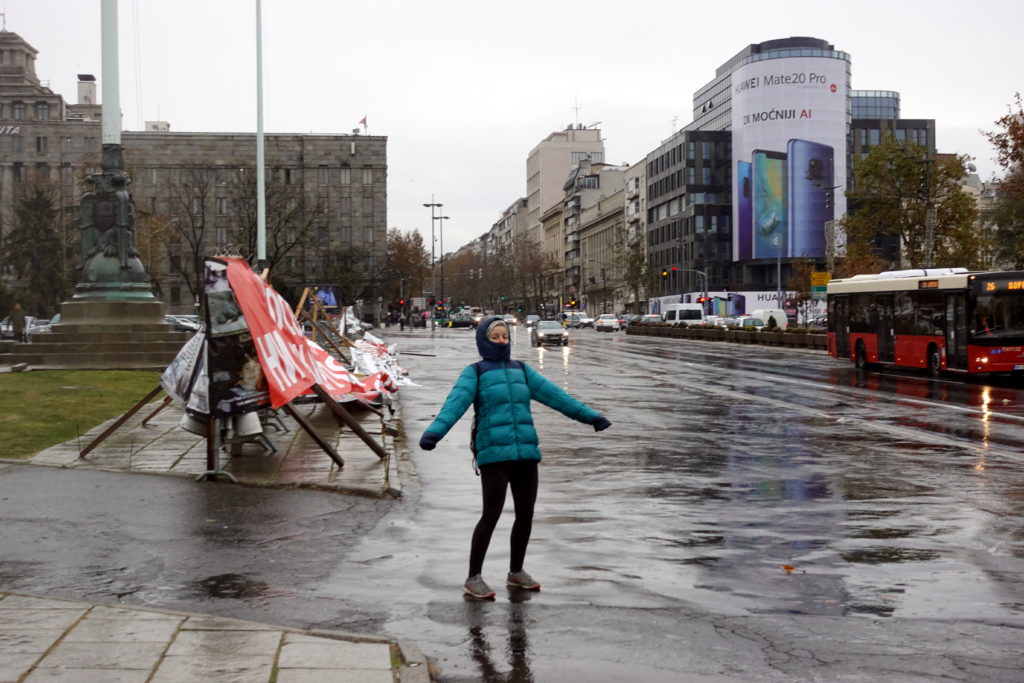
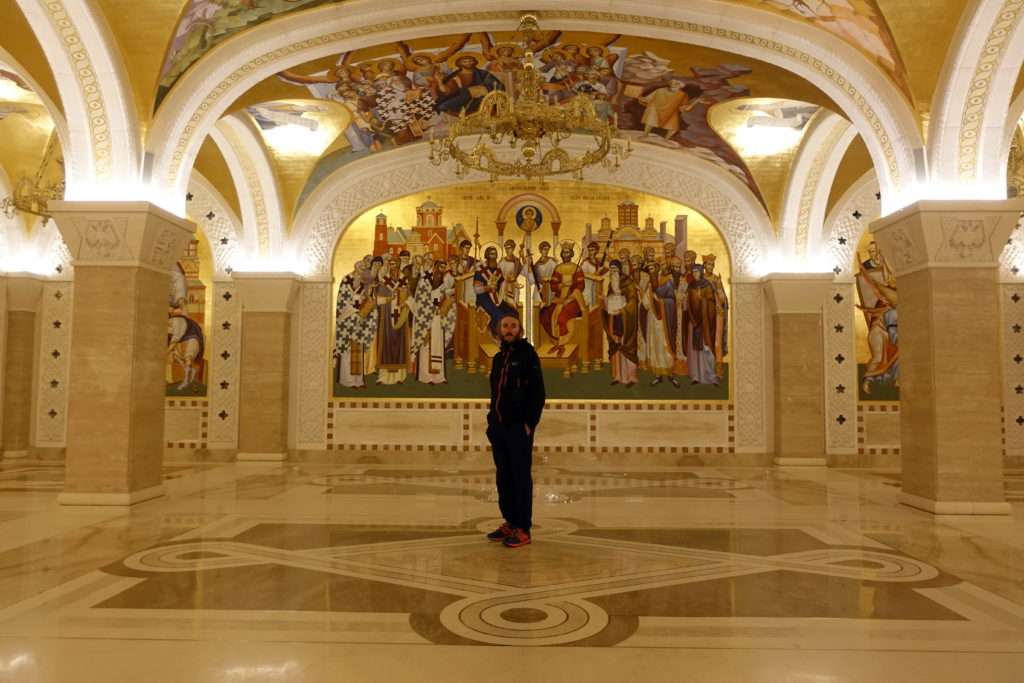
In the afternoon, we made our way back to the hotel and were surprised to find two other cyclists in our room: Corinne and Chris, who were also traveling on a Pino this year. As luck would have it, we have mutual friends in Augsburg and had been in contact with each other for the past few weeks, so we could finally meet. We were relatively close to each other in Kyrgyzstan, then we split – them going through Iran, we through the Caspian and the Caucasus, and even since Istanbul we had been playing cat and mouse throughout the Balkans – Cassie found her favorite French expression: chasse-patate! We finally found a way to join at the same place and same time in Belgrade, the (almost) final destination of their trip. The rest of the day, we exchanged stories of our travels over food and drink.
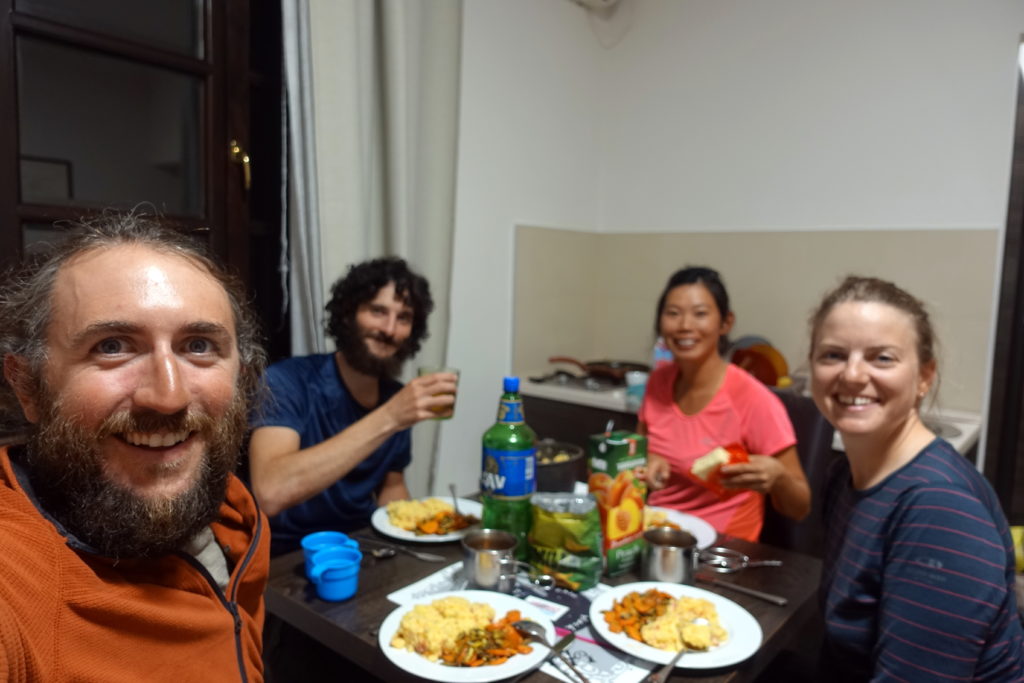
Everyone blurry but Cedric 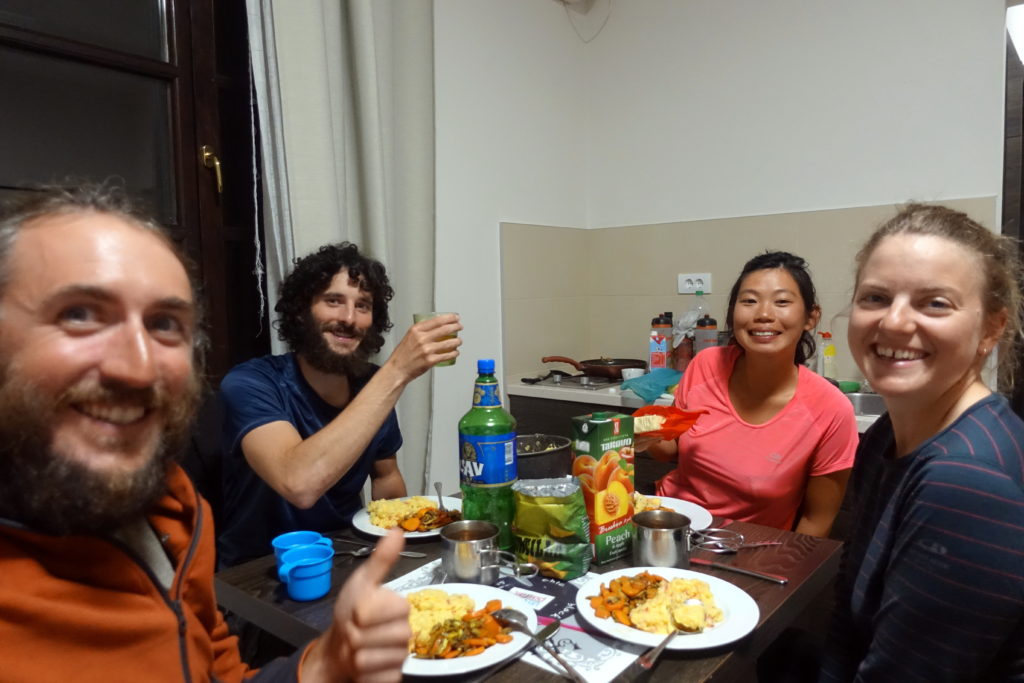
Everyone unblurred but Cedric
The next morning, Cédric and I said our goodbyes and headed north. Corinne and Chris, on the other hand, left to take a bus to Munich and were thus closer to ending their trip. Our day cycling on the road was a blur – with little opportunity for small roads, we joined the constant flow of traffic on a secondary road. The rolling showers and fog didn’t make the ride exciting either, so we cycled into Novi Sad with few breaks and arrived there early in the afternoon. After getting scammed finding an accommodation (a very poorly rated hotel presented themselves as being the owner of the highly rated place next door – and found out about it after paying the night – certain that given the reviews we would not need to check the room first like we used to do in Asia), we went around to discover this historical city and so for the remaining part of the day, we walked around the picturesque downtown. Unlike Belgrade with its plethora of communist-style architecture and busy industrial suburbs, the center of Novi Sad still has an abundance of regal 19th century and older buildings. Novi Sad being on the extreme north east of Serbia, it had been part of multiple other countries (Hungary until recently), and the influence of Austria and other central European powers is a lot more visible.
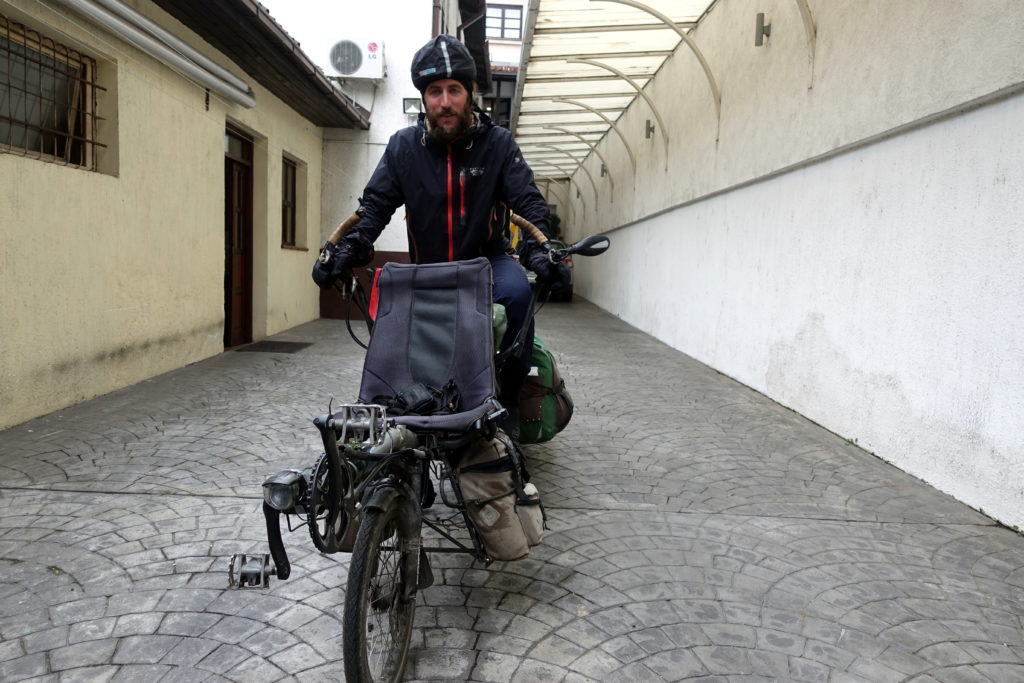
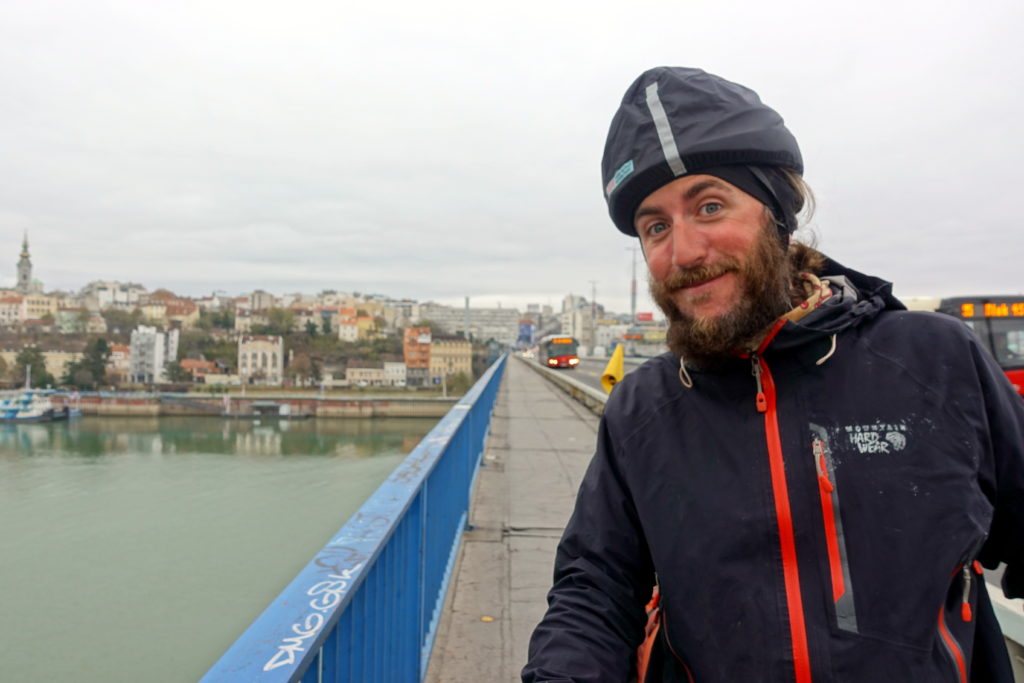
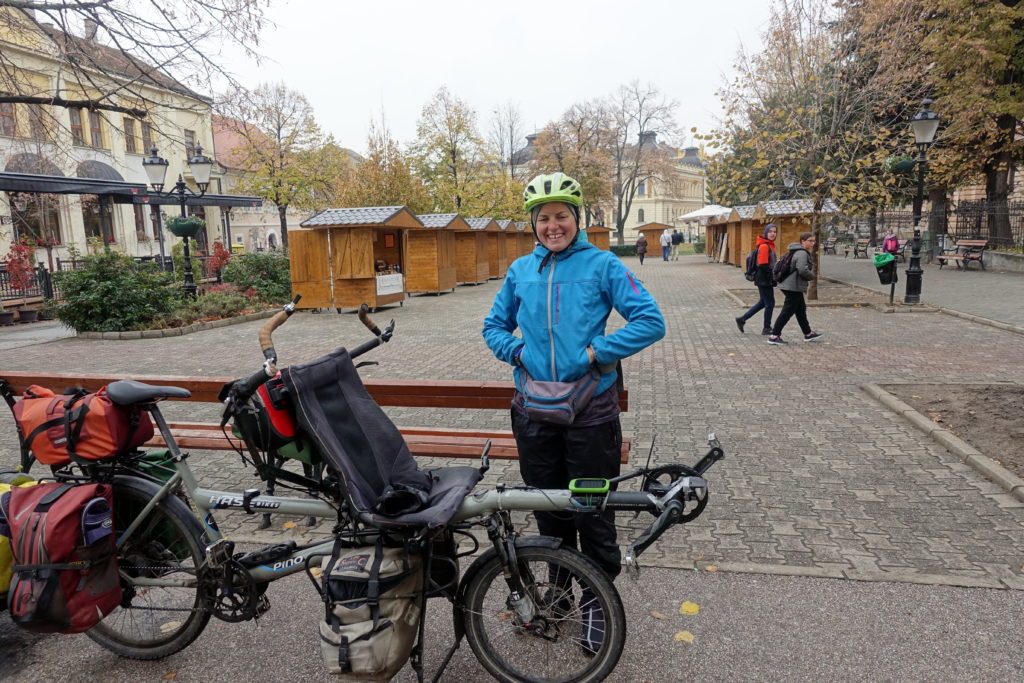
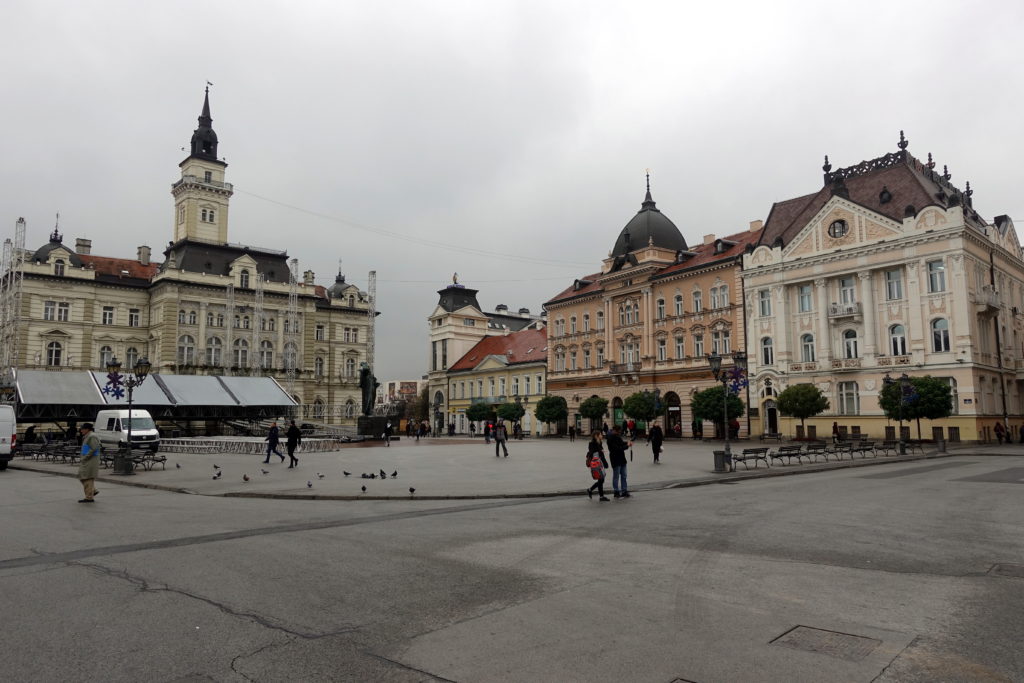
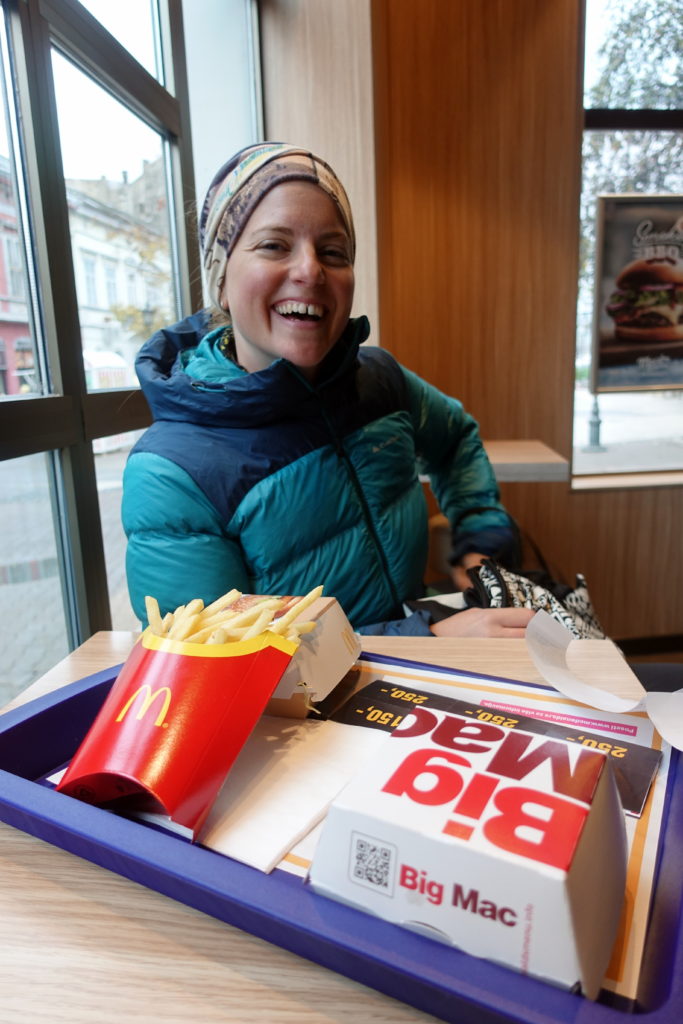

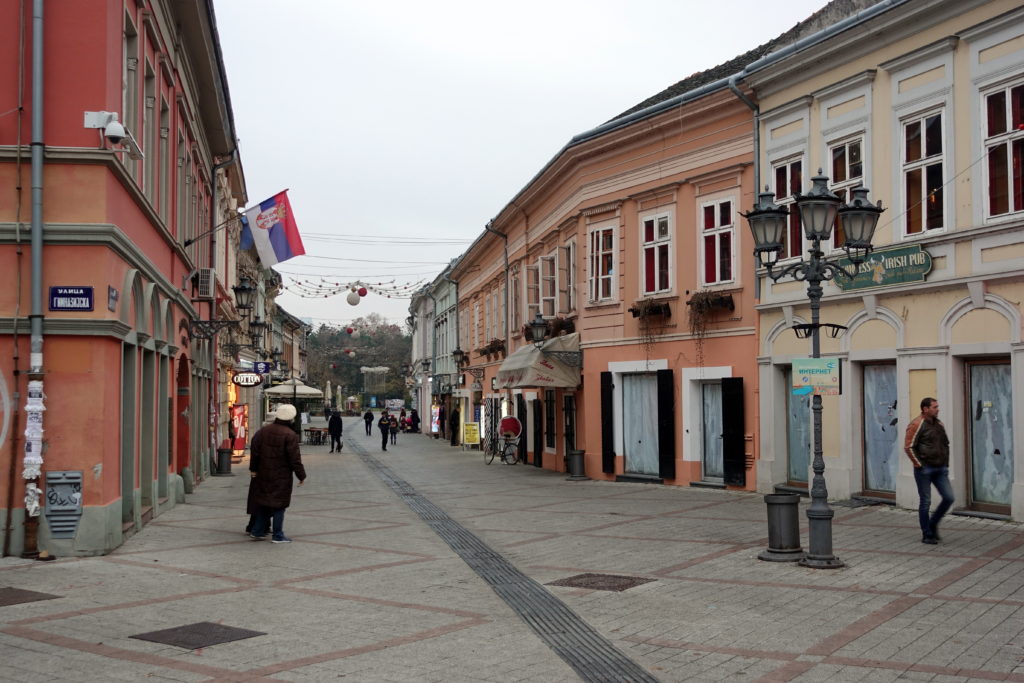
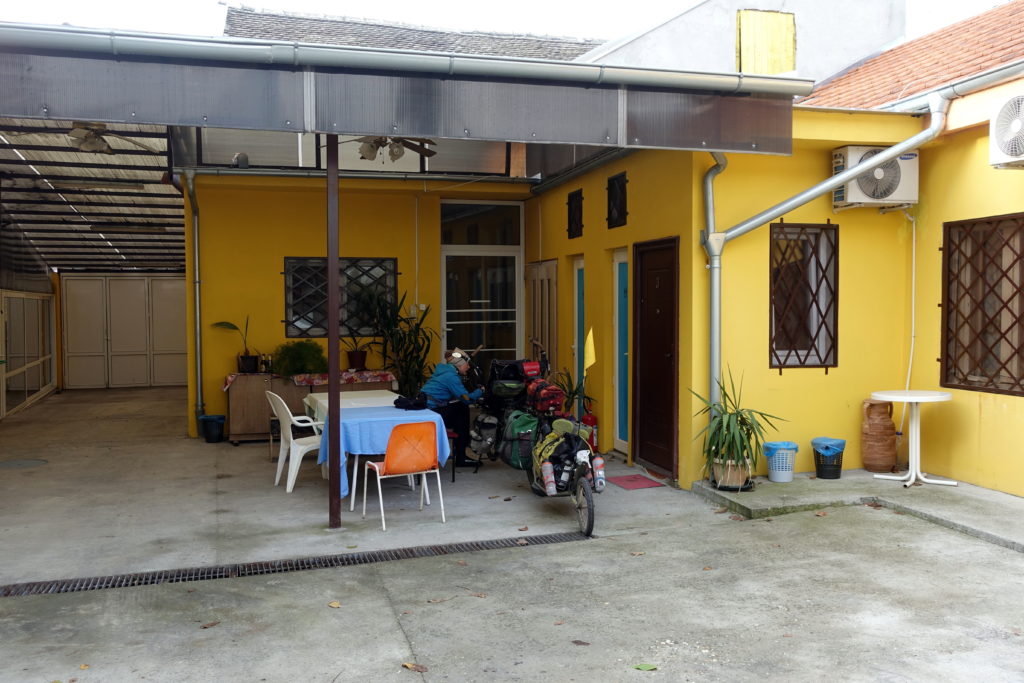
When we woke up the next day, it seemed like the bad weather was behind us (for now). We packed our things and decided to head for the Serbia-Croatia border. Cédric and I were getting tired of the traffic and the current hotel owners made us long for friendlier hosts – so we decided to give a different country a try. However, that first meant cycling with the traffic to Backa Palanka. For a kilometer or two outside of Novi Sad, we thought we found a newly paved bike path along the Danube (and the sight of a road cyclist made us hopeful), but the trail ended abruptly, so we pushed our bike back to the road. We got rid of our excess dinar (the Serbian currency) at the last supermarket and then crossed the Danube into Croatia. And just like that, the traffic disappeared. As we were riding through some small towns along river, we noticed that some houses were still riddled with bullet holes from the Croatian war of Independence. Many houses had a fresh coating of stucco, but some buildings bore scars as a testament to the war. Before finishing our day in Vukovar, we visited the military cemetery, which was another memorial to the war. Serbia is just across the river, and Serbians are not the souvenir of a good neighbor in here. The Balkans is now composed of many small countries that may look silly on a map, but the cultural difference is still significant – it is never sufficient for wars, but within a few kilometers we went from an industry-based Christian orthodox country to a Catholic wine growing touristic region.
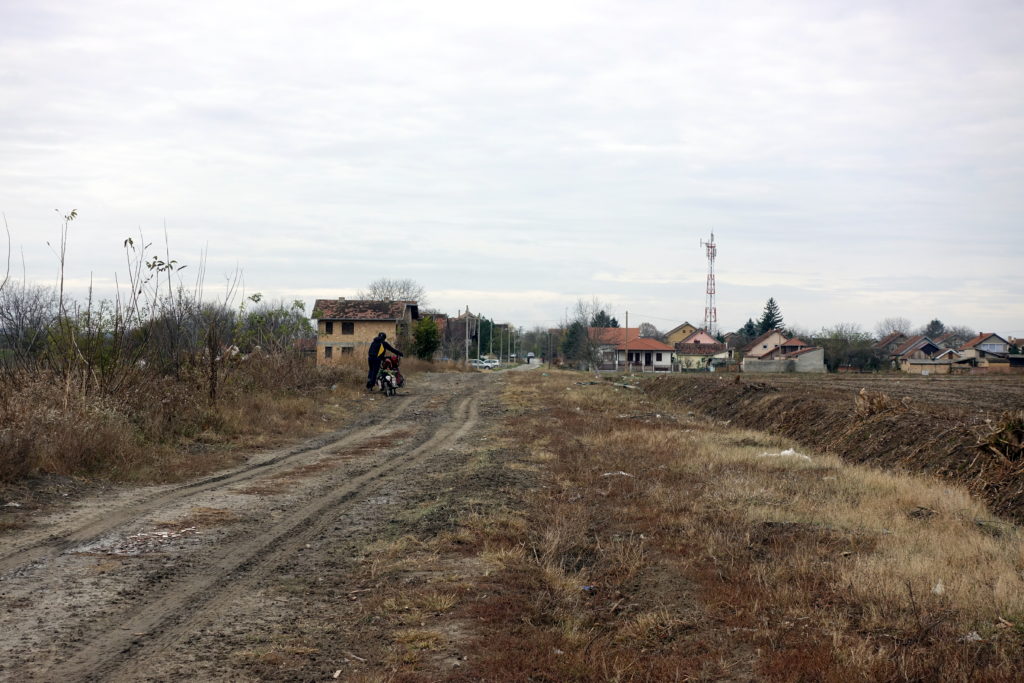
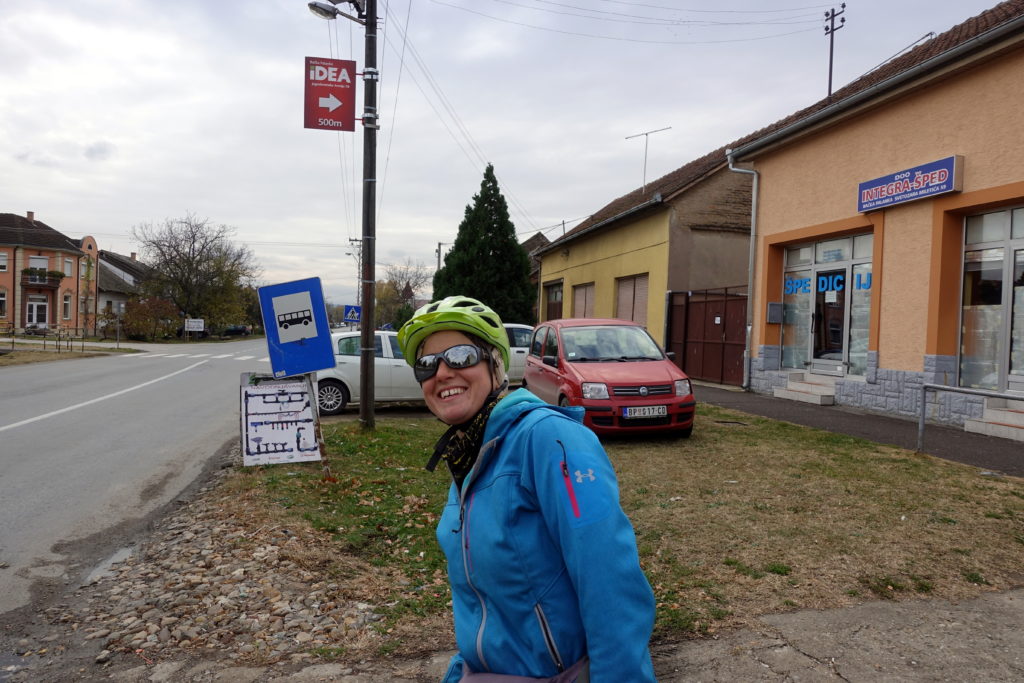
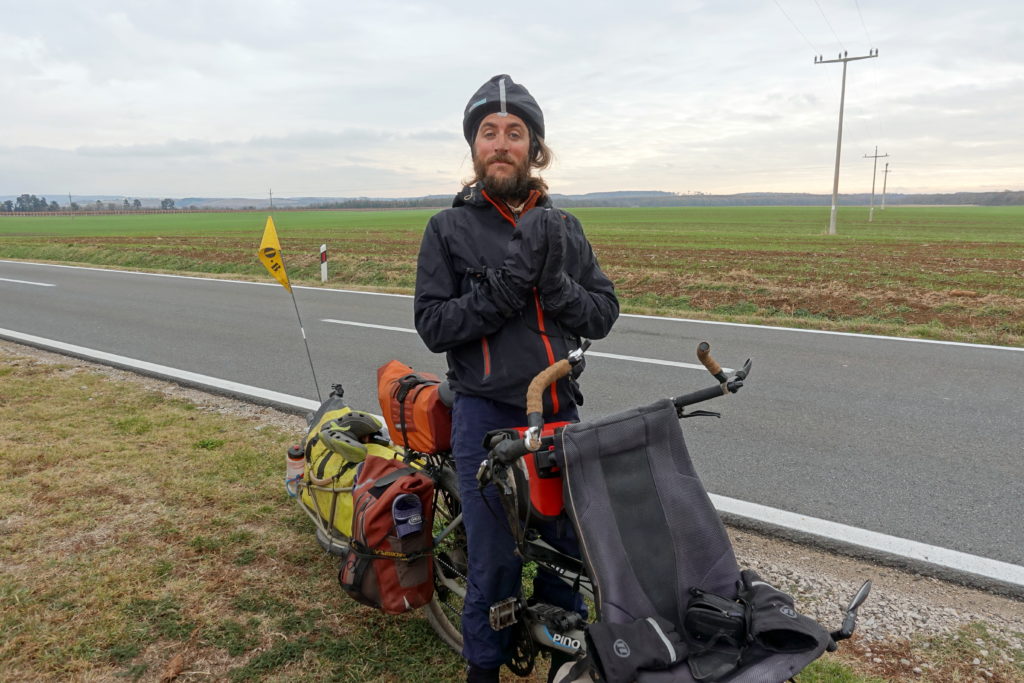
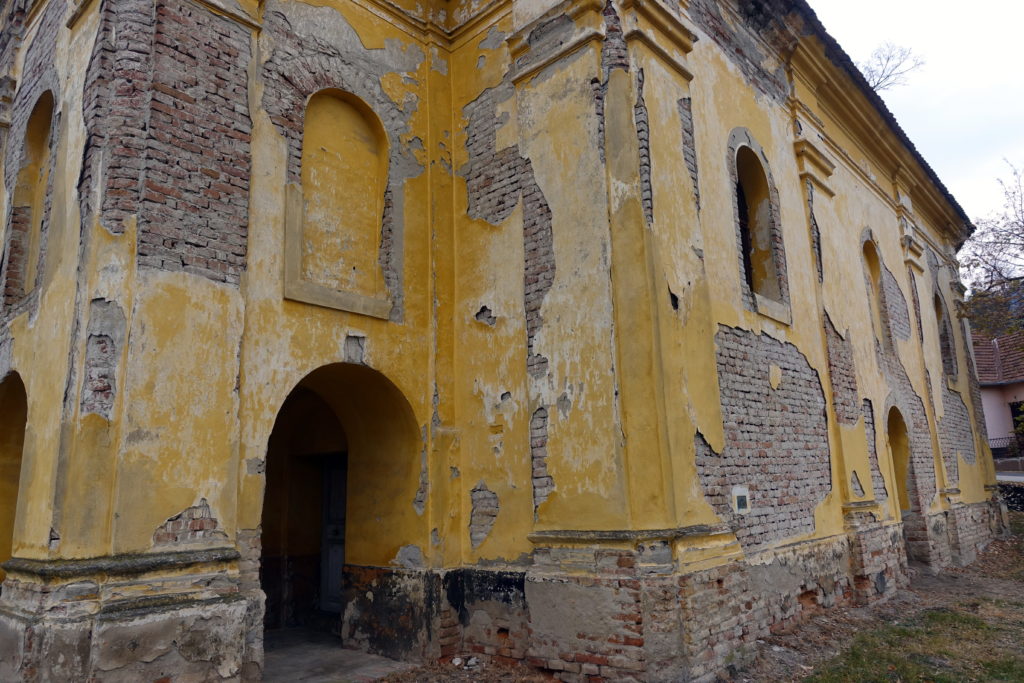
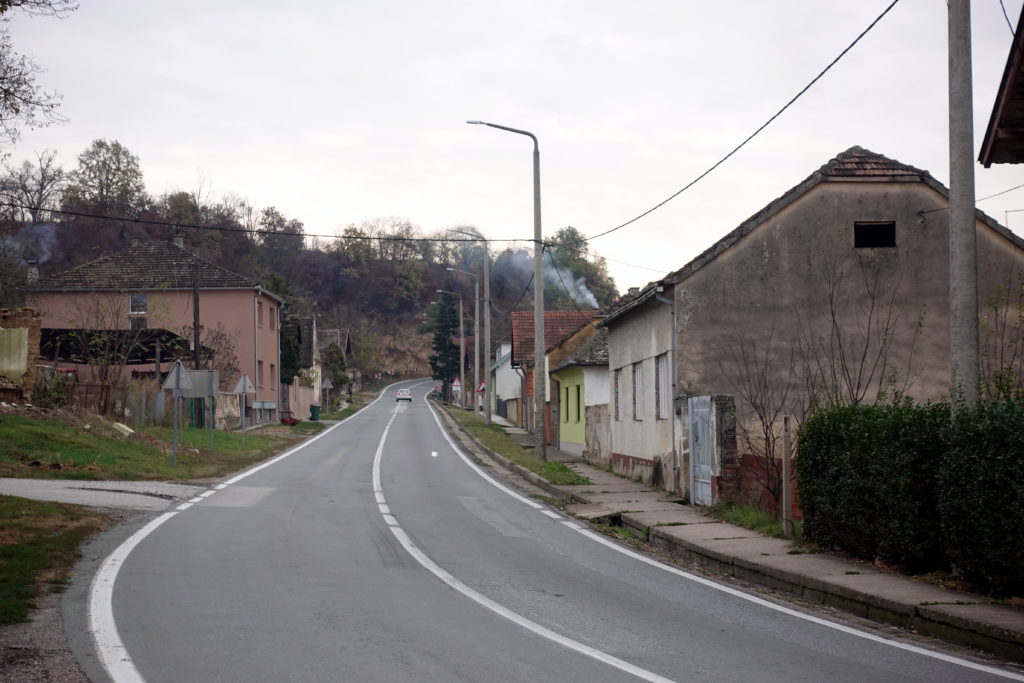
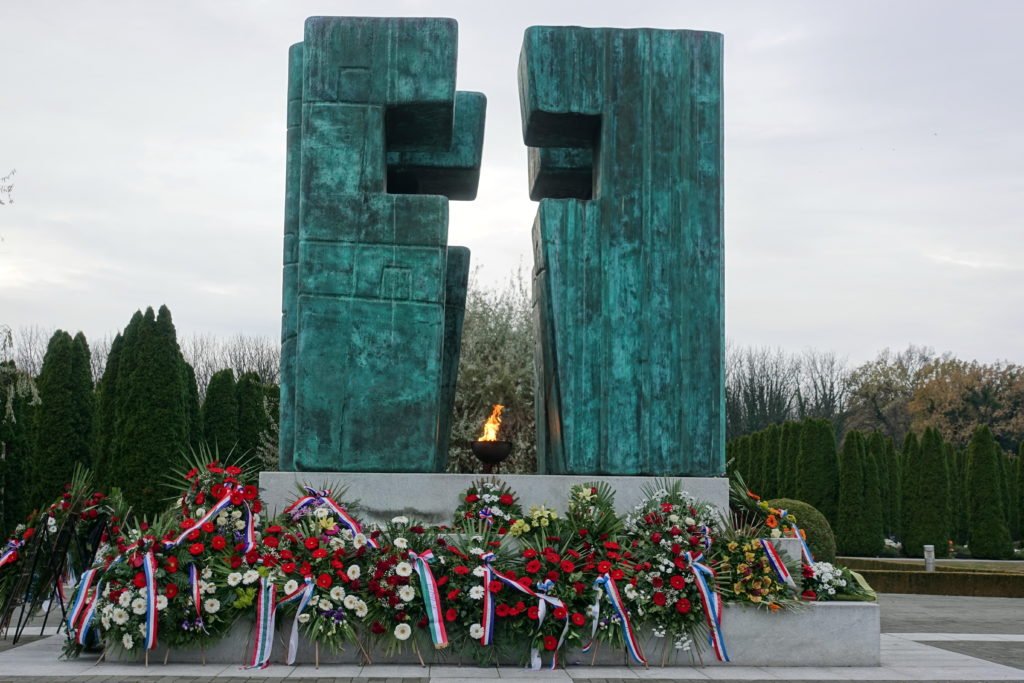
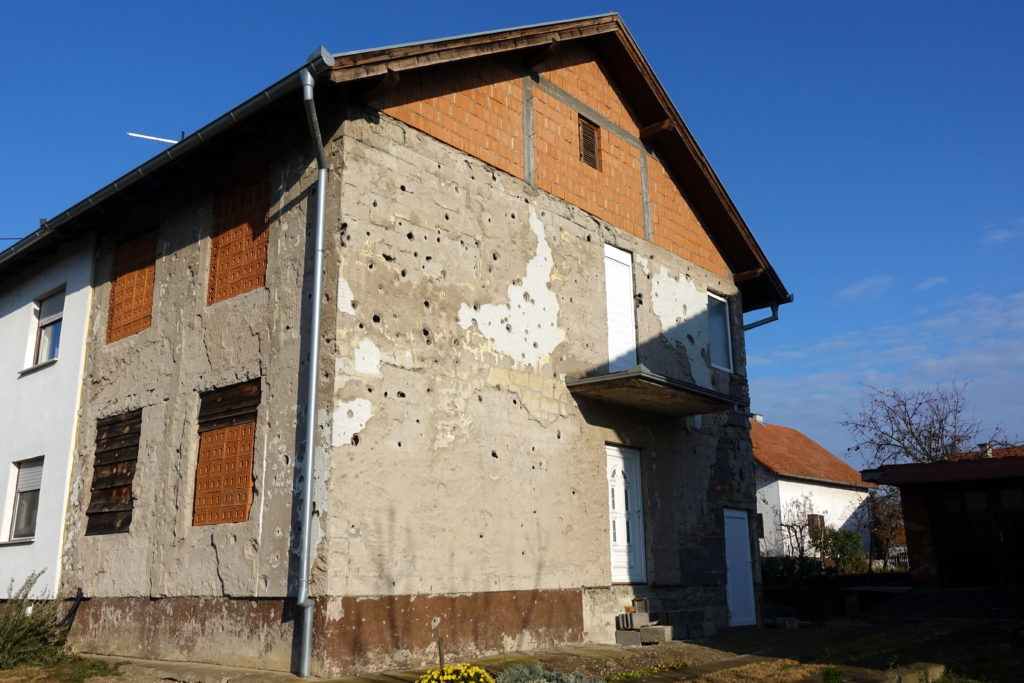
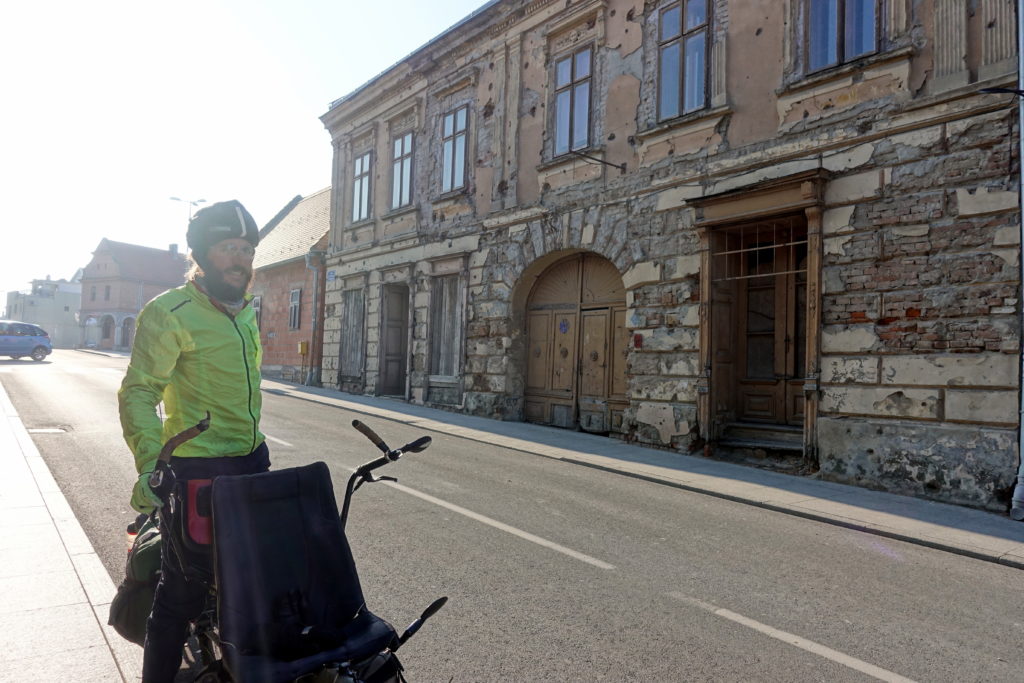
The next morning, we left Vukovar with brilliant blue skies and continued our journey north. Again, without many other options, we had to join a larger, more trafficked road on our way into Osijek. When we cycled into the city, we were greeted by bike lanes (they’re becoming more prevalent to more north we go) and stopped in the Tvrda, an old 18th century fortress built by the Hapsburg Empire. Heading west down the main street, we were surprised to see multiple Art Nouveau buildings lining the streets – coming from places with cheap, new construction projects, cinderblock houses, or soviet-style apartment buildings, this immediately gave us the feeling of being in Western Europe. We wandered around the downtown to look for a lunch spot, and finally found a boat restaurant on the shores of the Drava river. In the afternoon, we cycled through small villages and farmland to get to Valpovo, where we called it a day.
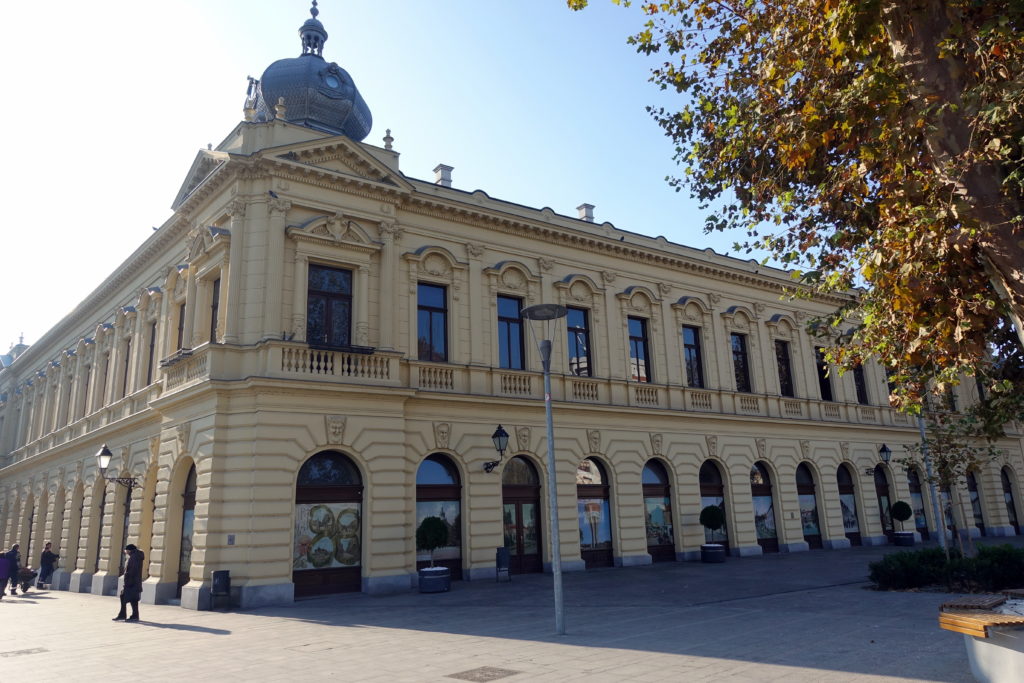
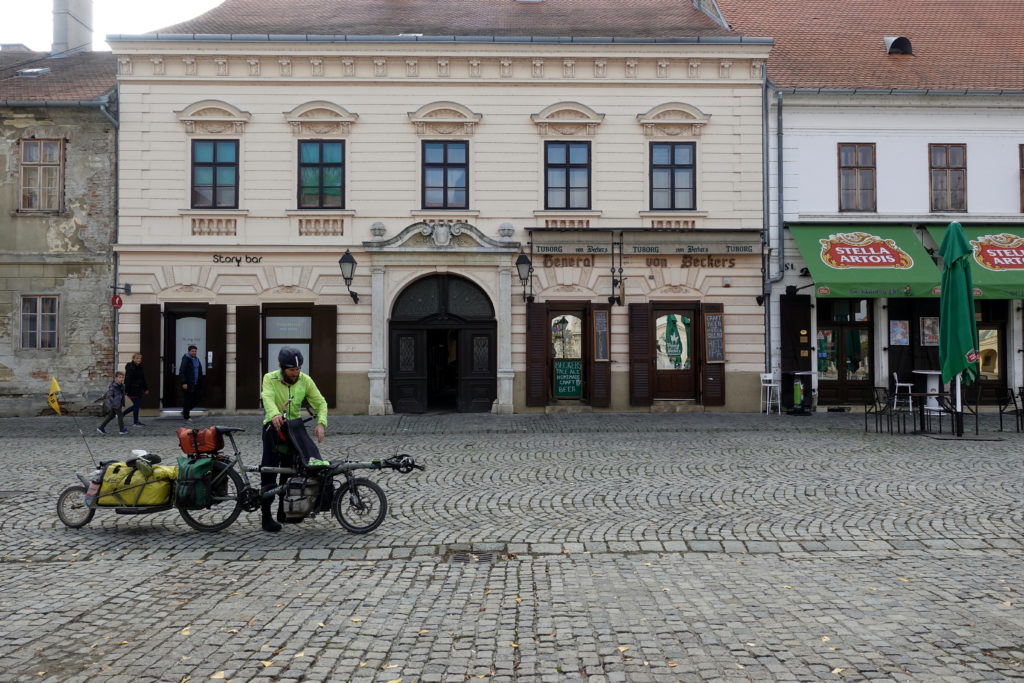
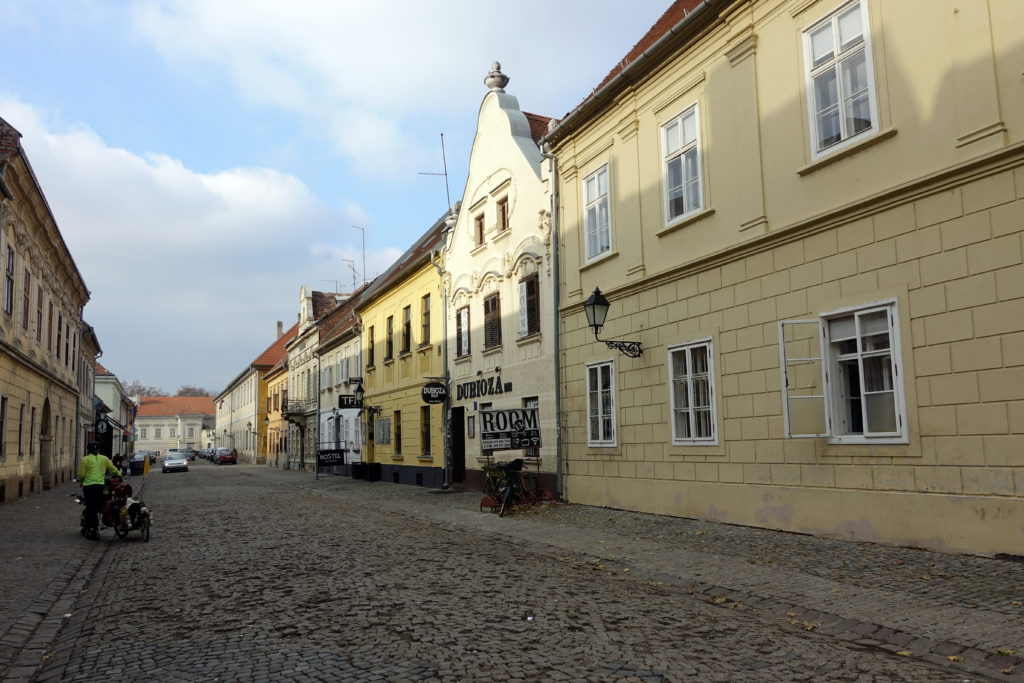
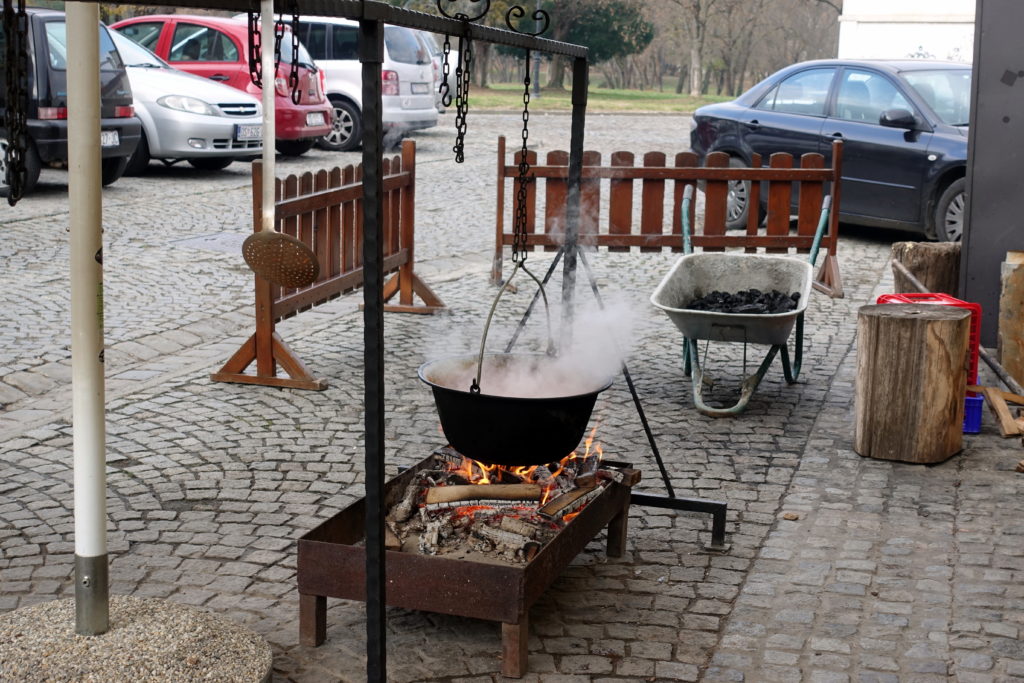
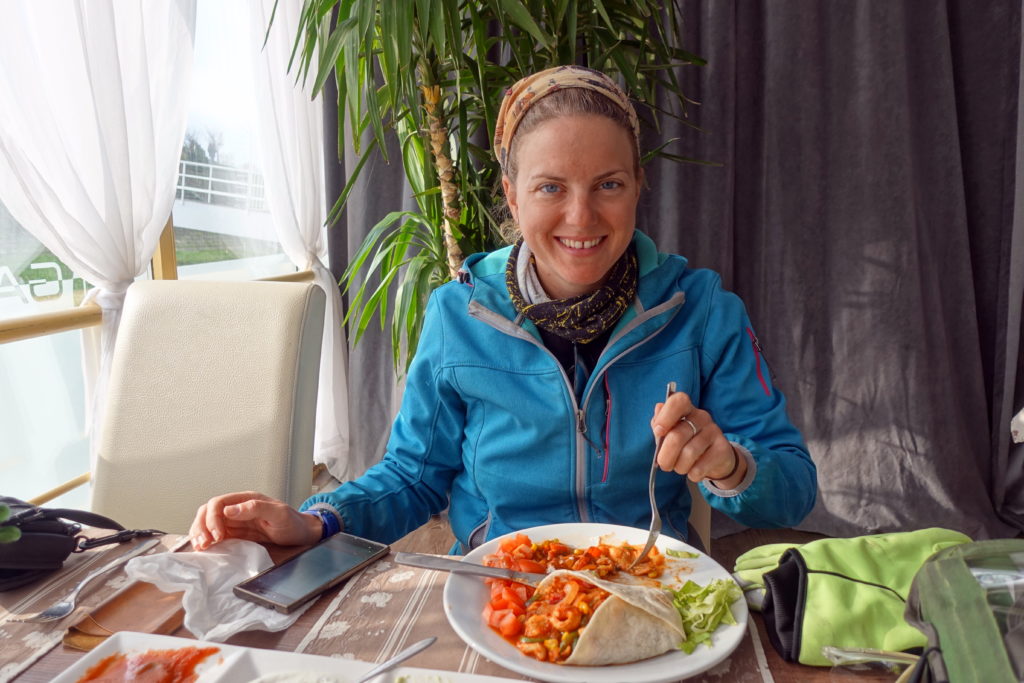
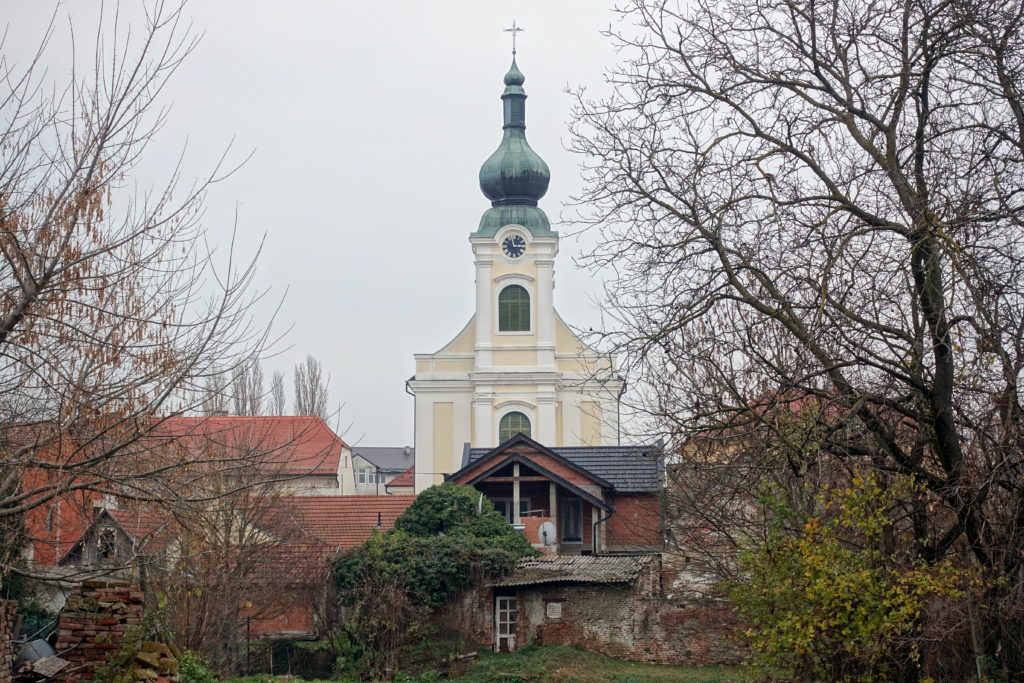
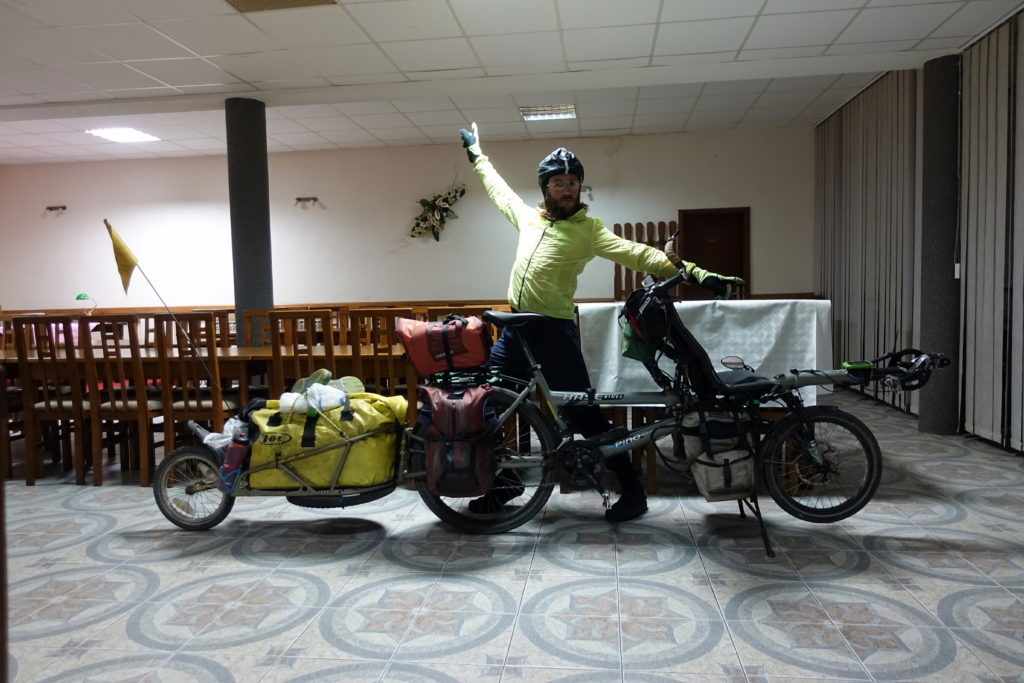
By the time we packed our bike the next morning, we noticed that the gray clouds were promising rain for our ride. Our plan for the day was to cross the Croatia-Hungary border and ride towards Pécs. Leaving Valpovo around 9am, we crossed the Drava River and continued north to the border town. The Hungarian border, with its new fencing and barbed wire, flanked us to the left and was a reminder of Hungary’s harsh stance against refugees and migrants. Shortly before the border, we met a few guys who where slaughtering and smoking a pig and offered us a few shots of their homemade schnapps, but we didn’t feel quite up for drinking at 10:30 in the morning. Just as we crossed the border into Hungary, it started to sprinkle and didn’t let up. We rode through small picturesque villages with their rows of wine houses and the wine bars in Villany. This would have been a perfect area to explore on a summer day, but we were determined to find a dry room in Pécs, so we continued cycling. When we arrived in the afternoon, Cédric and I dropped off our soaking wet bags and went out to explore the city while there was still some daylight. We had a bit of luck and the rain stopped just as we arrived in the city. Many downtown buildings were built at the turn of the 20th century and exhibit a neo-baroque style, but there are other vestiges of former periods and rule of other Empires, like a mosque-turned-church built during the Ottoman occupation and church foundations built during the Roman Empire. Our first reaction was that cities in Europe are definitely the most beautiful, sorry the rest of the world (okay, other countries or continents have other good things)!
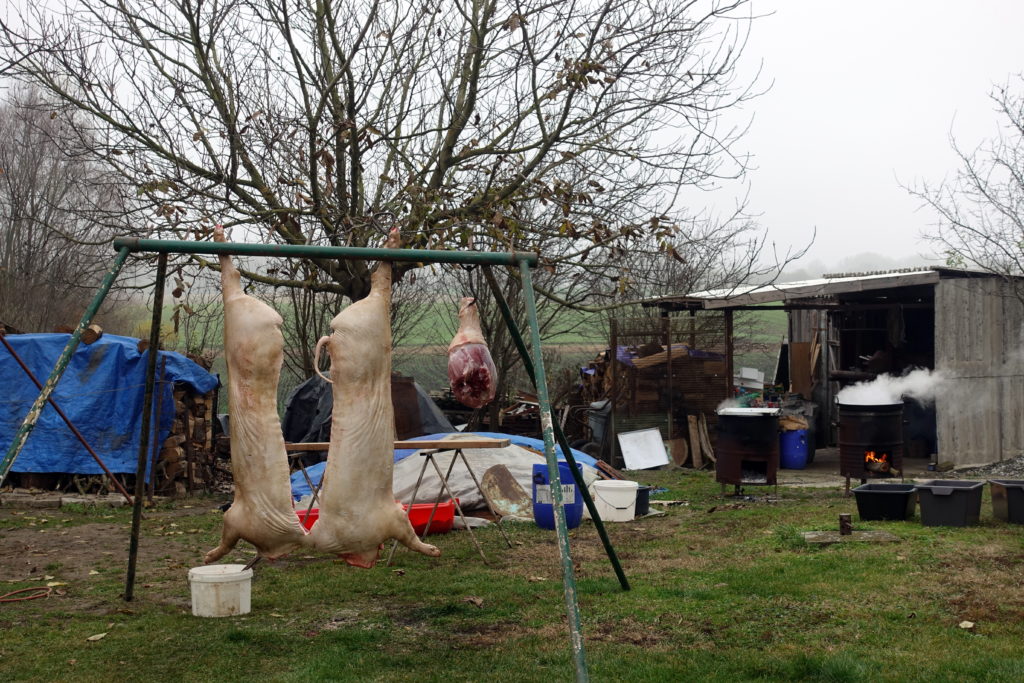
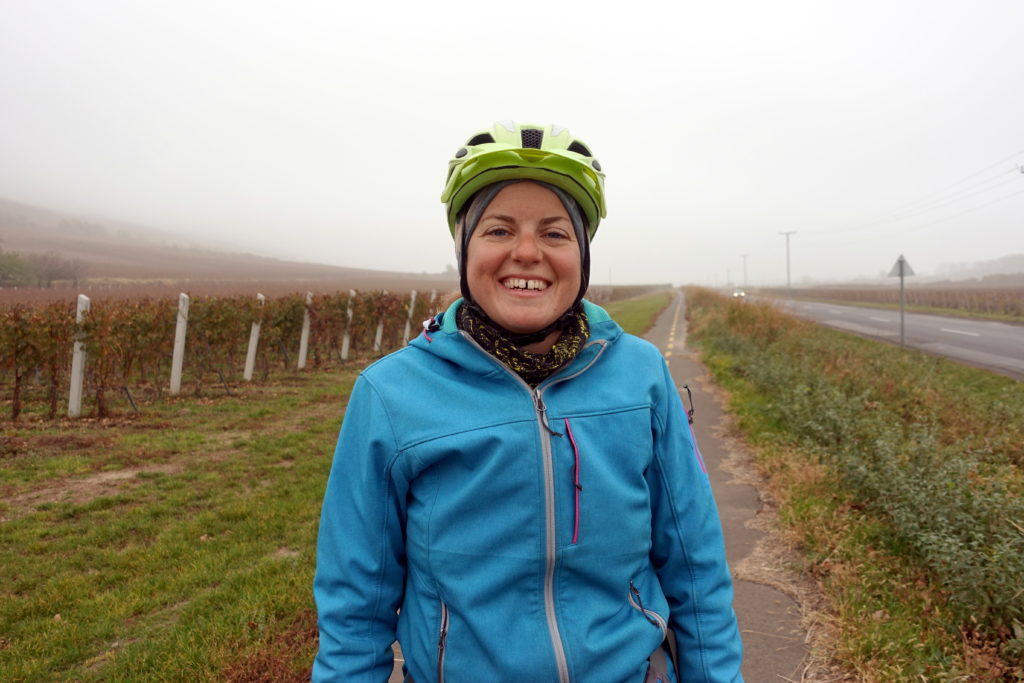
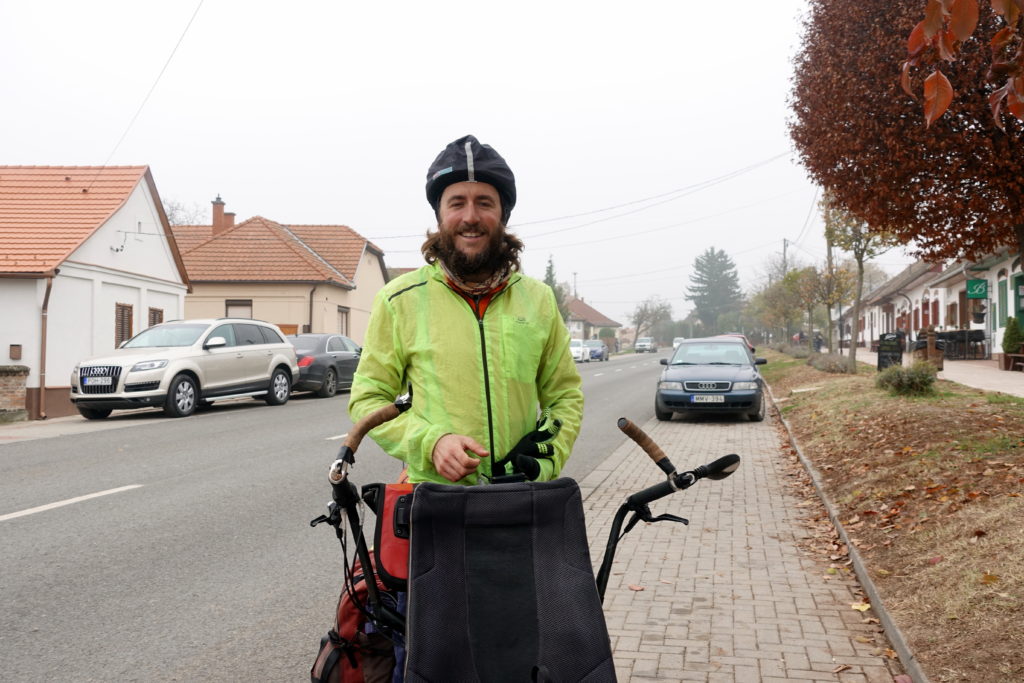
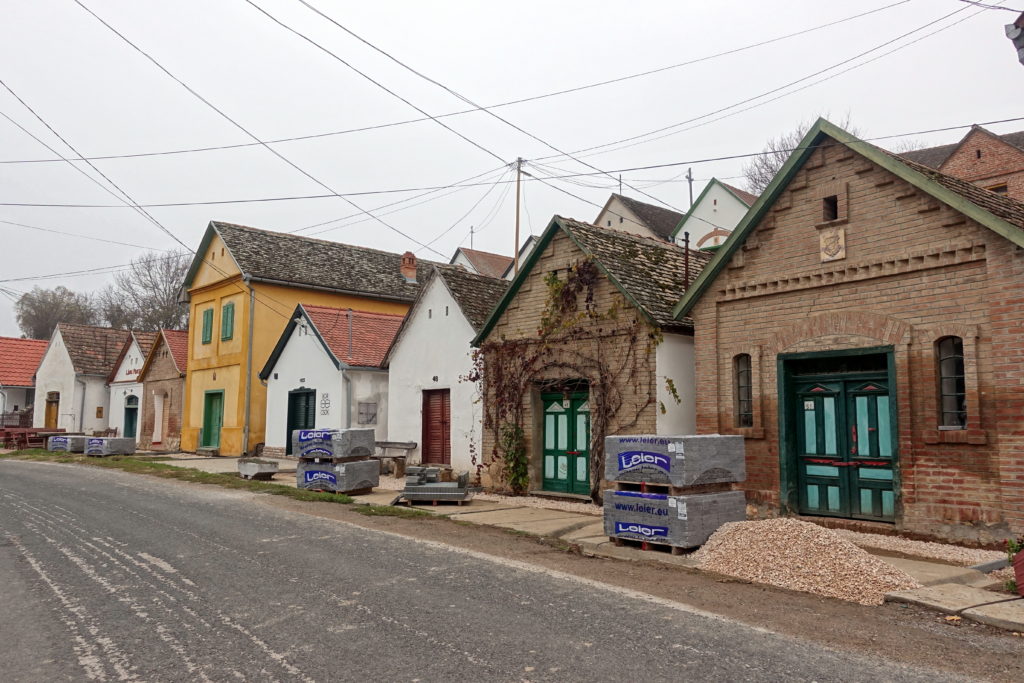
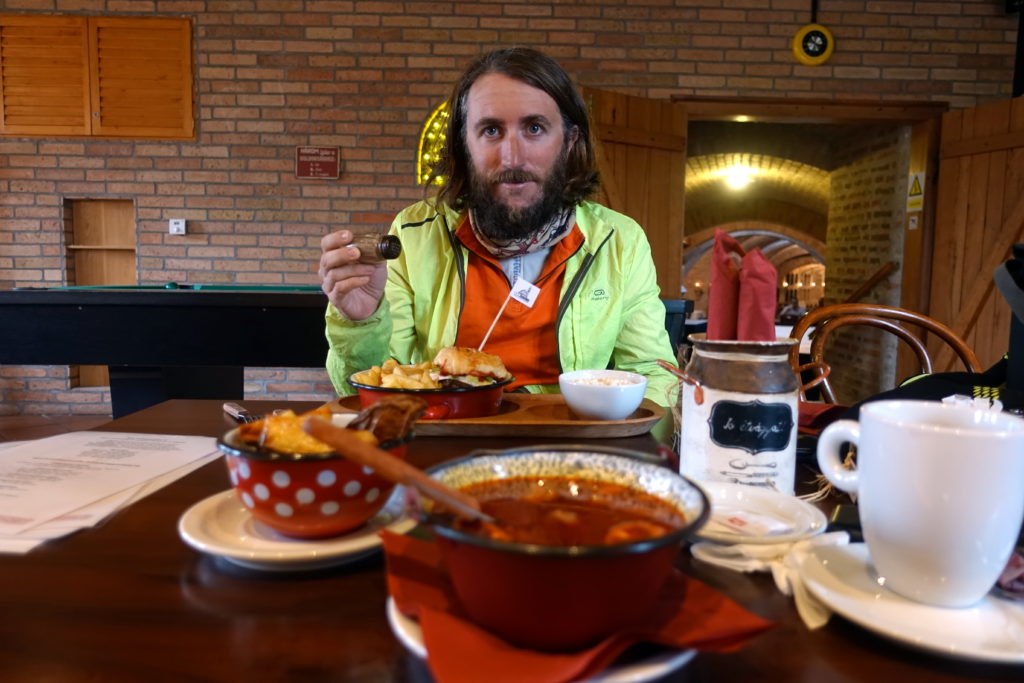
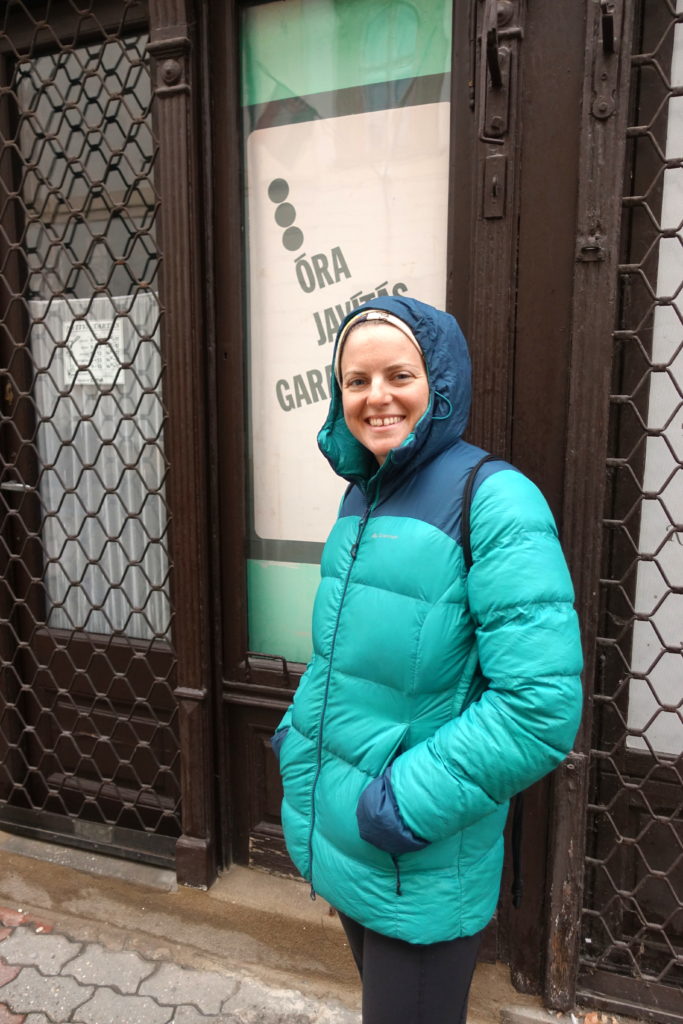
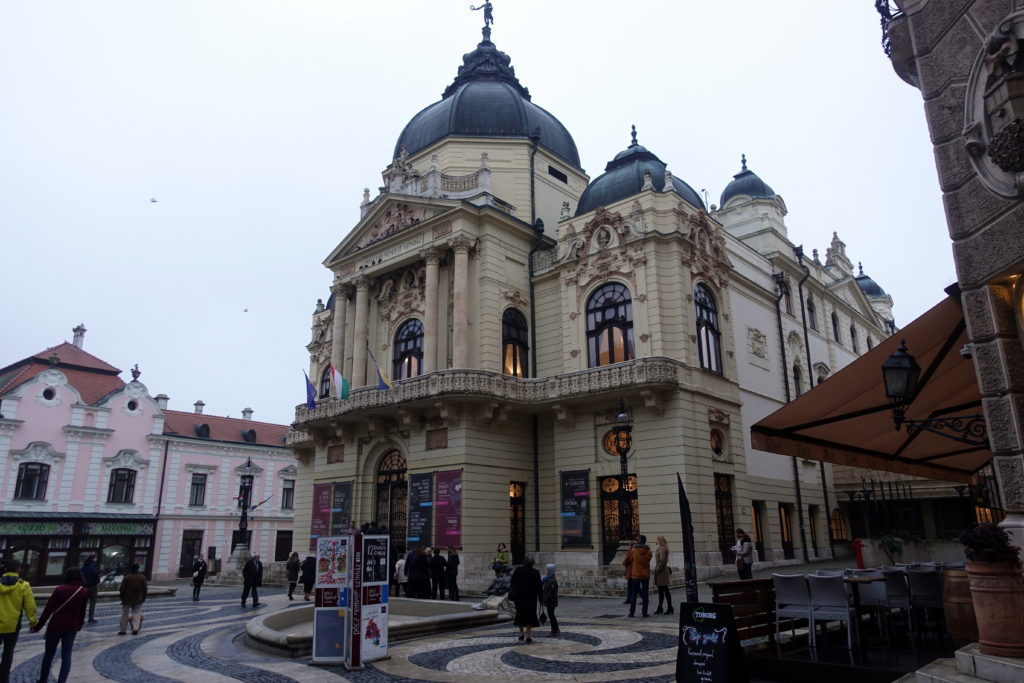
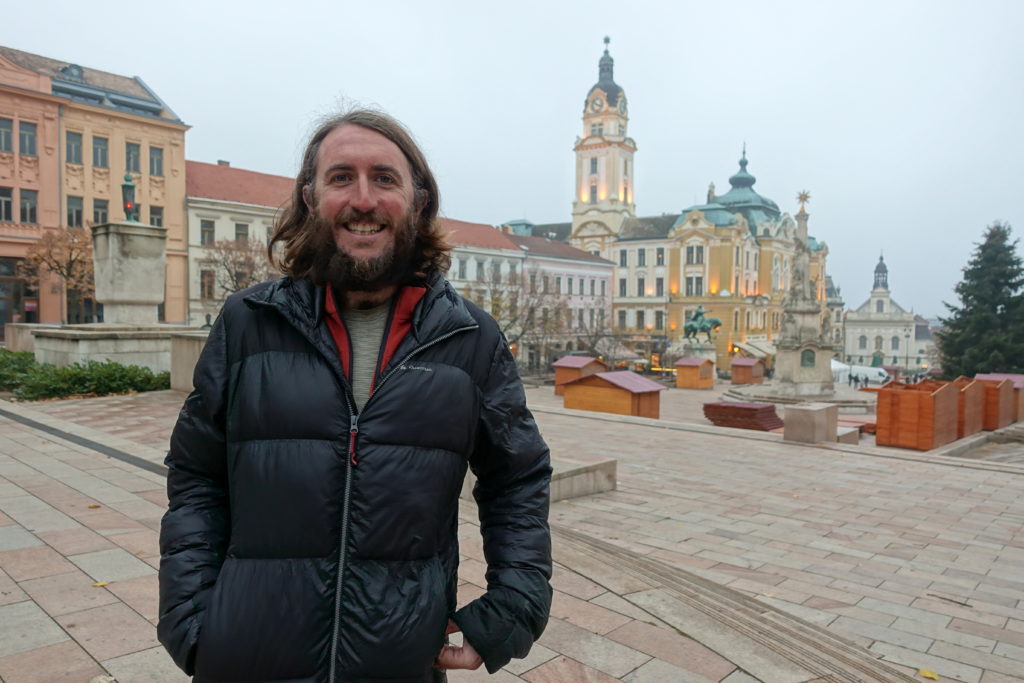
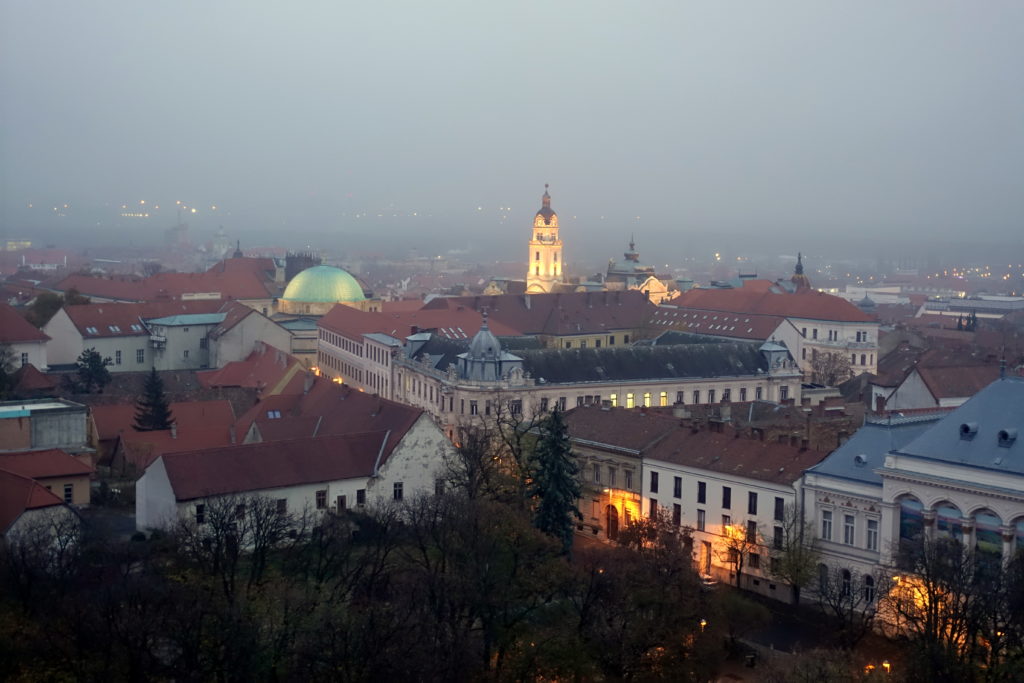
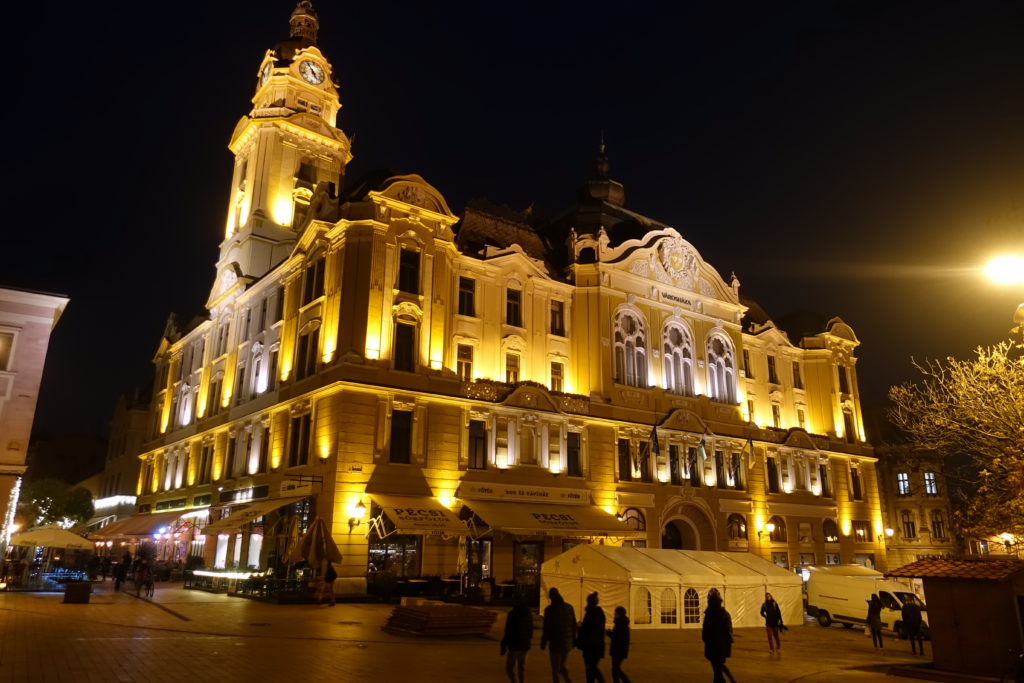
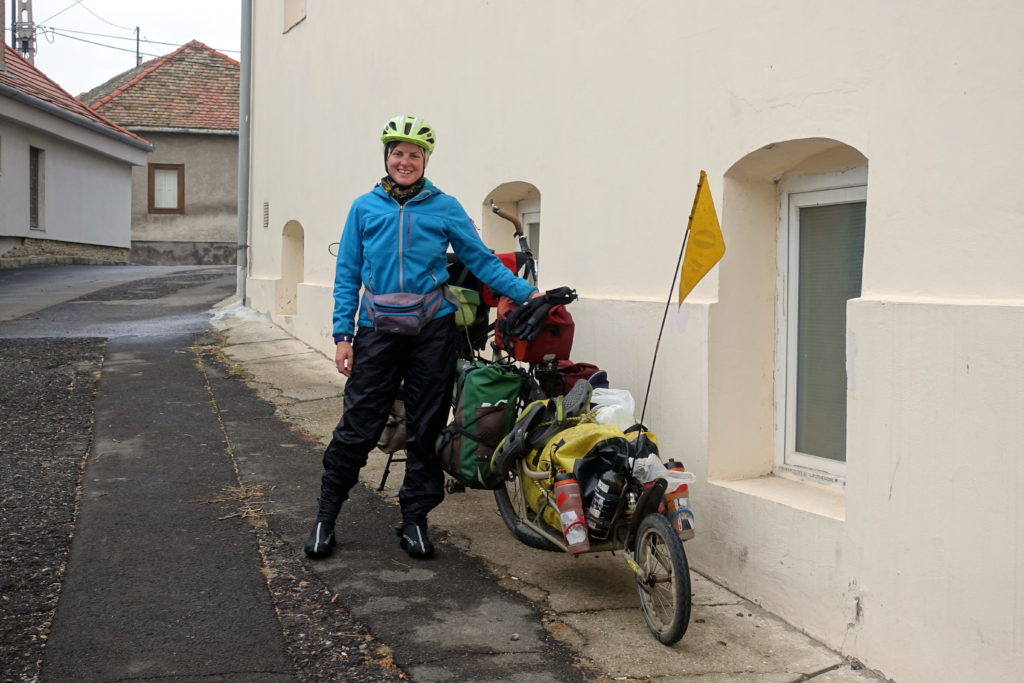
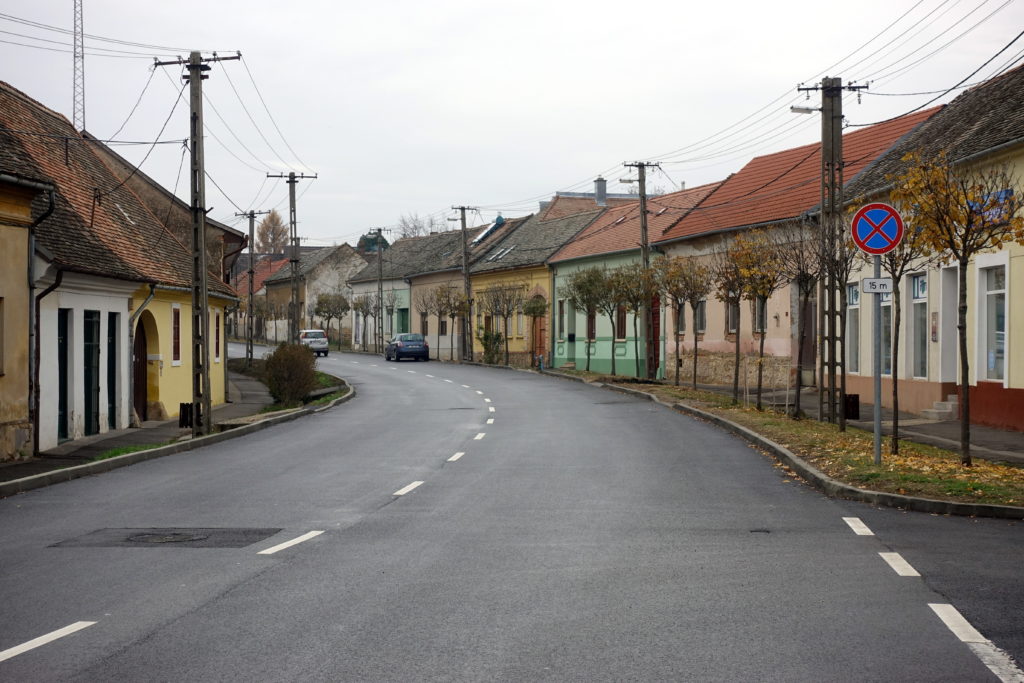
The next morning, the bits of the sun were poking through the clouds, and we were thinking that we’d have an enjoyable ride into Szekszárd. Due to the rain from the previous day, Cédric diligently oiled our gears and chain, but we discovered that the lubrication exacerbated a growing problem with our drivetrain: one of the chainrings was so worn down that the greasy chain would just slip over the teeth. This is a big problem because only one person is transmitting the force to move our iron horse. After 45 minutes of unsuccessful meddling, we managed to set things right with a well-placed zip-tie putting more tension on the chain and thus sticking it onto the chainring.
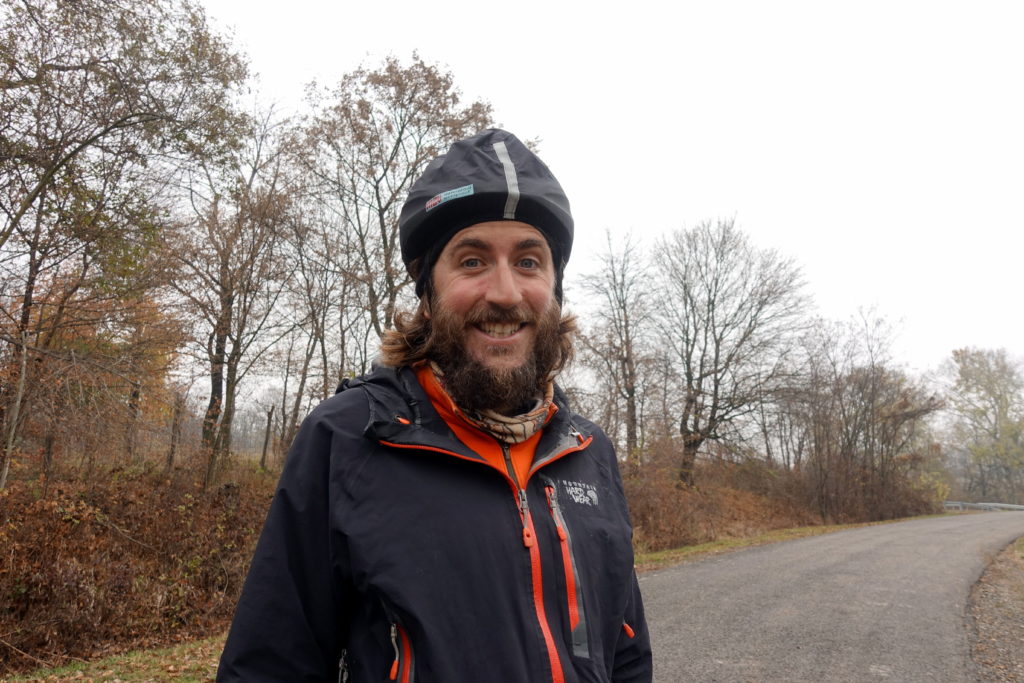
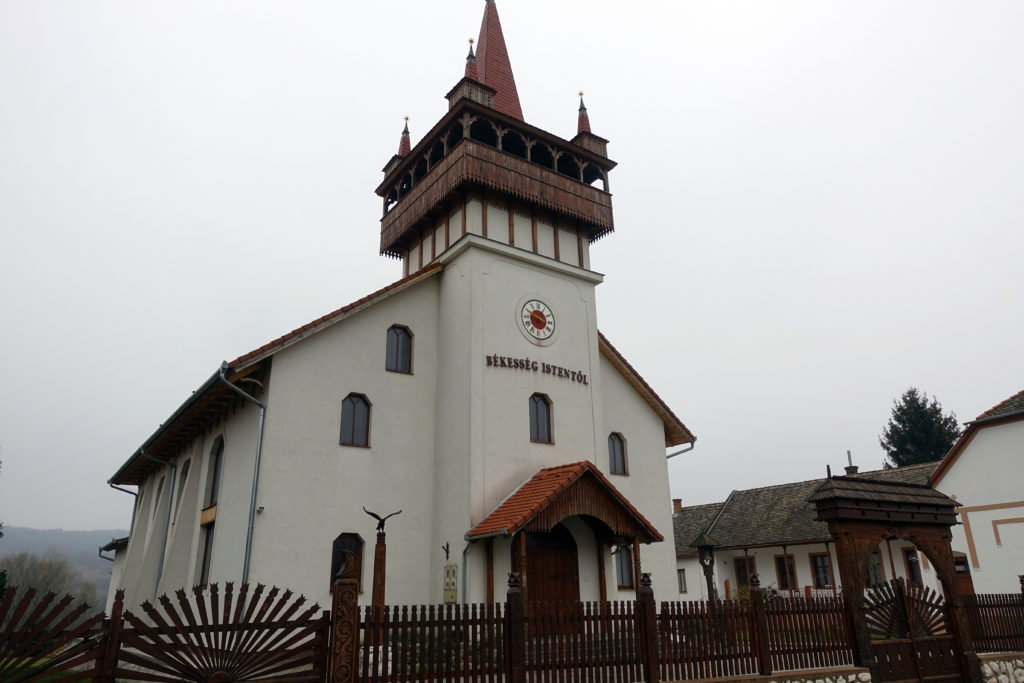
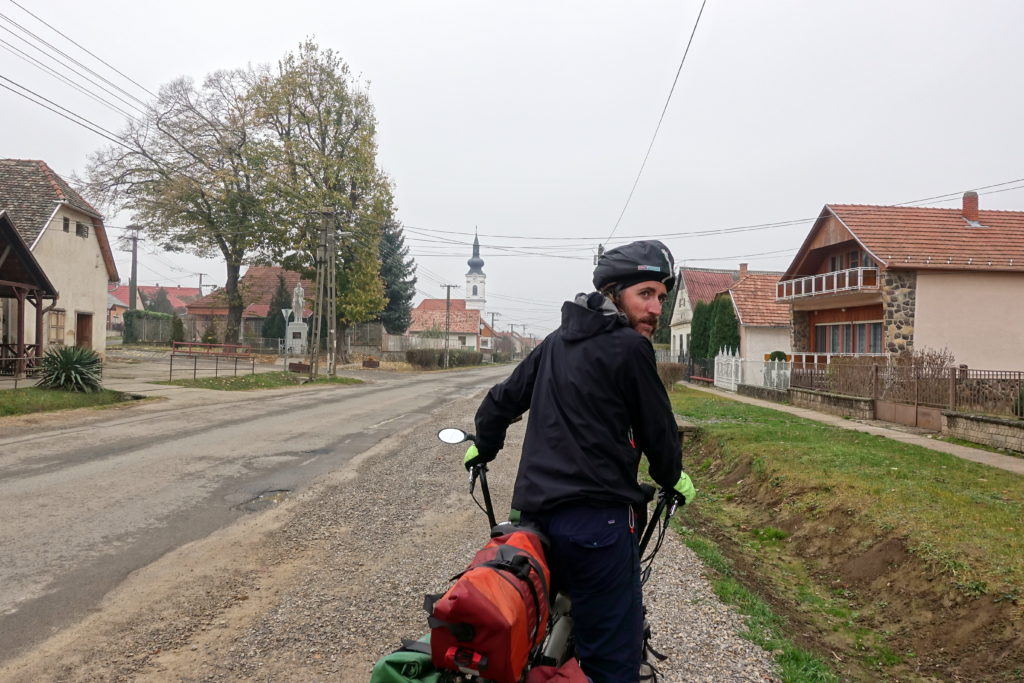
Upon leaving Pécs, we followed some hilly secondary roads north. Hungary is also the first country in Europe where we saw ‘No bicycle’ signs on the more-trafficked roads (which is probably a good thing, as those roads mean in Hungary that there is a quiet alternative nearby), but this meant that we spent the day swerving through the hills to stay on the correct roads. Hungary was also the first country where we met many people cycling as a hobby or sports – after all countries we visited, doing (and no watching!) sports is apparently mostly a western countries thing. Around lunch time, the heavens once again opened up and we were rained on the rest of the day. Towards the end of the day, we arrived in Szekszárd in a downpour and were happy to find our warm apartment for the night.
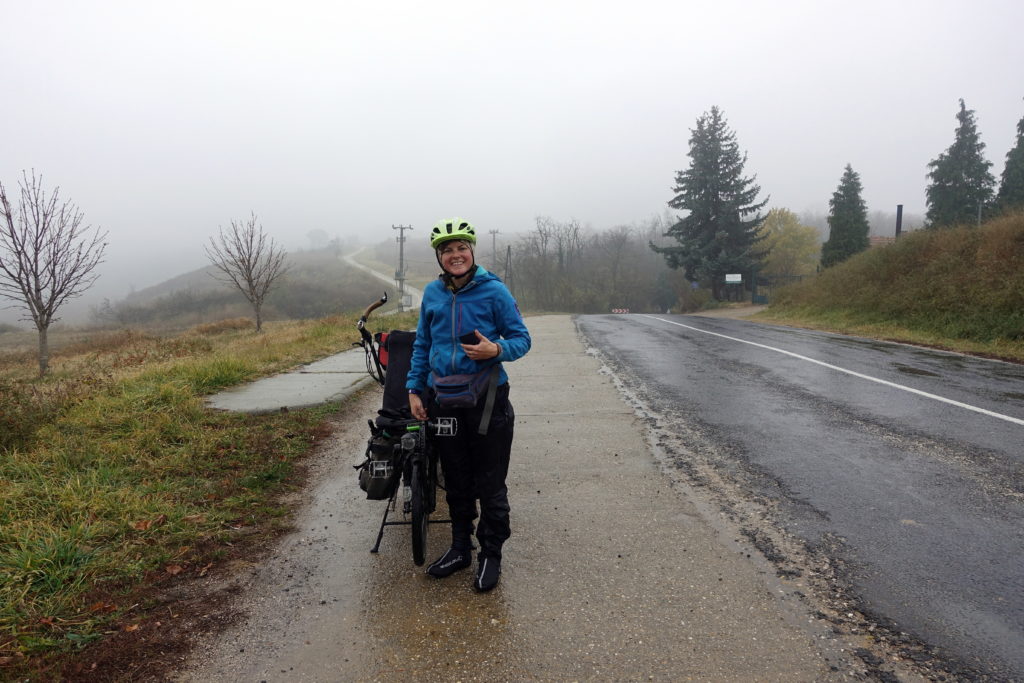
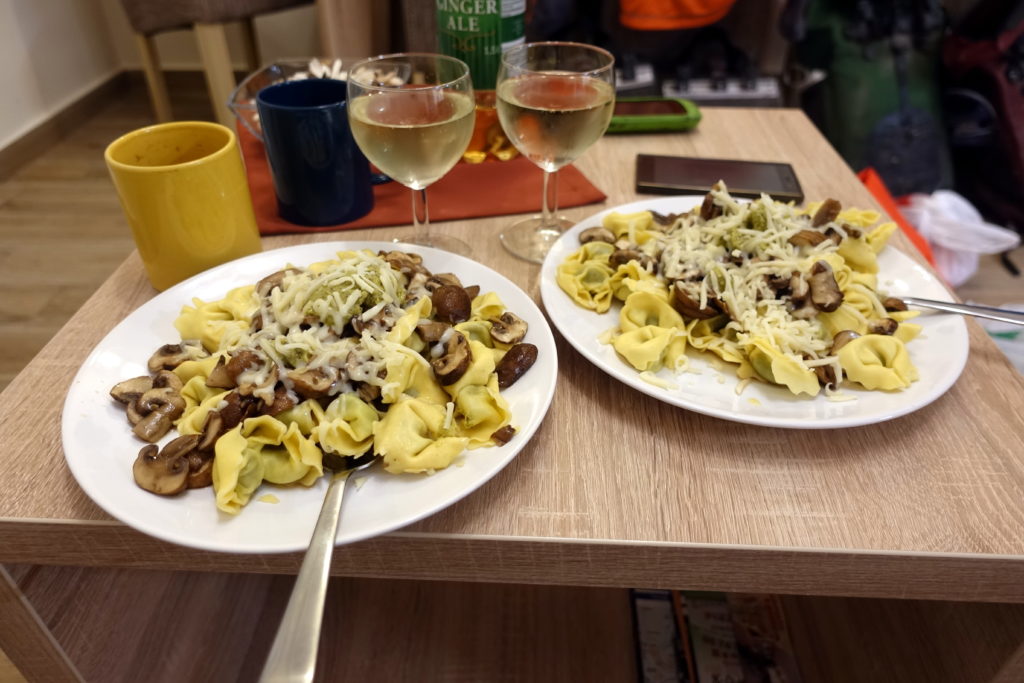
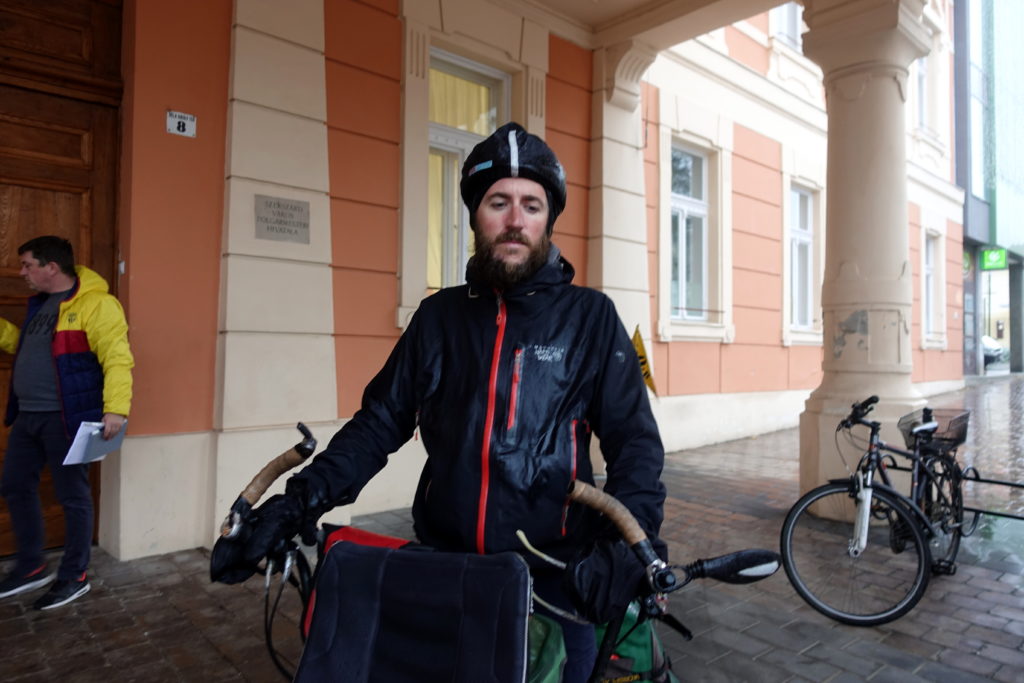
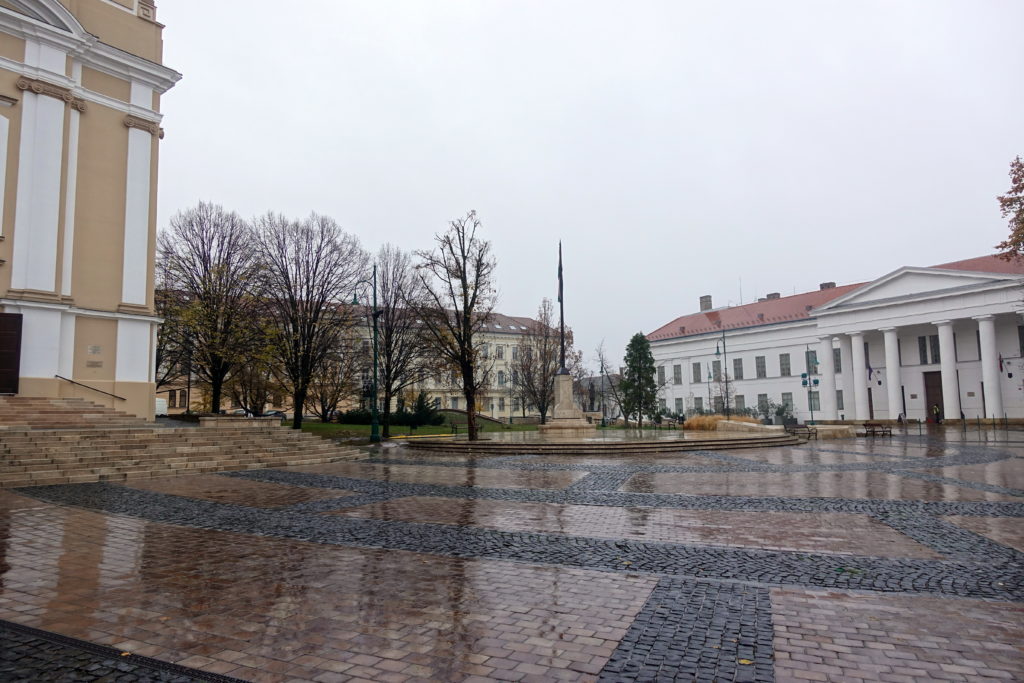
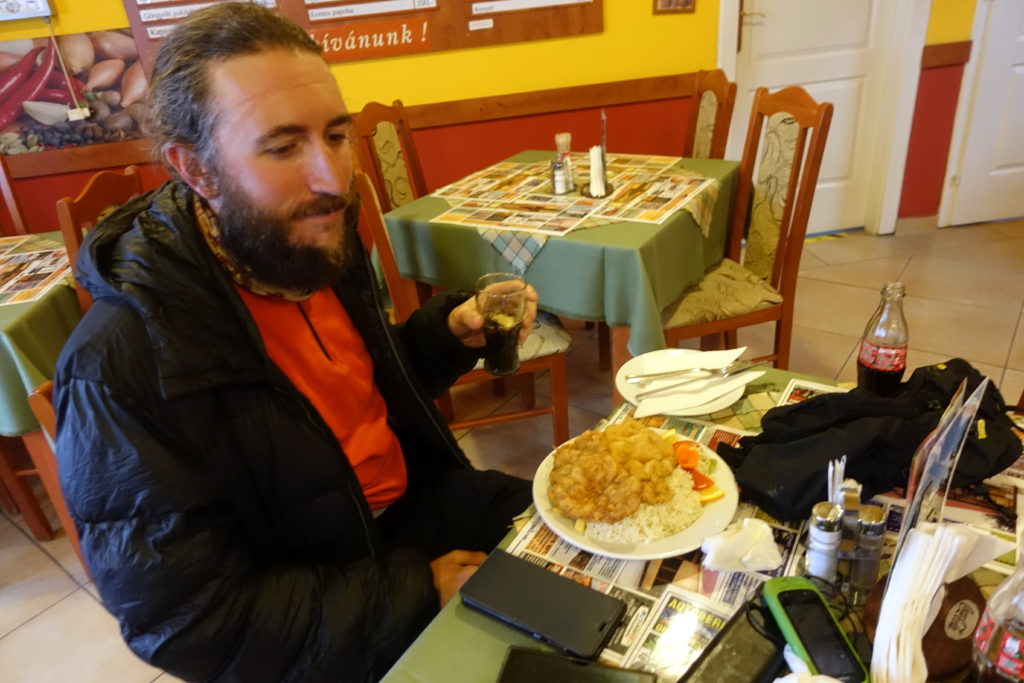
– leave at 9am
– shut-up and cycle non-stop until lunch
– when frozen enough, soaking wet and hungry stop in a local shack for lunch
– find a heater to try to dry gloves and jacket, possibly change the sweater, T-shirt or anything completely wet
– cycle non-stop with the sunset time in mind (i.e. avoid arriving after 3pm)
– spend the rest of the evening drying everything and huging the heaters at max level
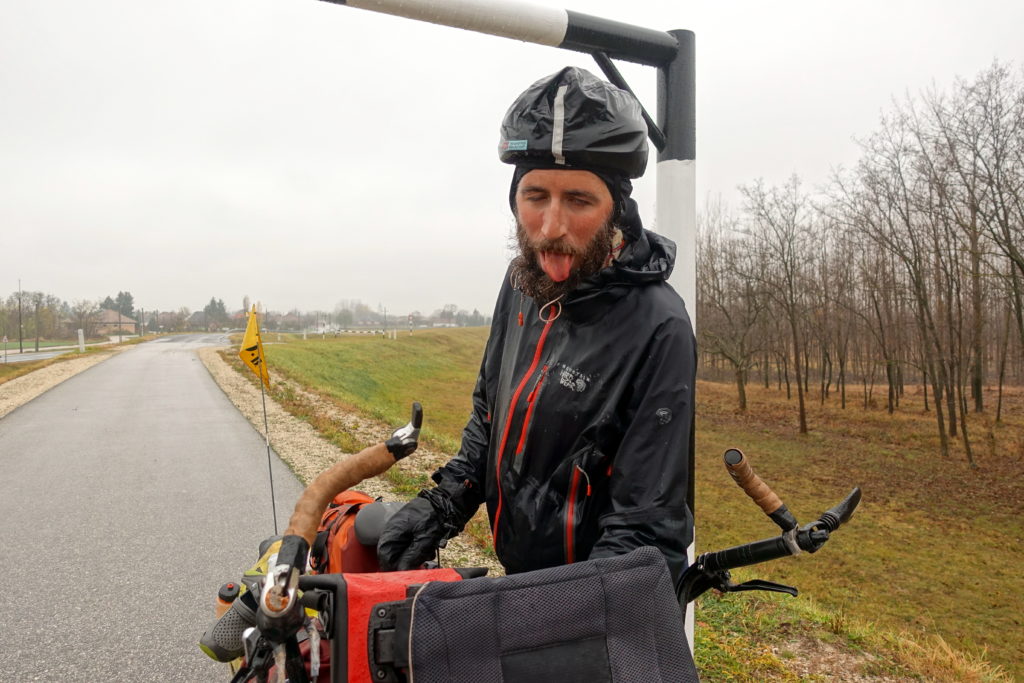
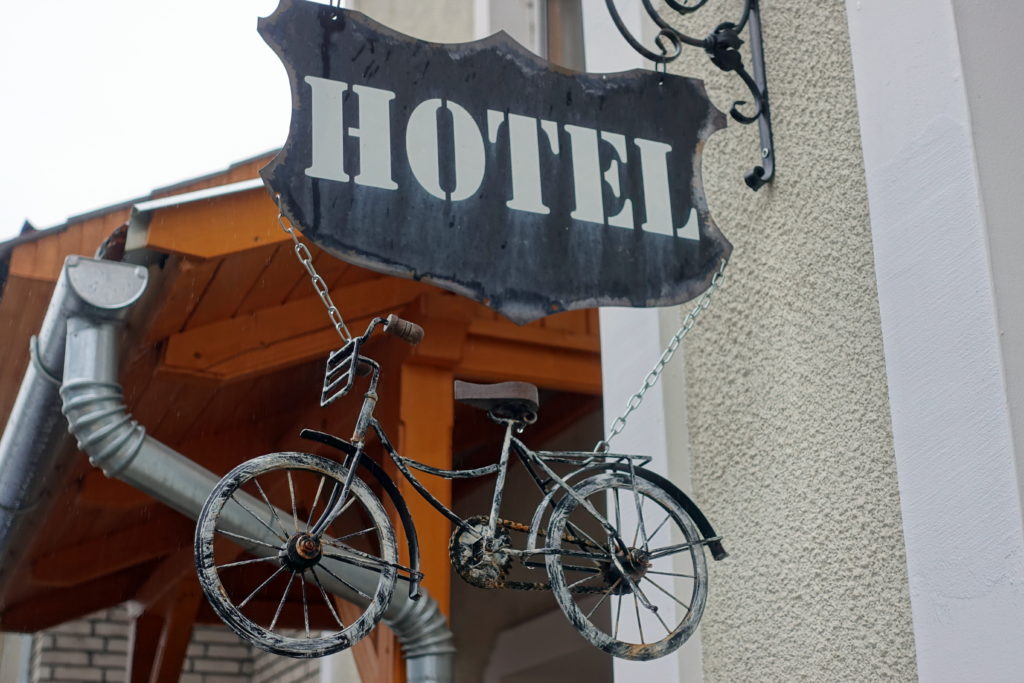
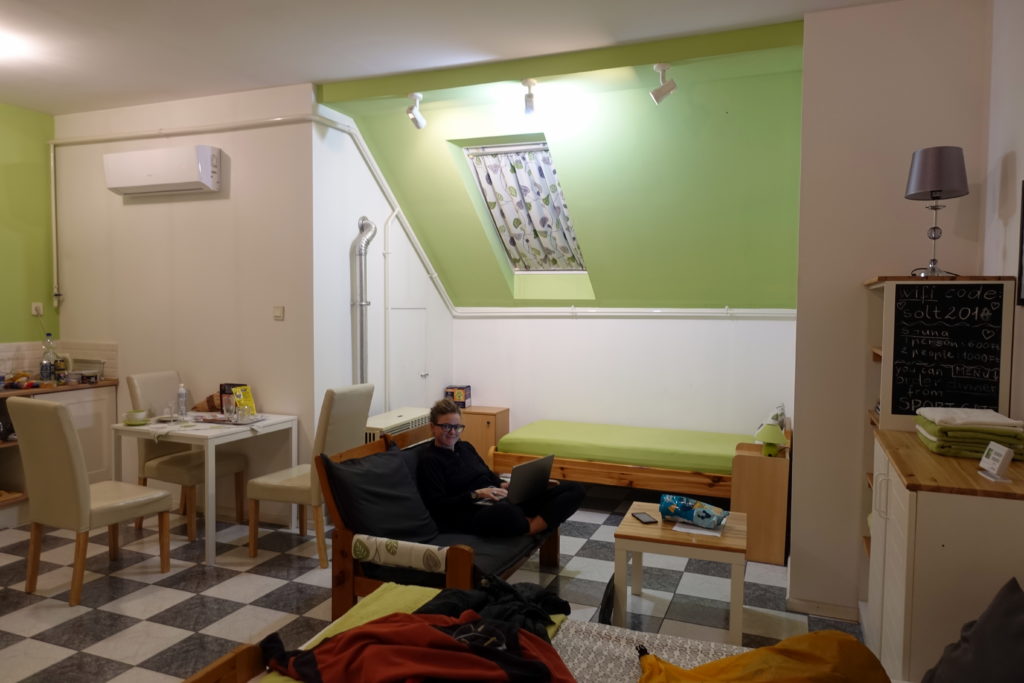
For the next two days as we rode towards Budapest, the weather didn’t improve – it remained cold, gray, and rainy. Out of Szekszárd, we rejoined the Danube and crossed onto the east side and followed the mix of bike lanes and roads into the capital Budapest. We attempted to stay out in the rain when biking wasn’t necessary, so we cycled non-stop to an indoor place for lunch, and then again to the apartment for the night. Nothing very exciting on those flatlands, more and more traffic getting closer to Budapest, and as usual the chaotic and totally uninteresting suburbs before finally reaching the much more bike friendly capital of Hungary. When we arrived at our place to stay, we somewhat felt bad for bringing soaking bags and clothes into the room, but… oh well, we needed a place to stay – and we tend to have less remorse in large hotels than guesthouses or B&Bs (and we are super cautious when invited or Warmshowers!). As we arrived into Budapest, we followed a bike lane along the Danube and into the heart of the city. It was nice to see grand buildings pop up out of the more modern suburban dwellings as we approached our hotel for the evening.
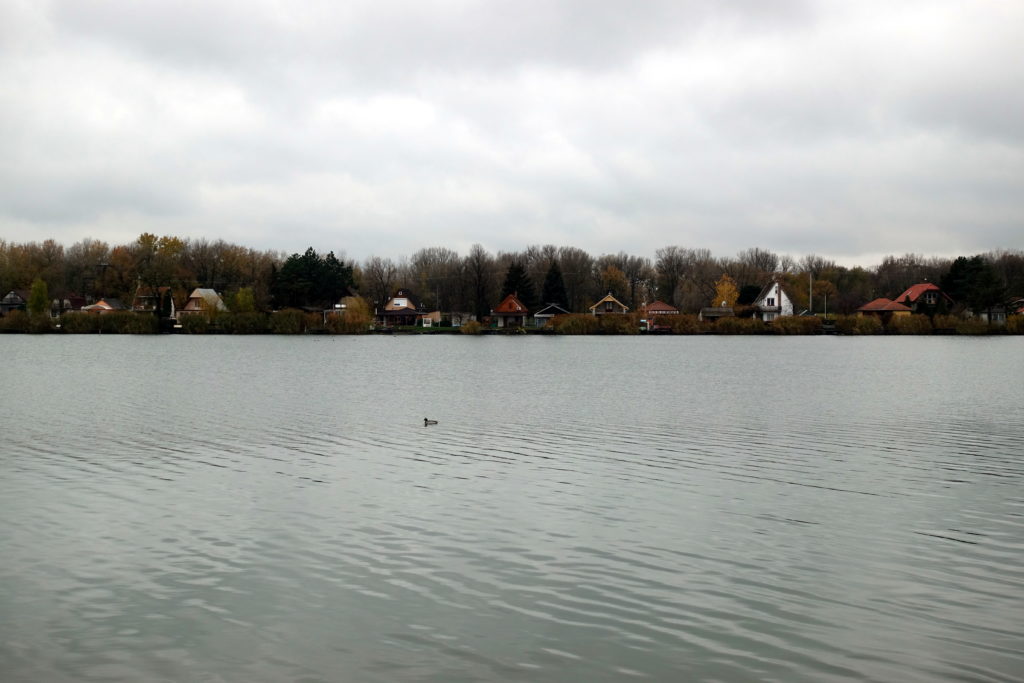
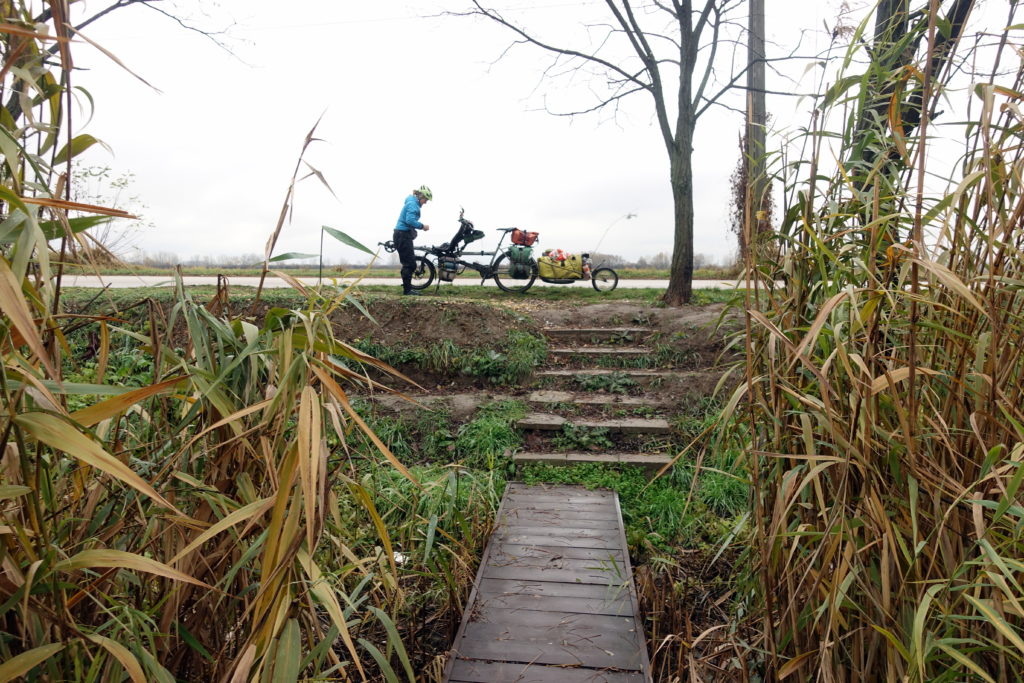
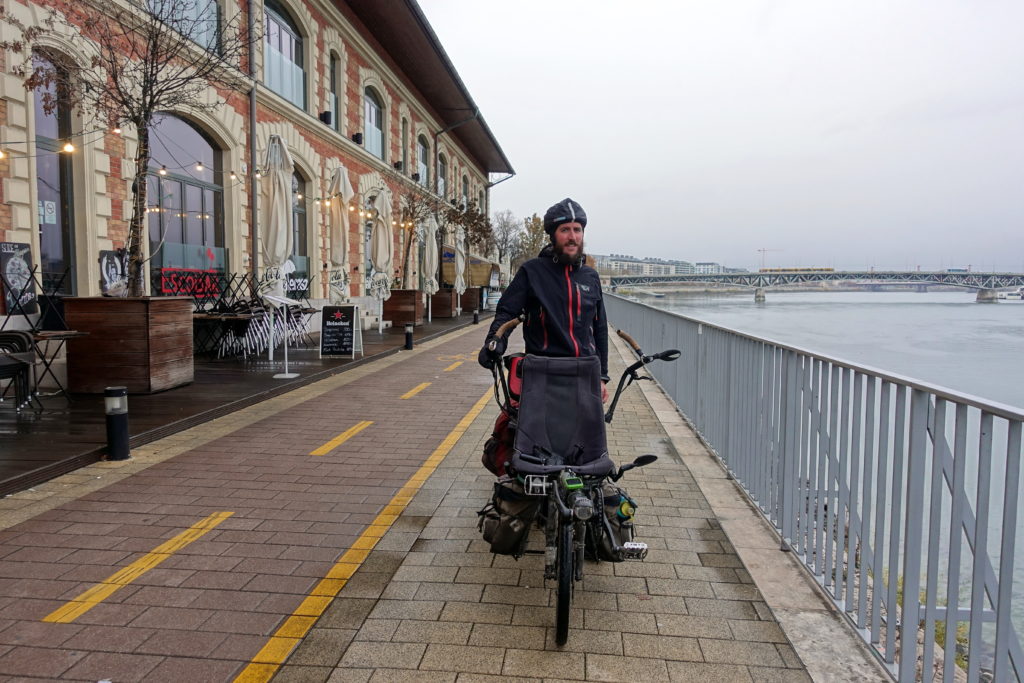
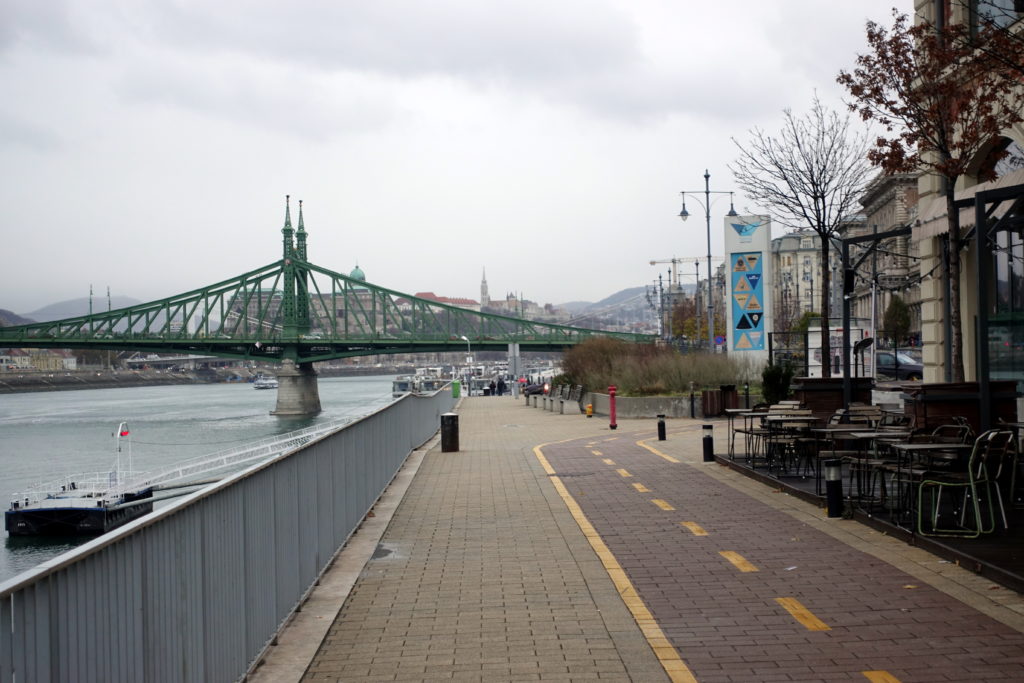
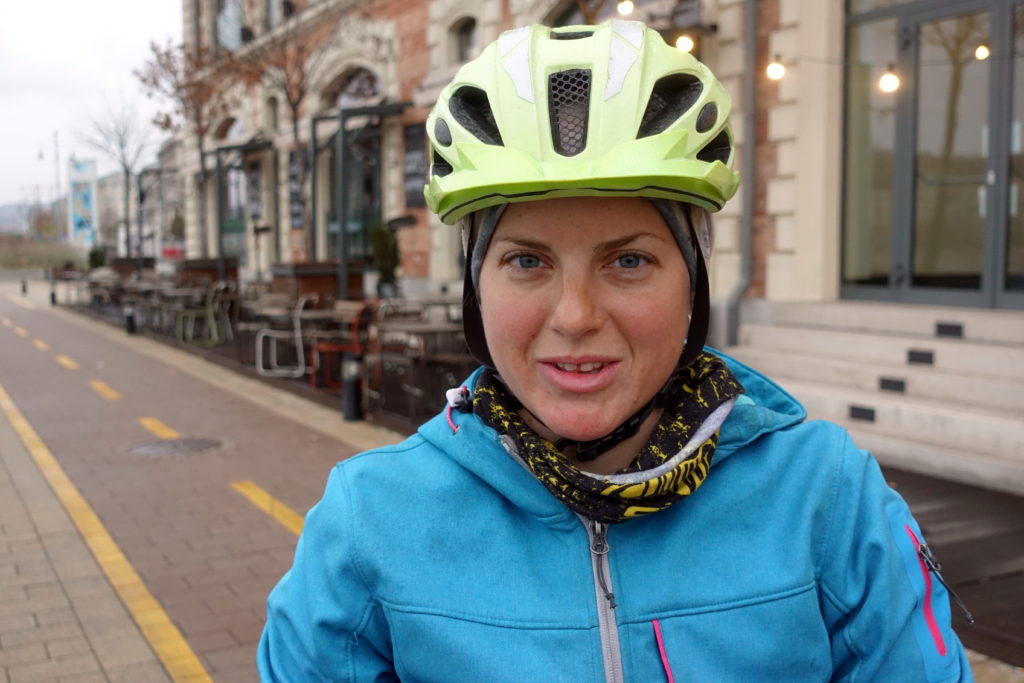
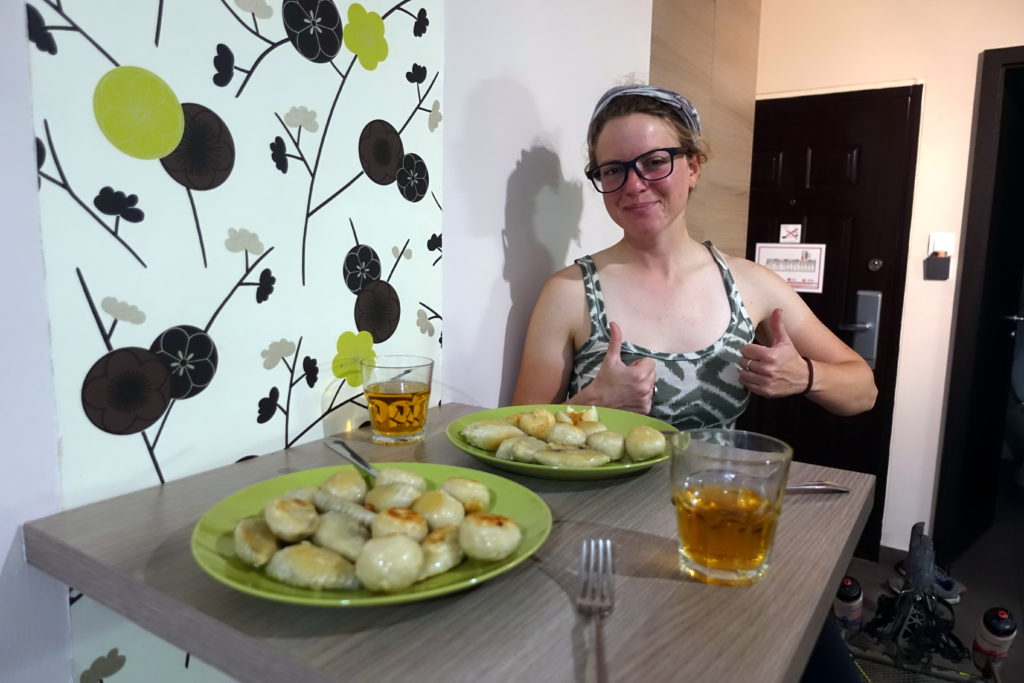
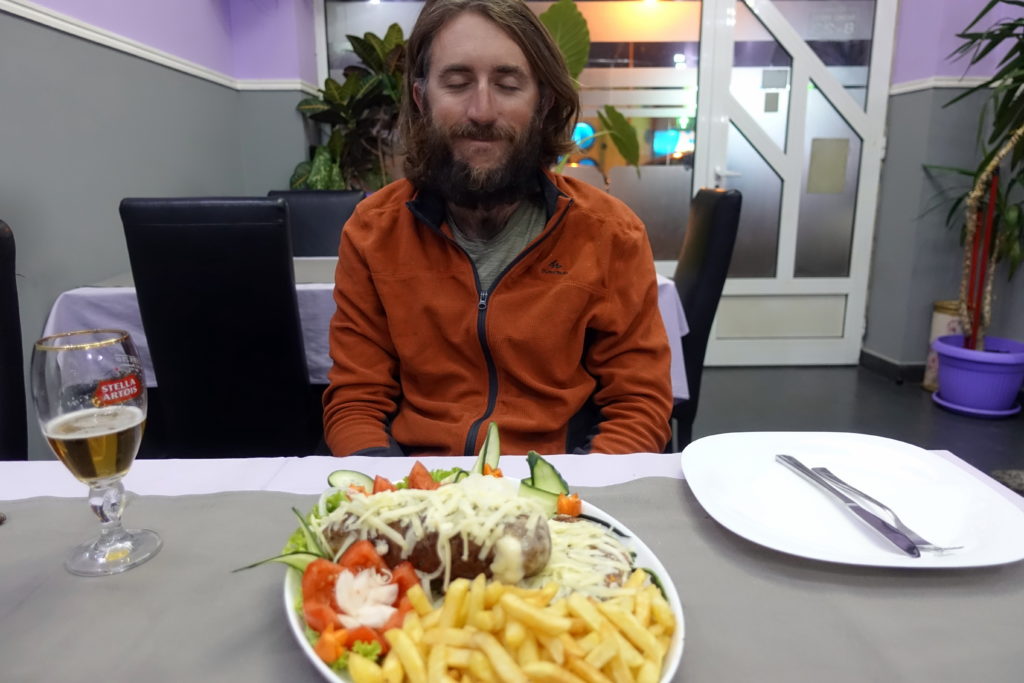
A real Serbian Hamburger (tons of cheese, a billion calories, and no bread – because who needs bread anyway? and even more cheese stuffed inside of the burger)
The next morning, Cédric and I were treated to another Serbian breakfast (this time a plate of charcuterie) before heading off on the bike. The weather had turned grey and our spirits were a bit low – so to avoid camping outside, we decided to make the day short by cycling to the next biggest city as towns are relatively sparse in this area of the Danube: Zajecar. Instead of riding a usual day length, we went into the backcountry and visited an ancient Roman complex about 10 kilometers outside of the town. Without many breaks, we arrived in Zajecar in the late morning and dropped all our things in the room before heading out to Felix Romuliana, a Unesco listed heritage site. Cycling with an unloaded bike was a nice change and we noticed that we were just slightly faster when going up hills. We wandered around Felix Romuliana for some time, climbing over the foundations of the old palace and temple and peering around old complex walls. Because we still had time to spare, we also cycled up to the two mausoleums of the Roman emperor Galerius and his mother, Romula. We cycled back to Zajecar that afternoon and spent the rest of the day looking around the small downtown and treating ourselves to another Serbian meal.
In the morning, we left the city and continued north. In order to cycle through the ‘Iron Gates’ portion of the EuroVelo tracks, we needed to get close to the Romanian-Bulgarian-Serbian. Since we weren’t yet on the riverside, this meant cycling over a few more hills. The morning was crisp but cycling up and down the countryside warmed us up. Due to a lack of grocery stores or restaurants along the way, Cédric and I had to make do with gas station food for lunch, dinner, and breakfast. To add to the glamour, we ate our lunch (remaining bits of bread, spread, chips, and Coke) just outside of the shop’s doors. We continued cycling along quiet country roads that afternoon and enjoyed the remaining bits of sunshine. As the sun began to set, Cédric and I decided to spend the night camping since we were unsure of hotels in the nearby area. Using Google Map satellite view, we found a place with empty, self-made cottages along the Danube. We quickly pitched the tent before dark and then got in our sleeping bags for the remainder of the evening, i.e. after dinner at 5pm because it gets dark after 4:30pm – one of the benefits of staying in hotels or guesthouses is not having to huddle in a sleeping bag for hours before we fall asleep.
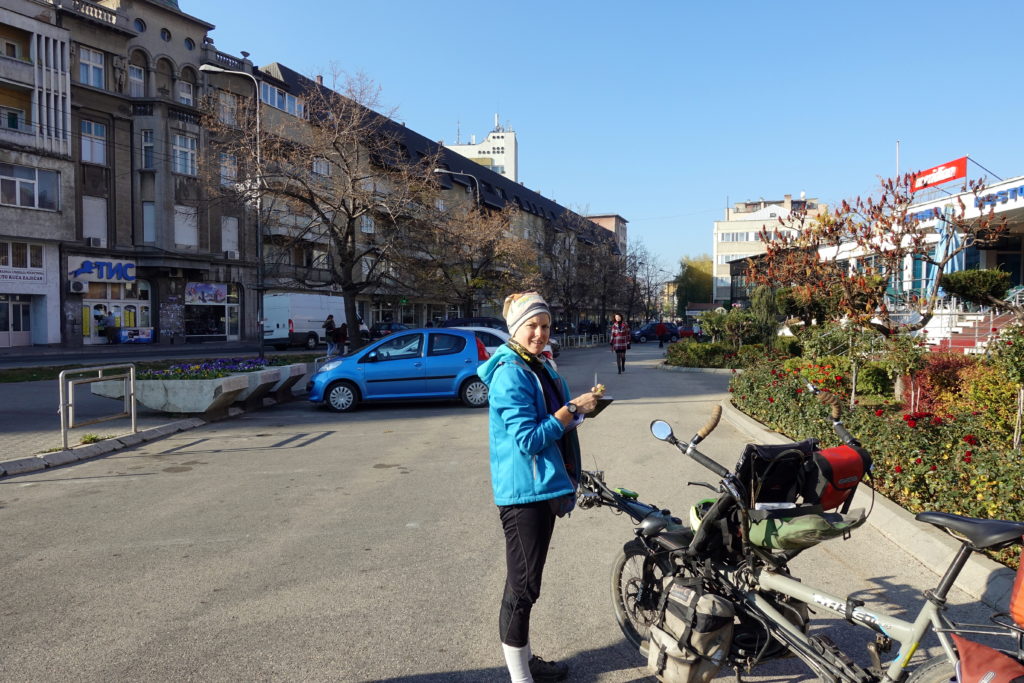
Cities aren’t necessarily much more beautiful in Serbia than Bulgaria, but the big difference is that they feel a lot livelier and not like ghost towns on the other side of the border.
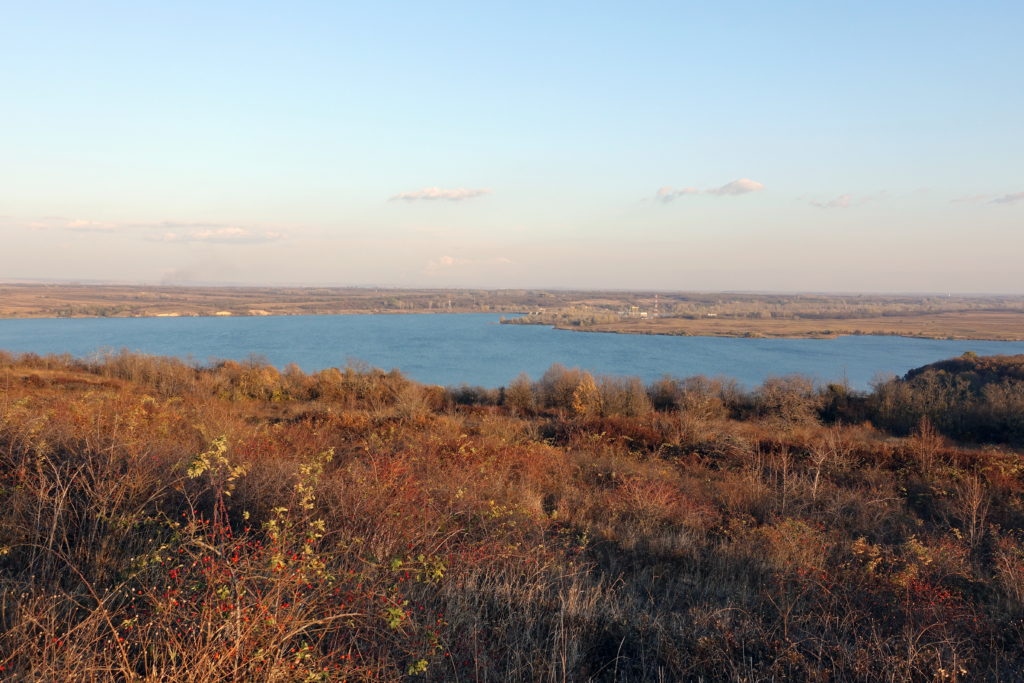
Romania on the right side, Serbia on the left – that was also a heavily guarded border between the Soviet block and Yugoslavia a few decades ago.
We woke up the next morning to cold temperatures and grey skies. It seemed like the bad weather caught up with us. Just as we were disassembling our tent- it started to sprinkle, so we rushed to pack our things before more rain came. It was still raining when we started cycling on the road, which didn’t make the cold morning any more enjoyable. We cycled over our few last hills before reaching the Danube route in Kladovo. There, we stopped for a hot chocolate to warm our fingers and toes before heading west on the Danube River. Finally, we thought, we’re homeward bound. If we continued following this river, we’d reach Donauwörth, which is just a few dozen kilometers north of Augsburg, a few more hours along the Lech river and we’d be back home. We continued for a few more hours before stopping for a lunch of fish soup and more grilled meat. The weather never improved throughout the day, but we enjoyed the views cycling between the Danube and the rocky cliffs of the Iron Gates gorges. In the late afternoon, we made our way to a guesthouse and turned the heaters on full blast to warm up our frozen bodies.
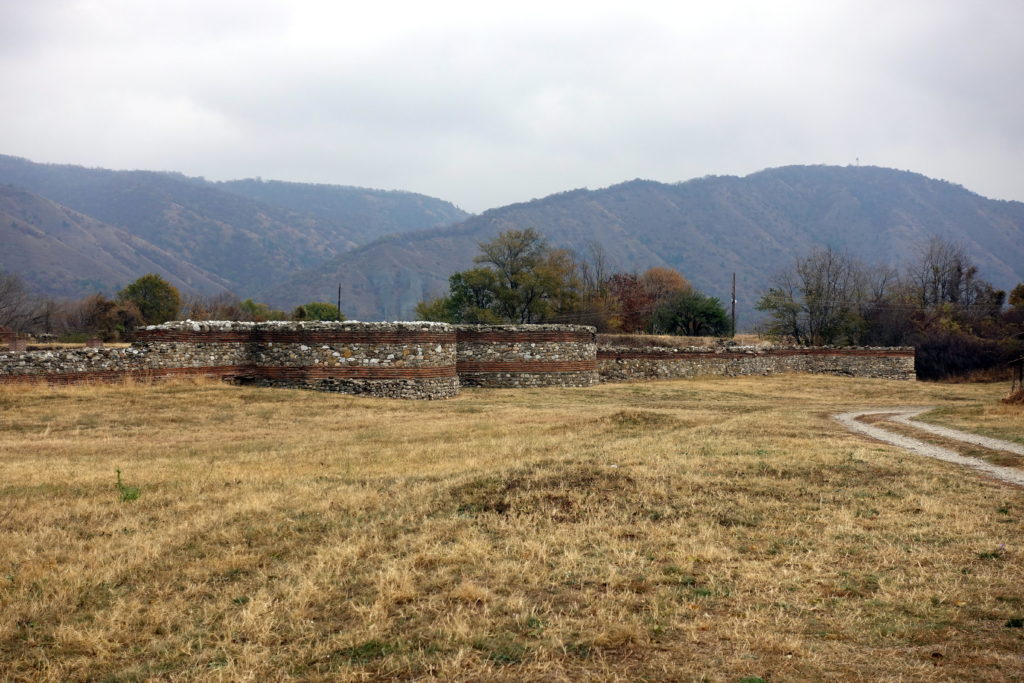
The Diana Fortress, a Roman fortification – the Danube being along most of its length the northernmost border of the Roman empire.
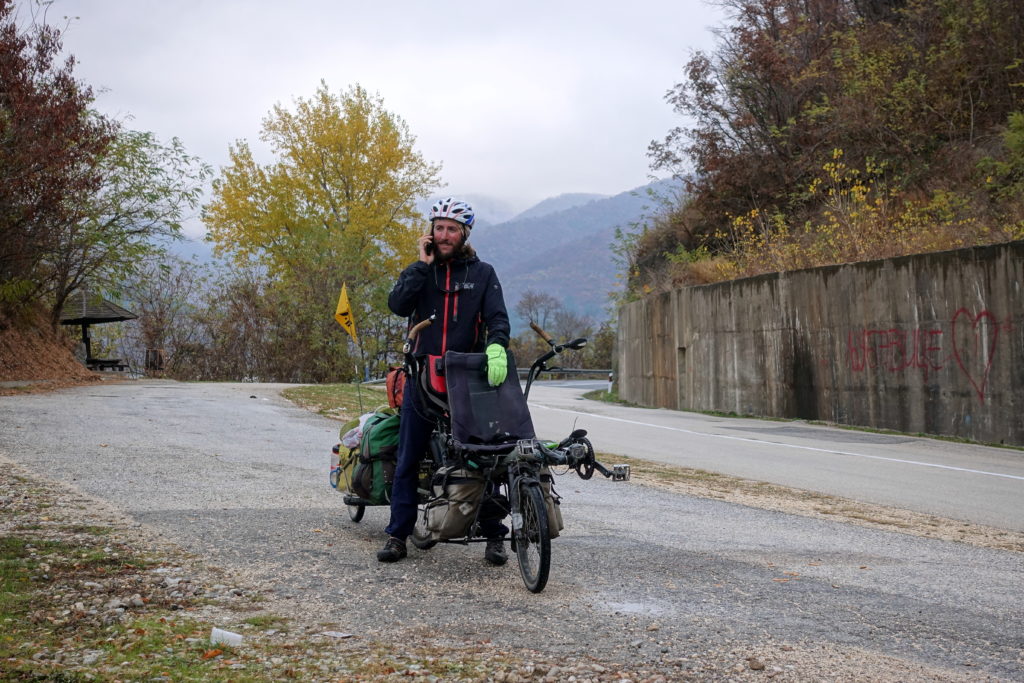
Cedric Bizinessman (probably trying to figure out if an accommodation for the night would accept our Iron Horse)
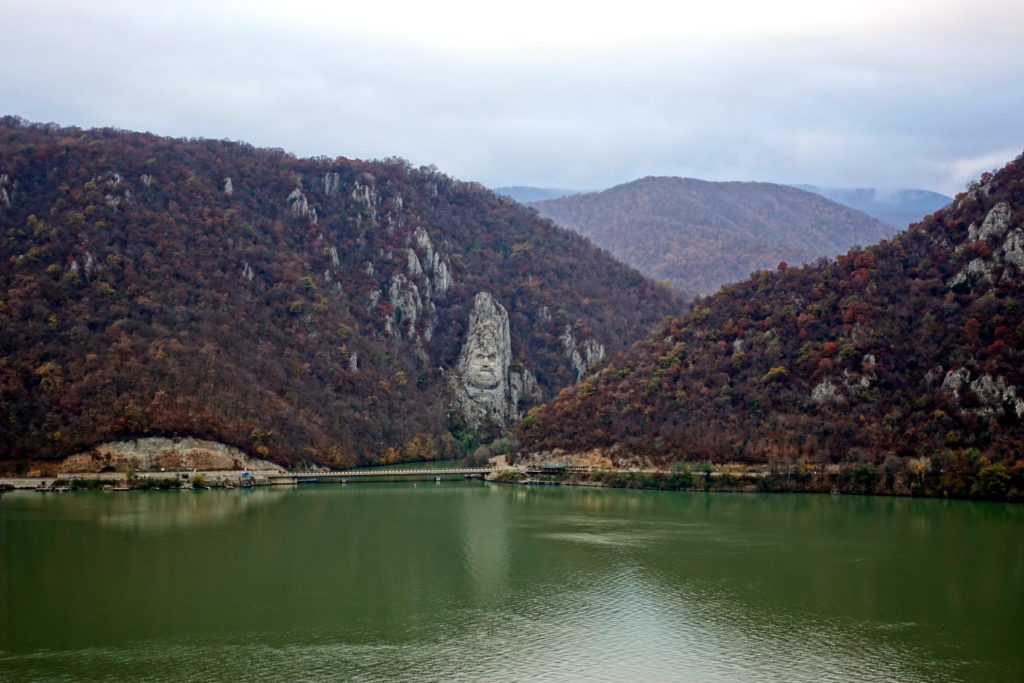
Famous rock carving of Dacian (Roumania) king Decebalus. He is still a national hero in Roumania after two millenia for daring to fight against the Roman Empire.
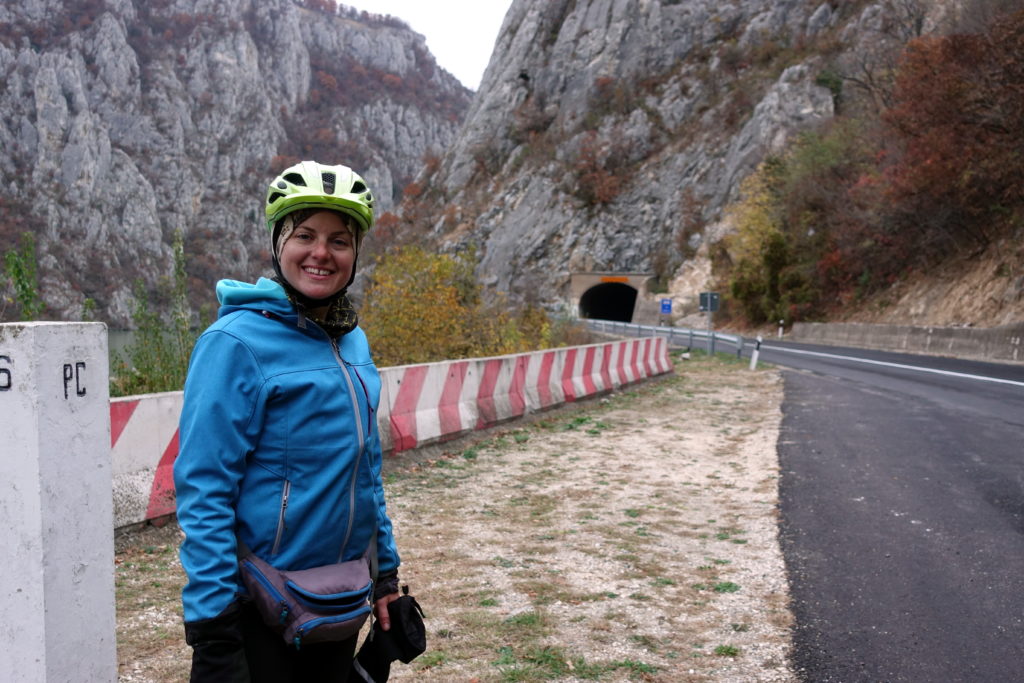
Luckily the road goes through tunnels! Our maps had us go up and down all day with crazy inclines… we just went through the mountain easily!
The cold weather hadn’t improved much overnight, it was still near freezing and grey, but we luckily had no more rain, only a lot of humidity from the large Danube river. As we prepared for the day, we put on our warmest clothes and hoped for the best. For the first hour along the Danube, we cycled past empty vacation cottages and small villages. We stopped quickly in Donji Milanovac to pick up some lunch supplies – although our current approach to keep warm includes indoor lunches, we can’t always expect an open restaurant to appear around midday. November is apparently also not the favorite season for tourists to come to this popular area, so a lot of businesses are running either very slowly or simply close for a few months.
After we left the village, Cédric and I had to cycle up one large hill – it was nice to have something warm us up, but we knew that the descent would be bone-chilling cold – it became clear that more than the weather itself, getting dressed appropriately according to the terrain was more tricky: a flat road is easy to manage, but ups and downs are a succession of over-sweating and over-freezing. At the top, we sought refuge in a bus stop to eat some cereal bars and try to hide from the wind to warm up our toes. On the long descent down, we passed through 20 small tunnels, all between 50 and 200 meters in length – which made the road like some Emmental cheese along the tunnel – and a big relief as our phone mapping application did not know these, and was showing us an infernal way going tens of times between the shores of the river and the ridges of the canyon. We could now see the end of the Iron Gates and as we approached our destination for the day in Gobulac, we went into another tunnel under the scenic and famous Gobulac fortress. We ended our day in an apartment in the town of Gobulac, enjoying deals of the low season in a normally crowded town, and again spent a few hours just warming up and drying of our stuff at the end of the day.
The Iron Gates area of the Danube had been an awesome ride the previous few days, with little traffic and dramatic views over this rugged part of the Danube (possibly the only one over its 3000+ km). Although pretty much following the river, cycling was quite hilly (nothing like Central Asia, but still never flat!), and the next following days would be much easier in plains heading to Belgrade.
The next morning, we set out in the direction of the Belgrade. Since our Eurovelo 6 routes for the day were a combination of dirt tracks and ferries, we decided to develop our own route instead. In the summer, this would have been fine, but the infrequent (or nonexistent in winter) ferry crossings and sticky mud made us decide to stay along the south side of the river. The morning was pleasant as we rode through small villages, but a few hours into the day we started to climb up and down a few large hills. Since it was the weekend, we also spotted a few guys hunting on the side of the road and hoped that we were colorful enough to not attract bullets! In the afternoon, we cycled through Pozarevac and made our way west. With the increased amount of traffic around Belgrade, the ride was becoming unenjoyable – the roadside was no longer quiet and we had to continuously check our mirrors. Just as we were finishing our last few kilometers into Smederevo, the light rain turned to sleet and snow, so we cycled as quickly as we could to our hotel.
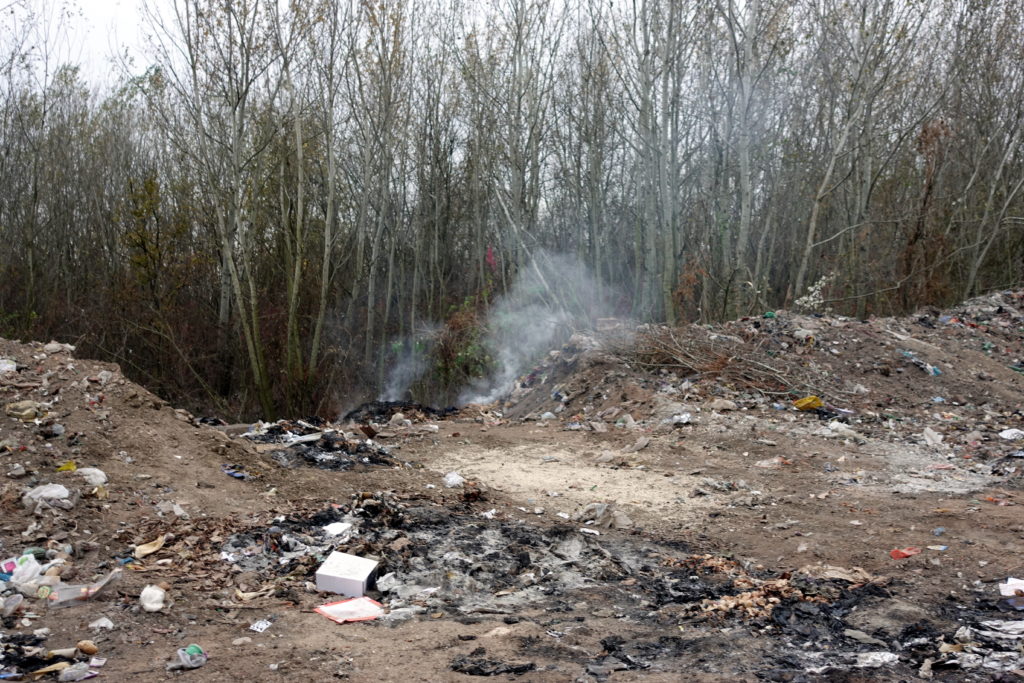
Ah… a usual sight in the outskirts of towns in Serbia. Trucks just dump their stuff incognito near the forest.
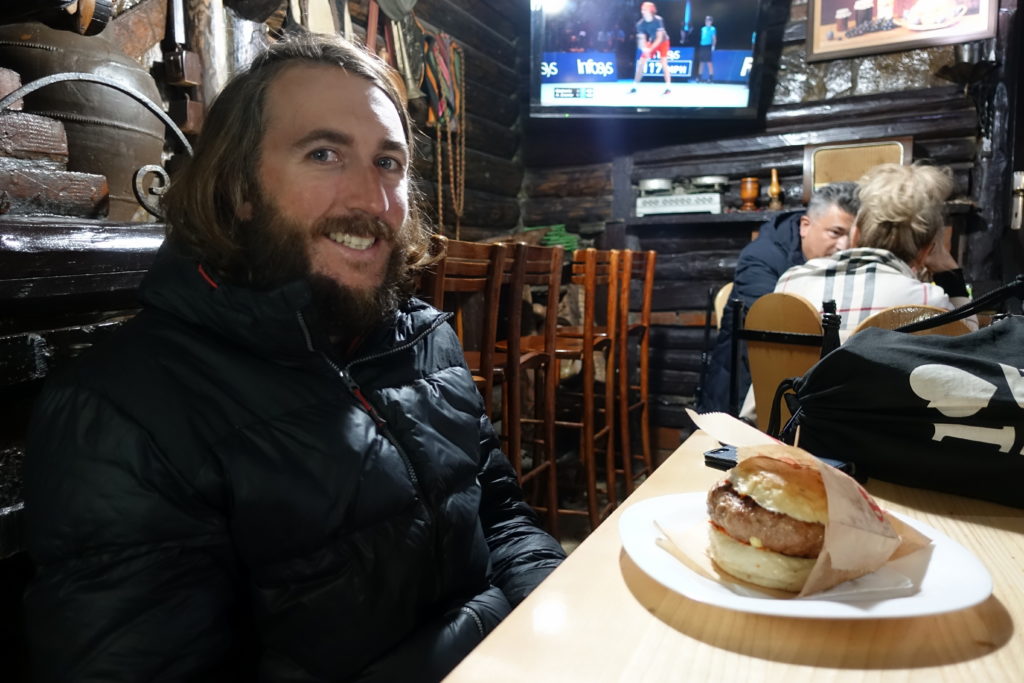
We swear that nothing else was open on Sunday evening! We got lucky to have a hamburger with bread, the normal one has been simplified to just meat (the Pljeskavica): who needs the other stuff anyway? Also a local specificity is that the meat is actually stuffed with a big block of cheese inside… Almost quite not over-caloric!
Note in the background the national tennis star Djokovic being wrecked by some new young player…
When we awoke the next morning, the clouds were clearing up, and the dusting of snow was melting. The day was still cold, but we’d be able to make it into Belgrade. As we left Smederevo, we stopped to look at the old fortress, although not as picturesque as the one in Golubac. We crossed to the north part of the Danube and started following the EuroVelo 6 signs towards Belgrade. Luckily, we were able to find some quiet roads which made the morning’s ride through farmland and villages more enjoyable. Seeing that we weren’t going to make it to Belgrade before the late afternoon, we stopped in downtown Pancevo for a pizza lunch (I had been dreaming about pizza for the last week). In the afternoon, we continued west and decided to see whether the bike would manage on one of the muddy paths into Belgrade- it didn’t even last 1km before needing to dig out all the mud from the wheels – so we cycled along the main road to the northern bridge into the city. The bridge crossing was reminiscent of our Hobart crossing – pushing the bike for a few kilometers with traffic rushing pass us, not enjoyable at all. However, in Belgrade, the sidewalk stopped immediately after the bridge, so we needed to push the bike in the grass until we could merge onto a road. It is sometimes questionable how countries decide to build bike lanes: there are great paved lanes in the middle of nowhere near roads with little traffic, but then usually in the suburbs of large cities where roads are clearly a danger for pedestrians and anything that does not have tons of steel-shields there is just nothing but massive highways – and given the population density, bike lanes would be used much more there than in the backcountry! We navigated our way through Belgrade, a maze for cycling as roads are either forbidden for bikes, or have stairs, tunnels and multiple items making it good for pedestrians only. Okay, we aren’t going to complain much as Serbia was the first country to at least consider bicycle – but next time we are on the EV6, we will just do like Sofia in Bulgaria and keep the city 30km away. We were happy to find our hotel shortly before sunset and call it a day.
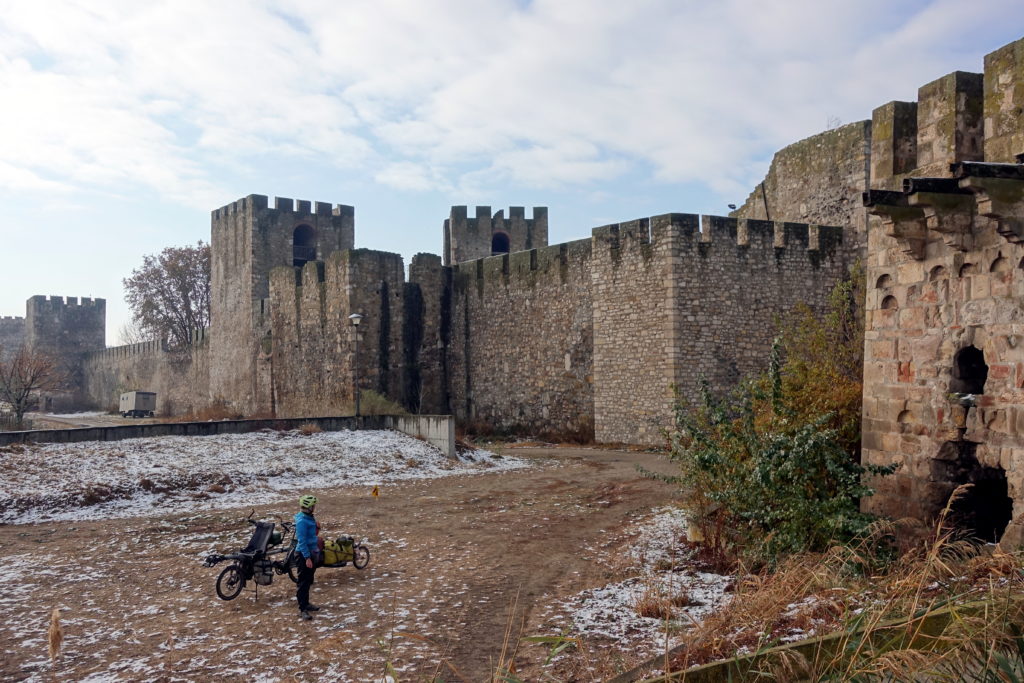
Again, the Smederevo fortress – and we were the only people interested in it at this time of the year.
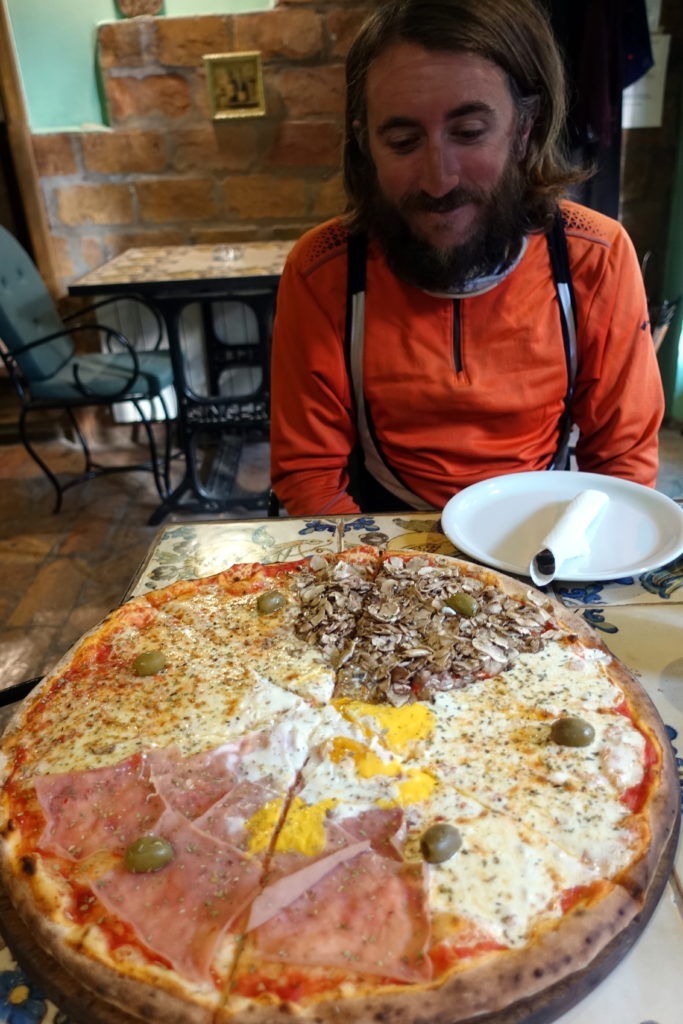
Yes, a 45cm pizza has the same amount of pizza as 2x32cm pizzas – so it’s a better deal…
And if you can’t agree on which 45cm to take, just take the Quatro Staggioni 
And also, a pizza with an egg on top is always better!
In the mid-morning, we cycled through the city of Drama and collected a few things necessities for our travels (Lidl groceries and contact solution). After we left, we continued down the busy road, sharing it with numerous marble haulers, nothing very interesting on the way, no view over the sea and few archeological sites. However, once we turned towards the border, the traffic eventually thinned out to a trickle, but some marble trucks were still present. The way towards Bulgaria is a never-ending ascent bringing us from sea level to the base of the Balkan Mountains 600m higher. We had an unglamorous picnic lunch on the side of the road due to the narrow valley and then continued our slow climb up towards the border. Cédric and I were surprised to find an actual patrolled border between the two countries since they were a part of the EU – we discovered on the spot that the Schengen Area does not yet comprehend all EU states – link about Europe). Because it was getting close to sunset, and that the border waiting time was not planned, we had to quickly cycle the last 10 kilometers to the nearest hotel racing with the sunset. The problem with cycling in autumn and winter has actually been mostly about the length of the days. We can deal with rain, cold or snow by playing with the number of layers – but finishing 80 hilly kilometers before 4pm is getting increasingly difficult.
Here again, a mere border crossing unveils stark differences between countries. Greece still felt industrial and modern (comparatively), whereas the first village we passed in Bulgaria looked completely in ruins. Cedric said shortly before the border that the image he had of Bulgaria was being the worst country of anything in any EU country ranking. We were at first surprised by the quality of roads after the border (EU funding…), but we quickly came back to reality at the first village: half of the buildings abandoned, nobody in the streets, not a shop, … We had luckily marked a hotel to spend the night and reached it quickly after getting a few supplies at the gas-station, the only place open in the surroundings. Given Bulgaria’s criminal reputation, and the refusal of the hotel to lock the bike inside, we tried to hide the tandem on the terrace under the tent tarp and got nervous that someone would get interested in our ride – not sure if that was justified, but that was the first time this year. Our bicycle been a little weird, especially with the trailer, we hope that this is helping to repulse any temptations (together with big locks).
The next morning, we were happy to see that our Hase Pino was left untouched overnight. We ate our breakfast in the room and then prepared our bike for the day’s ride. As we started down the road, we noticed that there was significantly more traffic than Greece – and wondered whether this car fanaticism (particularly with German cars – rarely glossy new but the logo is what matters the most apparently) had something to do with the post-Soviet states (Eastern Bloc included). We made a quick stop in Gotse Delchev to get some Bulgarian Lev (we were sad to not use the Euro anymore) and take a peak at the town. A few kilometers down the road, the traffic started thinning out and we began following a river valley. Compared to the day before, we had sunny skies and beautiful views of the hills around us. We continued following the Mesta River valley for most of the day, enjoying the warmth from the sun when we weren’t in the shadows. We were only a few days away from the coast of Greece, but the temperatures were clearly no longer that clement in the mountains, and although the days were enjoyable during the day in the sun, we had to adjust in the morning, the afternoon, or whenever in a deeper valley and shadow. The further up the valley we cycled, the more apparent it became that we were in a ski region, with advertisements about winter getaways lining the roads, and we felt lucky that the weather hadn’t turned snowy yet. In the late afternoon, we reached our hotel in Razlog and were treated to a nice hamburger dinner (grilled meat is still on the menu – hamburgers in south-eastern Europe are usually just ground-meat, without the bread). The region around Razlog seem to be busier in the summer and winter, but at that time of the year we felt like being the only tourists they had seen in days, in towns that were half-empty.
The next day, we continued our journey through the Rila Mountains in the frosty air. We only had to climb a few kilometers in the morning to reach the pass, and given our several layers, we broke out in a sweat once we reached the top. The fast descent down to Simitli in our damp clothes was chilling – and we had to make several stops to warm our extremities. We were hoping to find a café, so we could warm ourselves up, but the town seemed desolate and we decided to continue cycling to the nearest restaurant. Come lunchtime, we came across a Serbian restaurant where I had to plead with the waiter that, no, in fact I did not want grilled meat, even though it was the restaurant’s specialty. This also gave me little hope that Serbia would have a different cuisine. In the afternoon, we continued cycling along the secondary and tertiary roads.

Saying goodbye while it’s freezing in Razlog. Our host, having lived in Switzerland was one of the rare talkative people – the hotel was yet largely empty. Note the official Bulgarian dress-code: tennis-shoes and tracksuit (usually three-striped Adidas, sometimes even four-striped Adidas, chinese-striped if you can’t afford it, or with a soccer logo if you want to look different!). Also to be noted the necessary German car, with a few hundreds of thousands of kilometers…
There was a considerable amount of traffic although we were parallel to a main highway and I started wondering what was more practical for cyclists – a road with no shoulders and moderate traffic (and speed) or a highway with ample shoulder and faster speeds. Though we were relieved to see that we weren’t so crazy when a road cyclist passed us (and snapped a picture of Cédric wearing his suspenders on top of his sweater). We had seen much worse traffic and drivers in previous countries, and Bulgaria is not too densely populated so actually not too bad for cycling, but we just don’t fancy too much spending more time looking at other vehicles than just enjoying the views. Towards the end of the day, we followed a quiet country road and ended our day in Boboshevo, another slightly decaying Bulgarian town. At this place, we were excited to have a place to use our camping stove, so we wouldn’t have to eat grilled meat once again.
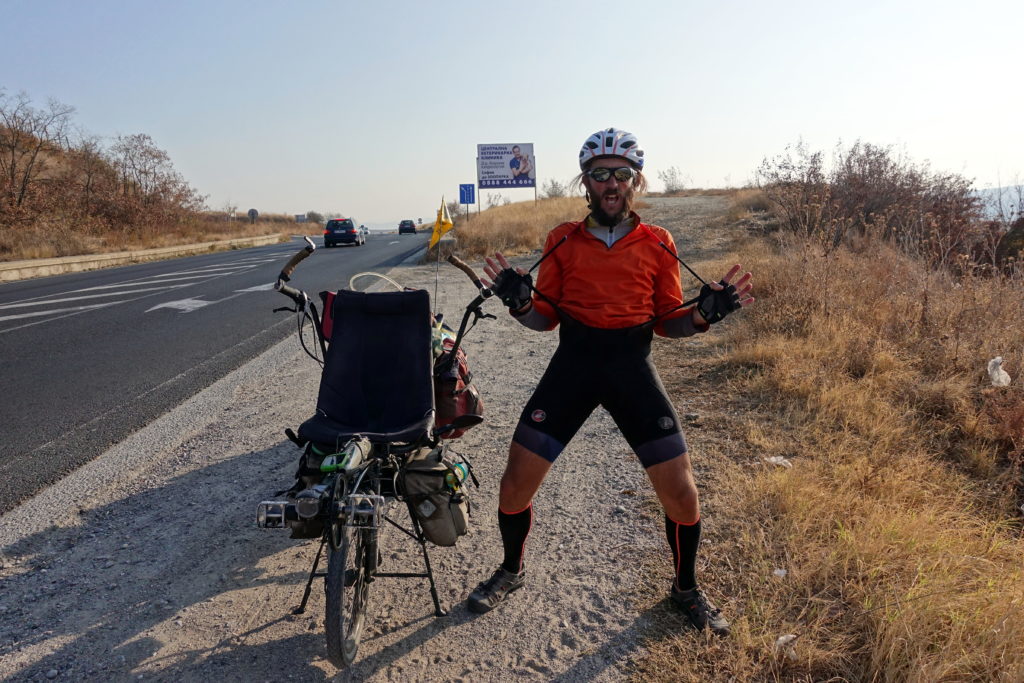
Suspender boy – cycling clothes are not practical for temperature and heat-exhaust variations during the day.
The next morning was still crisp, but not below freezing temperatures like the day before (we were now a few hundred meters lower). Having decided to avoid Sofia, the capital of Bulgaria, due to a not-favorable-enough ratio of inhabitants vs. interesting sights, we set out in the direction of the Serbian border. As we made our way through Dupnitsa, a police blockade (due to fuel price protests) forced us to wind our way through the city streets. After we passed through the city, we also noticed an extremely large number of secondhand car retailers lining the road – all sorts imported from all over the EU. Since the weather was warm and sunny, we had a roadside picnic overlooking a reservoir and the highway below. That afternoon, we cycled along back roads trying our best to stay away from traffic. Shortly before Razlog, we cycled past an abandoned industrial complex a few square kilometers in size. As we passed, we wondered why so many valuable and recyclable materials were left to simply rot and there were no apparent interventions to remediate the land. A quick look into Bulgaria’s waning population and political inaction probably explains why this complex still stands. Bulgaria clearly had a large industry a few decades ago, but whatever the problem in the country could be (demographics, education, politics, emigration etc.), the current economic state is not particularly enviable: we just felt that the only functioning businesses were about the trade of used cars, incidentally surprisingly large – every small village having several parking-retailers selling each tens (hundreds?) of cars…
Towards the end of the day, we rejoined a larger road and cycled to Pernik as quickly as possible. For our dinner that night, we decided to opt out of a plate of restaurant-grilled-meat to cook pasta instead. However, without a balcony we attempted to cook our dinner using our stove in the bathroom (it worked perfectly, good to know for the future winter weeks!).
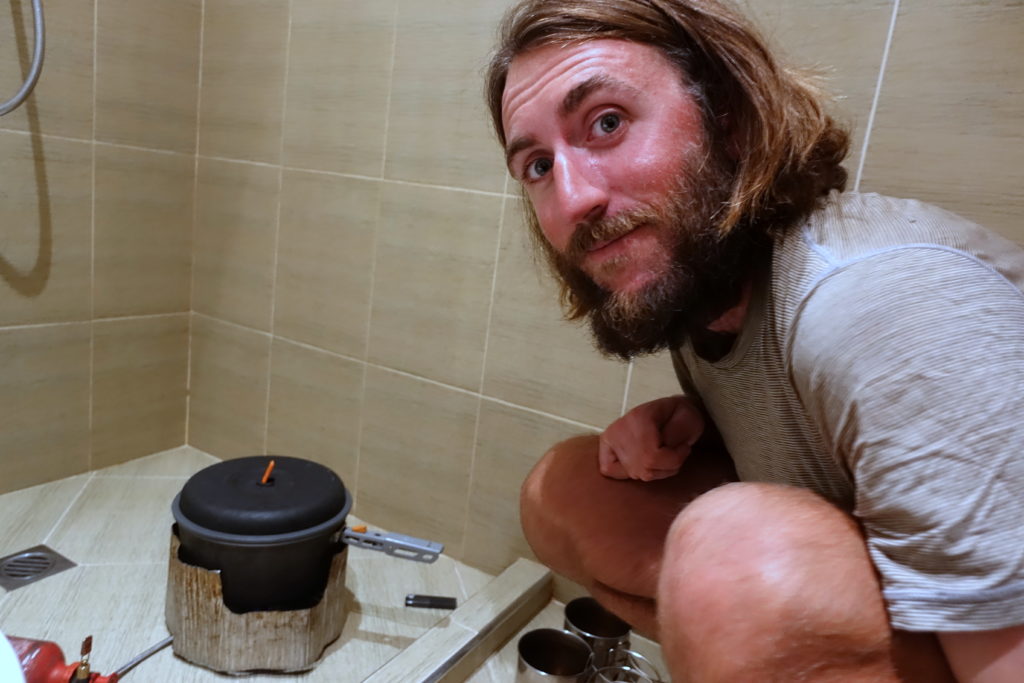
What bathroom cooking looks like – the shower for safety, the ventilation for fume exhausts, heated-water, and no grilled-meat!
We left the next morning with once again a great weather, although still with chilly minus temperatures in the morning direction our next country: Serbia. To continue avoiding Sofia and its suburbs (and the usual suburban car drivers mess), we chose a few backtrack roads that brought us into more hilly terrain and almost no traffic. We went through a few towns that were obviously not used to see many foreigners, but although not hostile, our interactions with locals felt just ice-cold: people try to avoid any eye-contact, when saying hello people look in the other direction… just weird and definitely not affable. During our few days in Bulgaria, we basically had a few exchanges with some hotel owners willing to develop tourism (but not all of them!), some Bulgarian expats living in Austria or Germany, and basically the rest of the country acting as if they just wanted to avoid us – again: no aggression (unlike New-Zealanders for example) but just icy, and although we do not speak the same language, we did not have that feeling in many other previous countries. Not sure how to explain it – other ex-soviet countries in central Asia were not like that, the other orthodox or Slavic countries around (Serbia, Greece, Croatia) neither.
We kept on going that day until the asphalt simply disappeared and turned into a trail going through the last few towns before reaching a larger valley heading to Serbia – great for cycling relax in the middle of the road, not that much for reaching Serbia before sunset. We set our goal to get lunch in the larger valley connecting Serbia and tried to get lunch there – although here again, although the town of Dragoman had a few thousand inhabitants, the place felt depopulated and the only eateries were questionable, so we ended up quickly eating some remaining snacks on the side of the road. The last 20km to the border were a surprise: the alternative to a large highway turned out to be an (almost) unused cobblestone track, the millennia old Roman road “Via Militaris”. Also, a good Paris-Roubaix training!
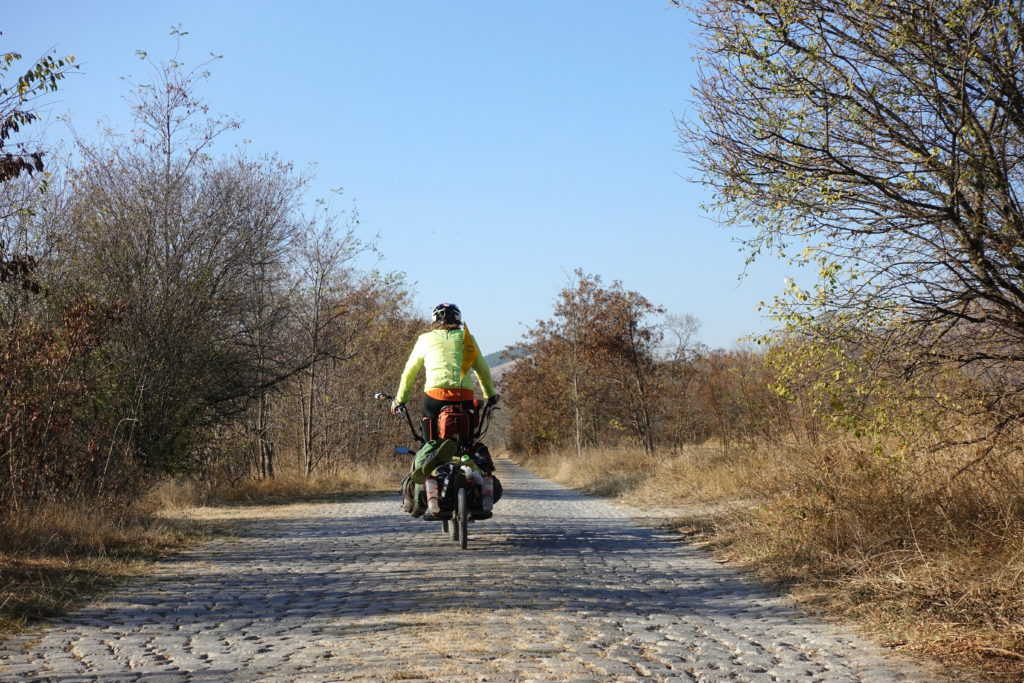
Along the old Roman Via Militaris way (a major Roman road connecting the current Belgrade to Istanbul)
After a sluggish shaking ride on that ancient track, we rejoined the main road right at the border and were surprised to see hundreds of cars queuing before the border. Not excited to possibly have to wait hours, the sunset now behind the mountains and freezing temperatures, we just decided to skip the queue on the highway and bike-pass all cars! We just need to be looking confident enough and make everyone believe that we know what we are doing, and just reemerge into the queue right at the customs barrier. The slight problem, and reason of that traffic jam, was that Bulgarian custom officers had their “shift-change,” lasting over an hour, during which they simply close the border entirely, several times per day, with little enthusiasm to hurry-up. On the other side in Serbia, the border remains constantly open – but they just must wait for the Bulgarian customs to finish their break. We had some Bulgarians living in Vienna explain us the situation, and their tone sounded like our feelings: Bulgaria is a little desperate and better consider your life abroad…
We were now entering in our 16th country this year: Serbia! Here again, a border does not change much geographically, but arriving in Dimitrovgrad we were surprised by the difference with the Bulgarian side. The town was well-arranged, tidy, lively, many shops and businesses along the main street, even some bike lanes and the first signs of the Eurovelo 13, passing through that town. We had been remotely following the Eurovelo 13 route since Edirne in Turkey, but this route exists only on the internet through Turkey, Greece and Bulgaria, as in-project-phase. We were also surprised to see many locals using bicycles around town, and an obvious decreased fanaticism for rusty-German-cars. The only downside was realizing that we changed time zones, so now the sun no longer set at 5pm, but now 4pm. Now that we were in Serbia, our upcoming goal would be heading north and finally reaching the long-awaited Danube River.
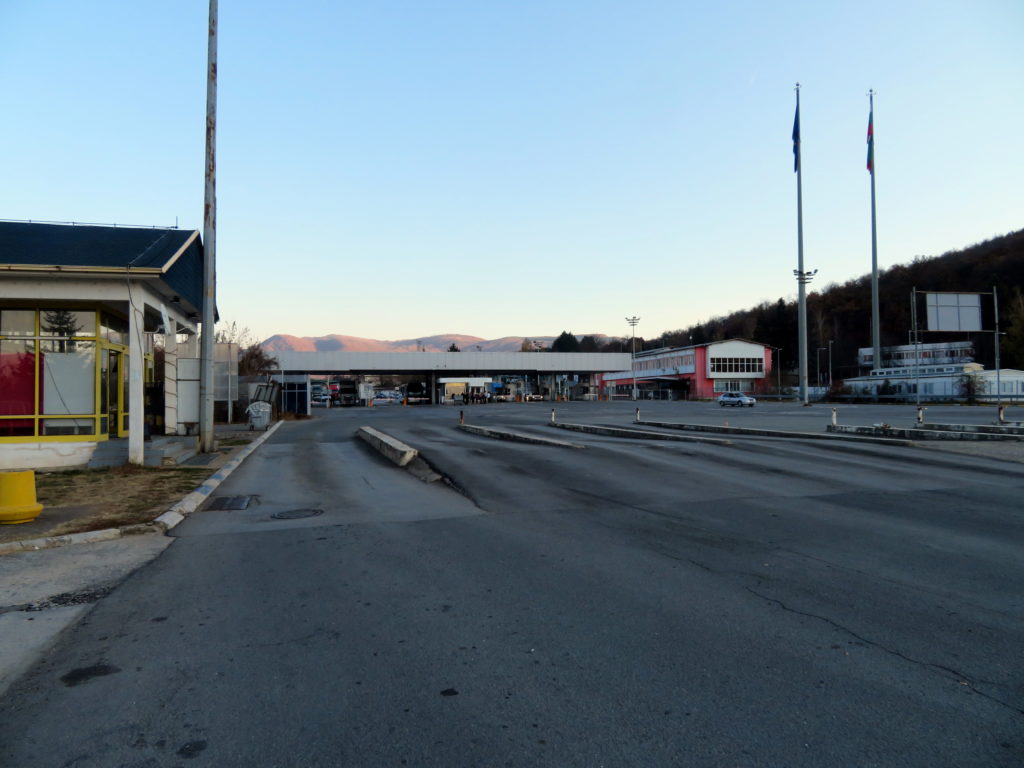
The much-awaited Bulgarian-Serbian border. We gave ourselves the right to skip the line , and confidently simply go in front of the hundreds of cars waiting for the hour-long Bulgarian shift-change… the Serbian side was easy and straight-forward (although leaving the EU).
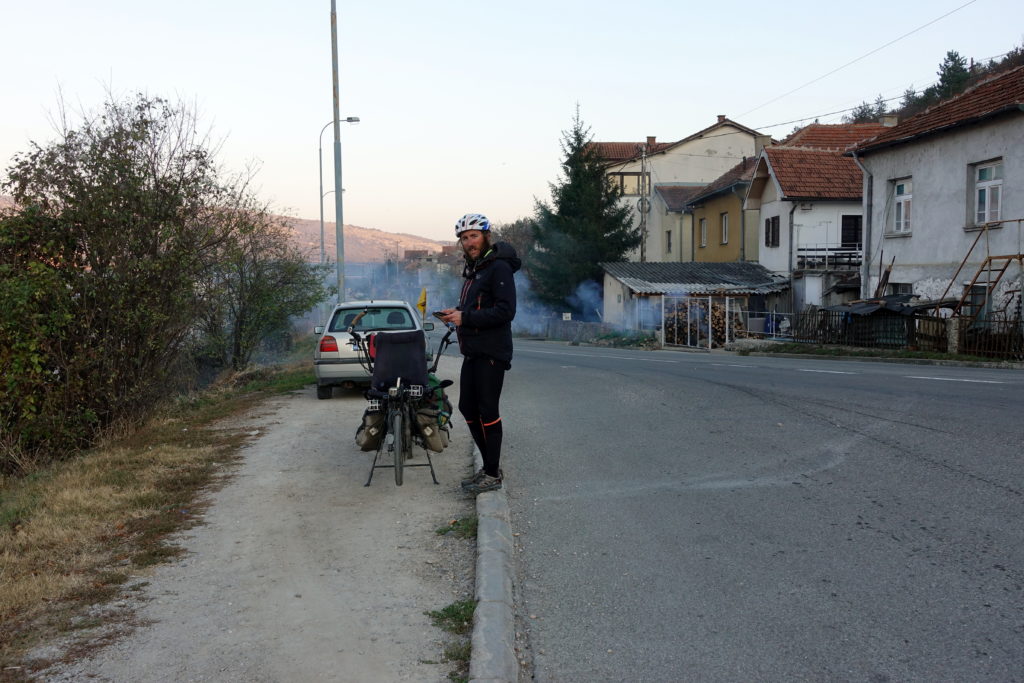
We can’t believe it’s now sunset at 4pm in Serbia. Ah, and yes, Serbia uses coal for heating – so the towns become slightly foggy in the evenings.
In short, it felt that we sort of blew through Bulgaria. We enjoyed the forested mountains and wilderness in the southern part of the country, although not being a breathtaking landscape the fall season colors made the backcountry pleasant, and the sparse population make secondary roads great for cycling (especially after EU funds financed their refurbishment). There however hasn’t been really any memorable towns or cities that we passed through – just some half-depopulated and half-decaying locations on the map where we could either find an accommodation or groceries. About locals, we just felt that we had spent a week in Bulgaria in a separate universe, no animosity or bad memories, but not many souvenirs either – we were in our bubble and Bulgarians in their own, geographically close, but humanly distant. The first country where we had such feelings, weird.
]]>